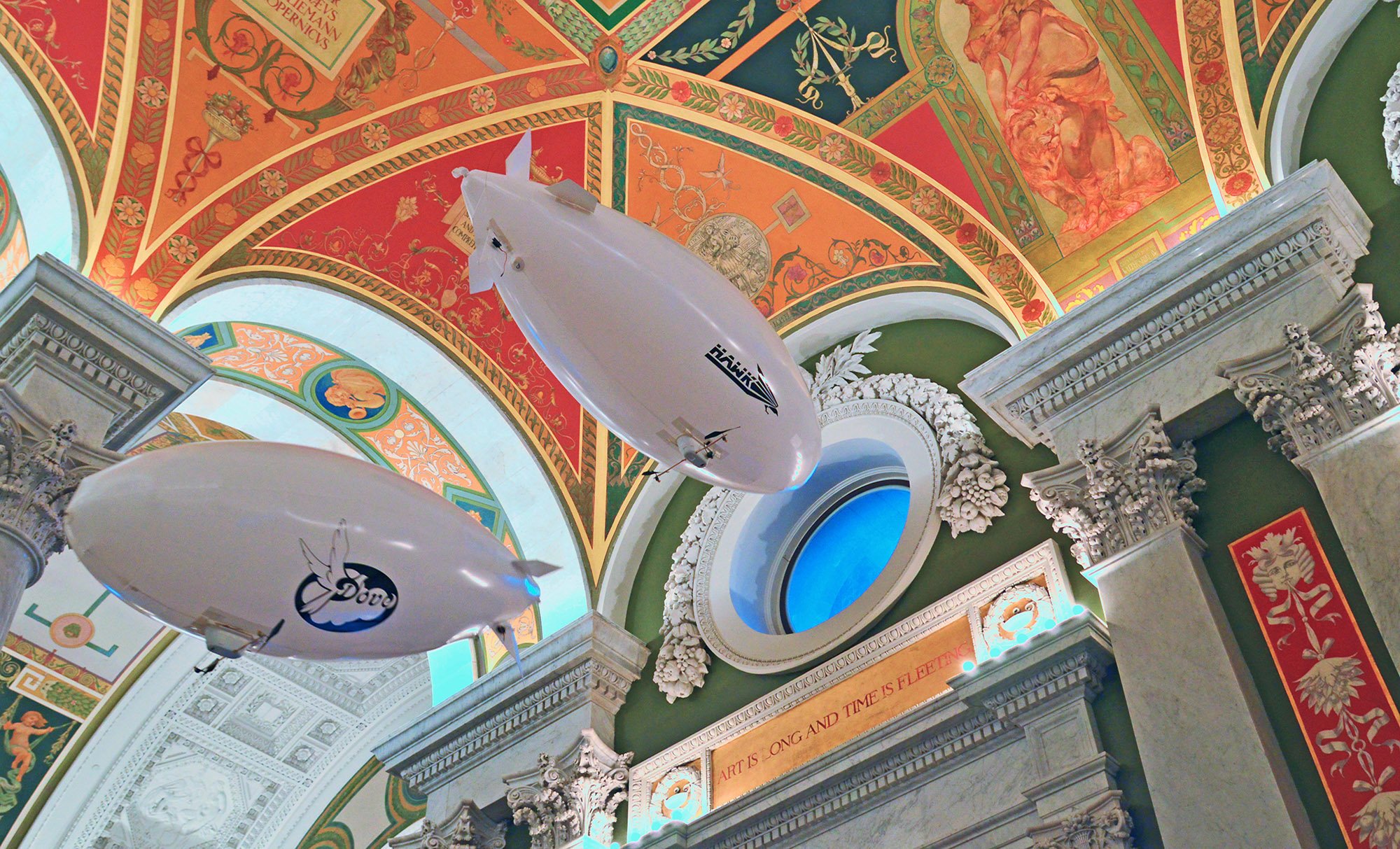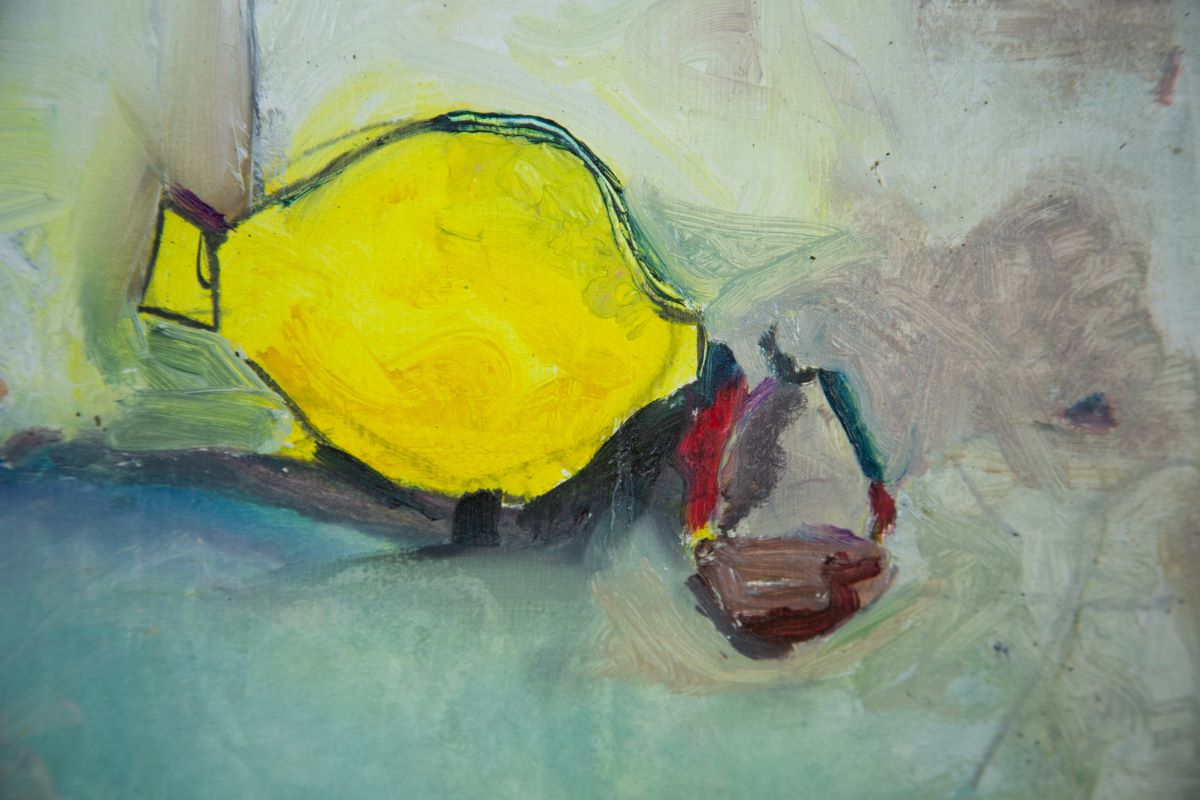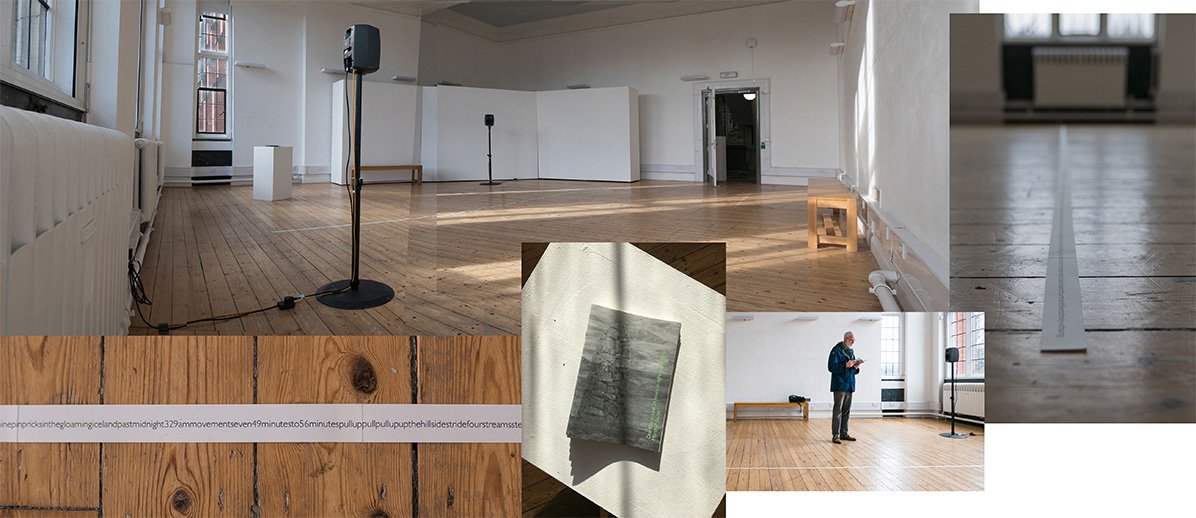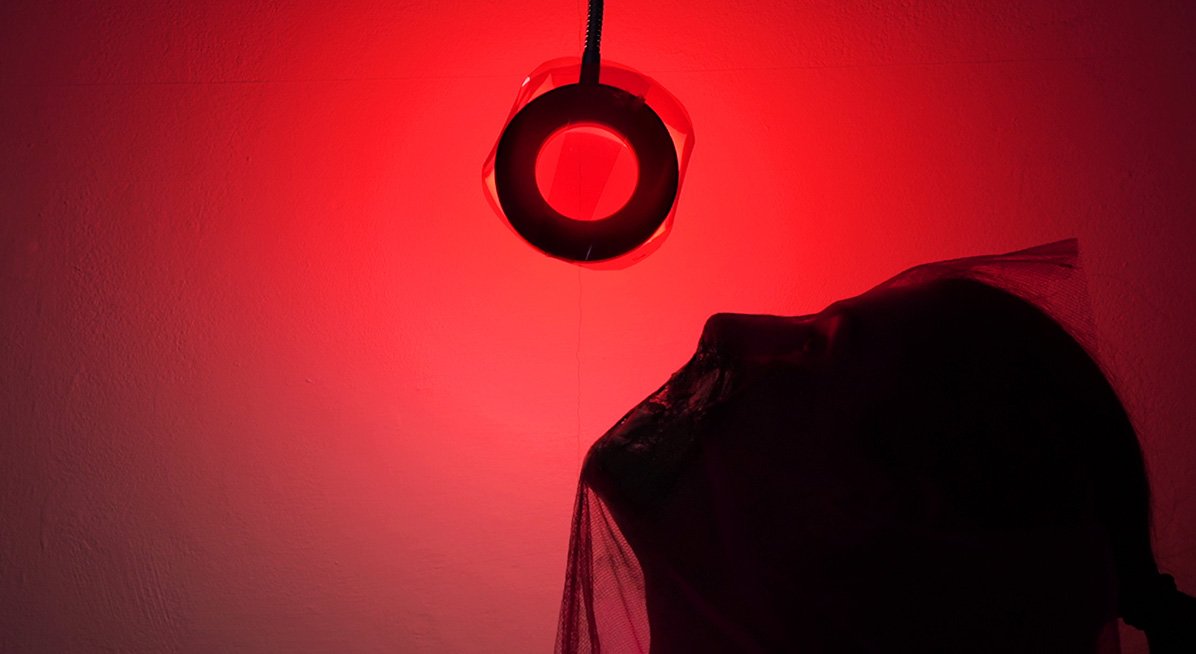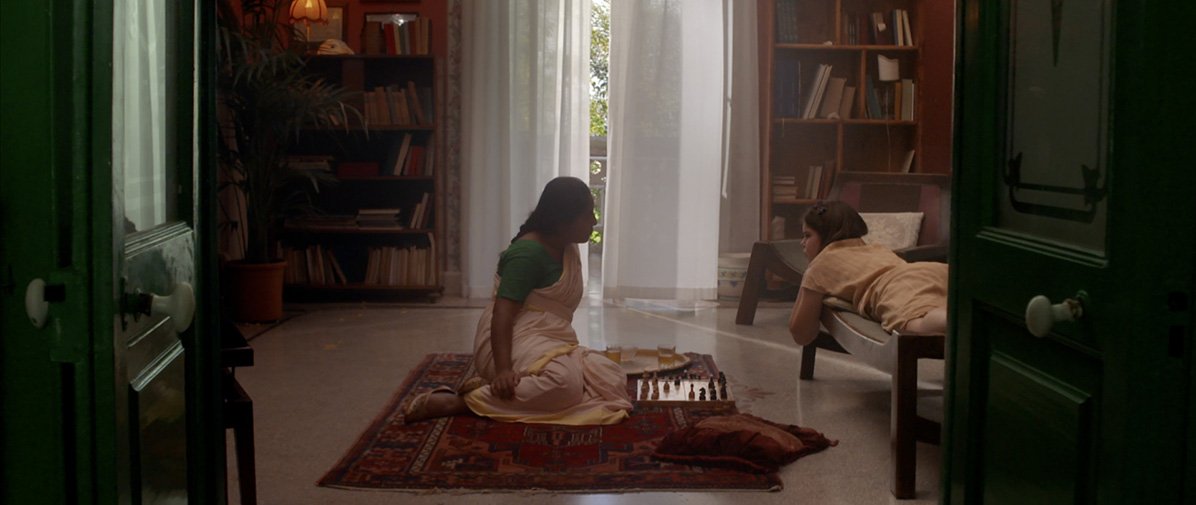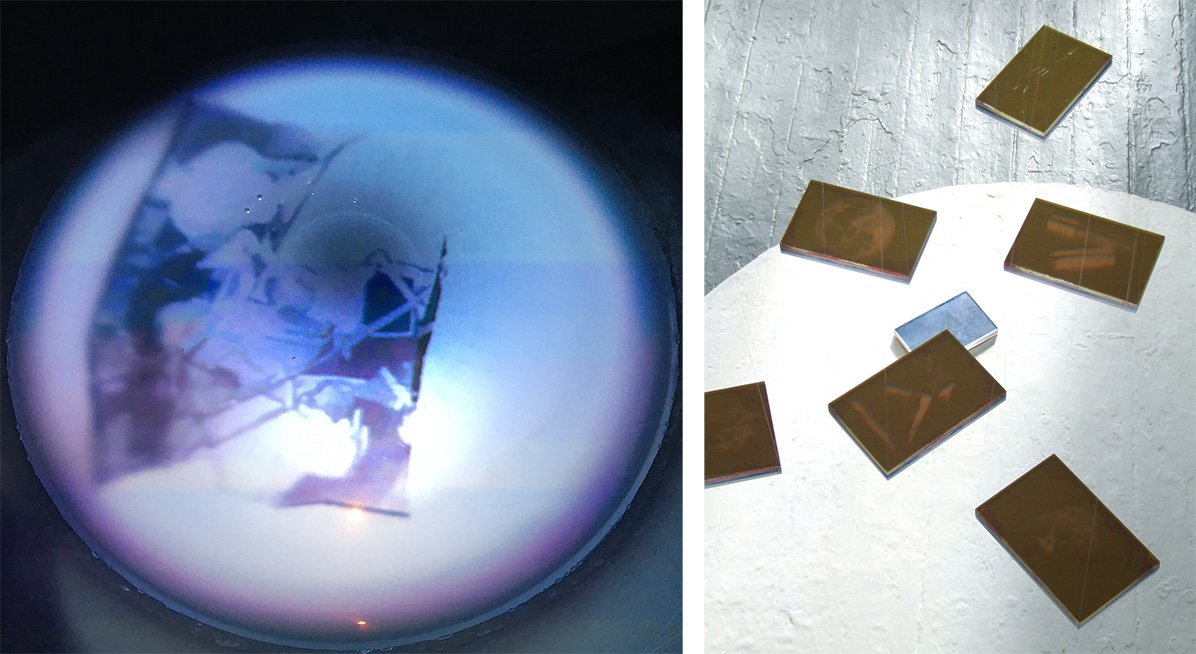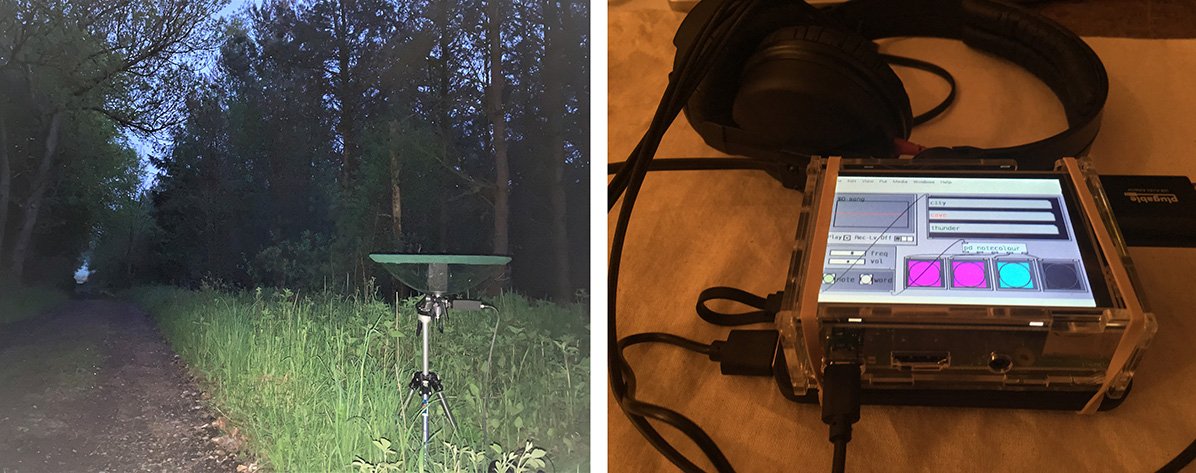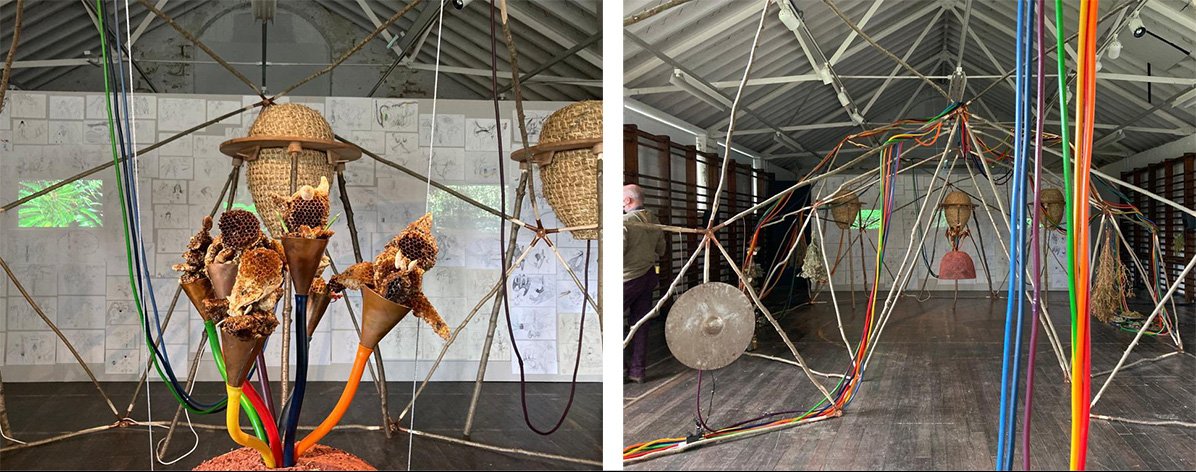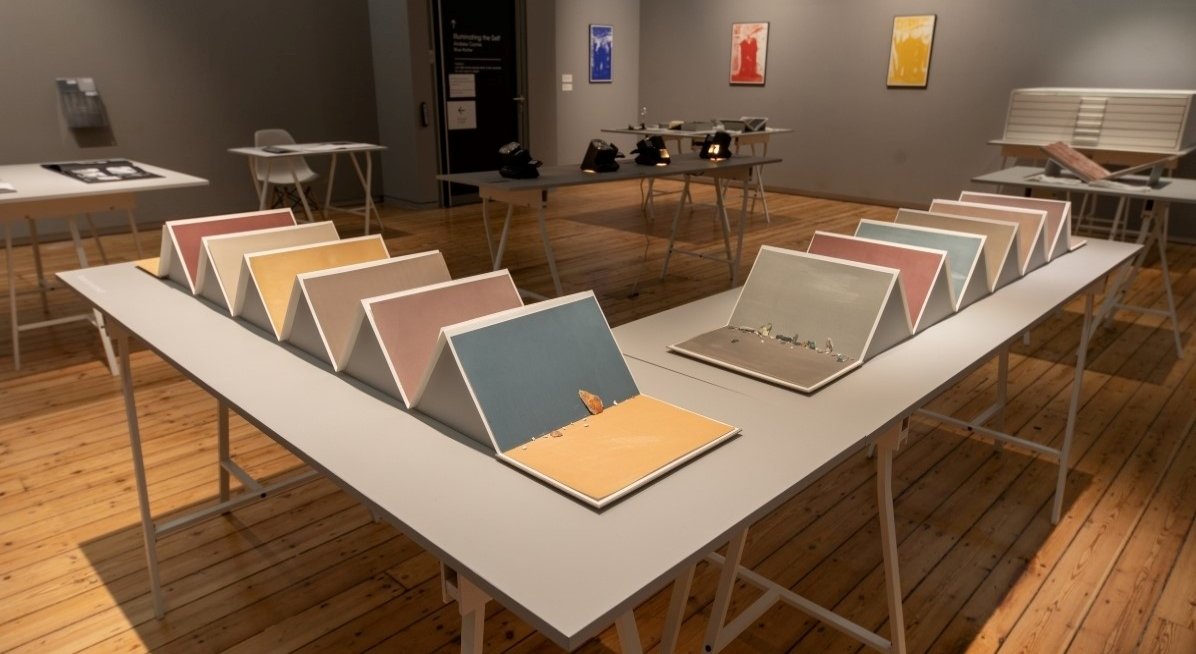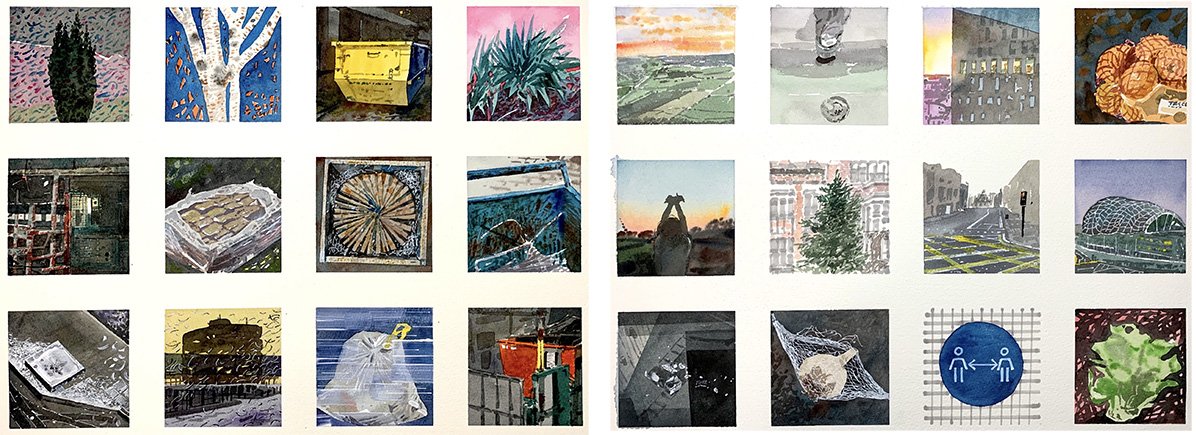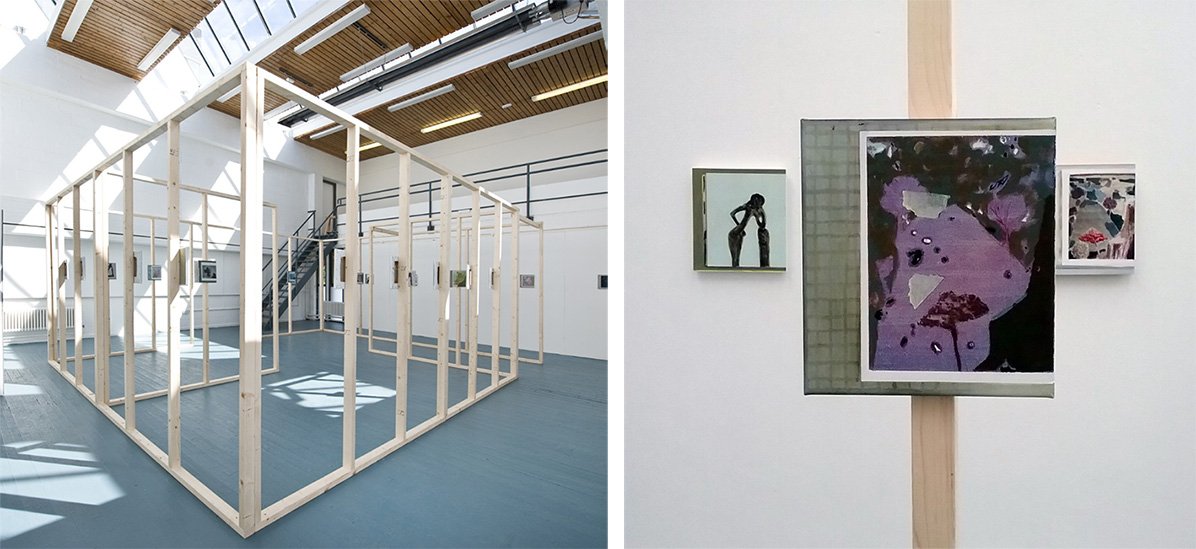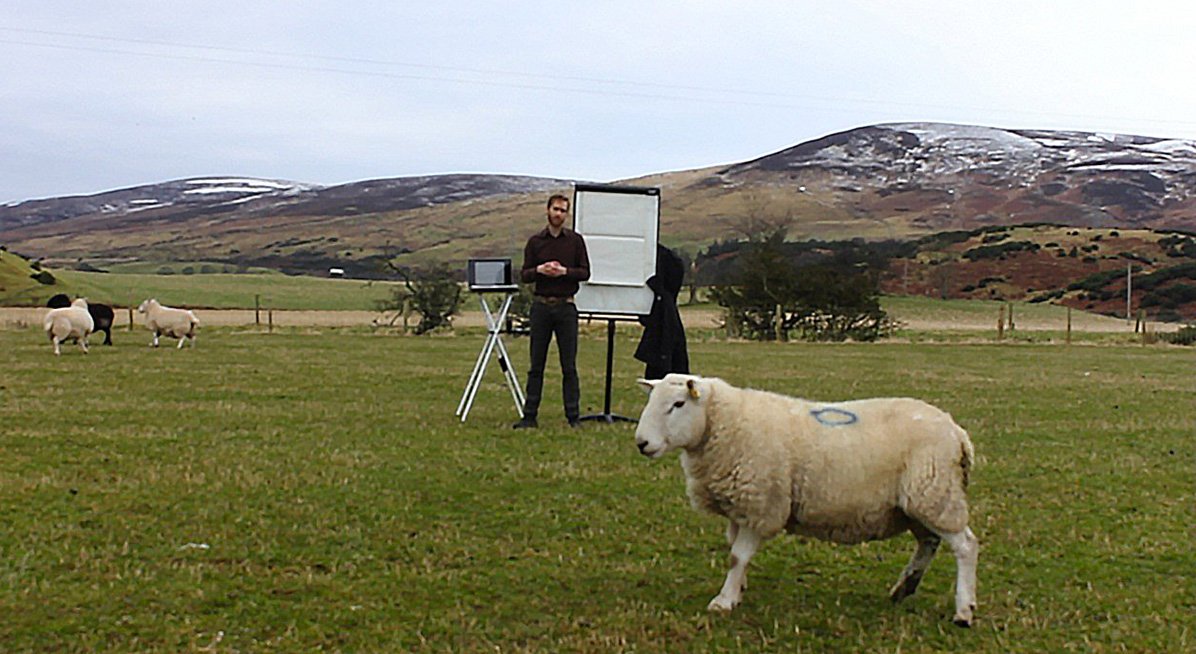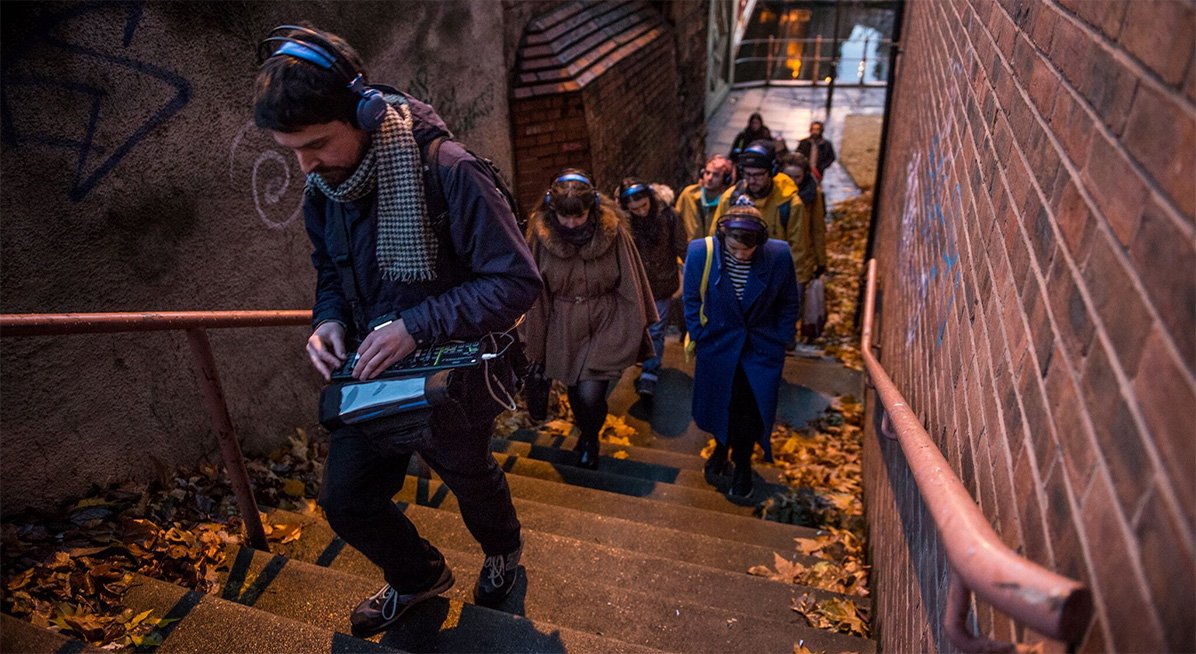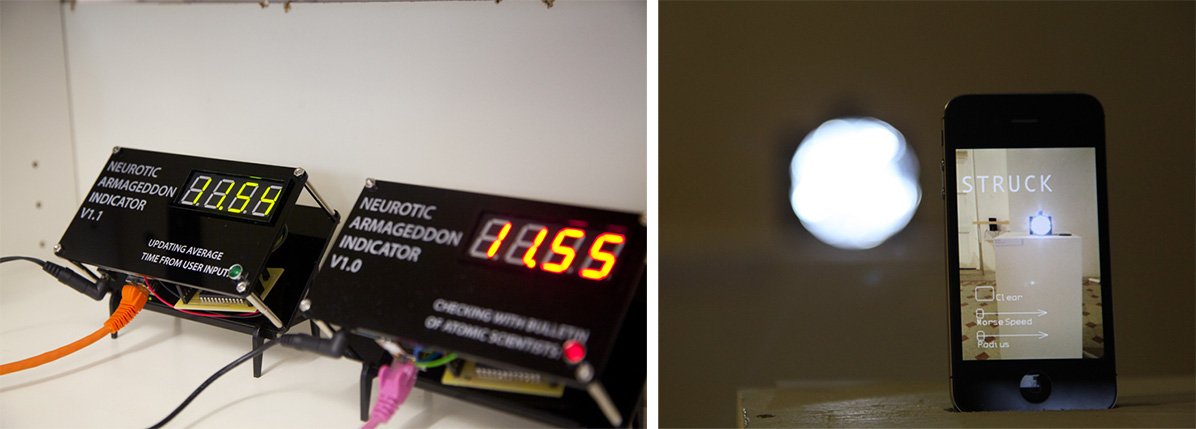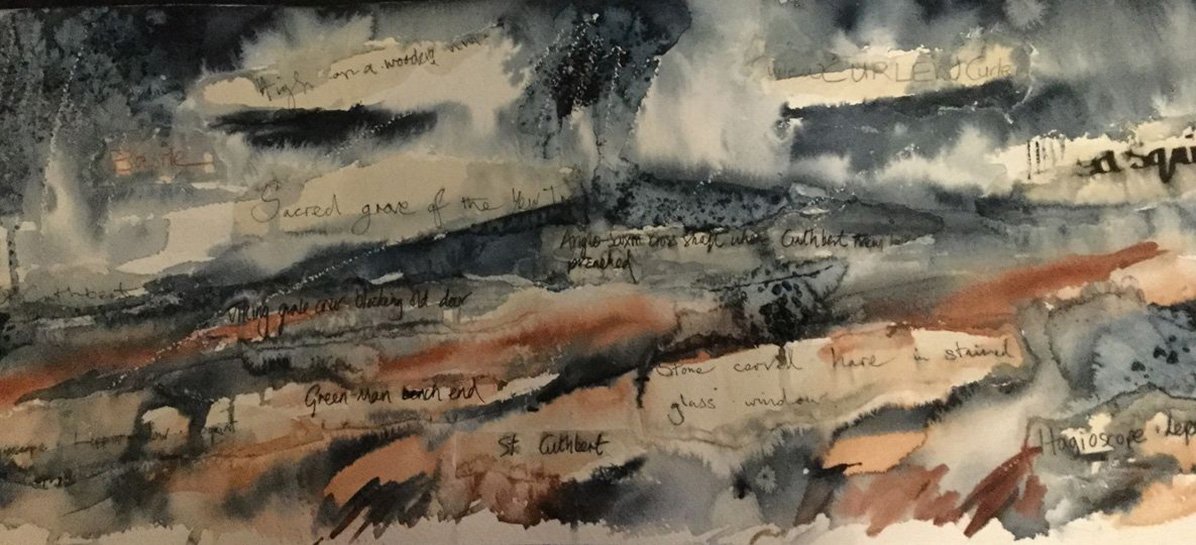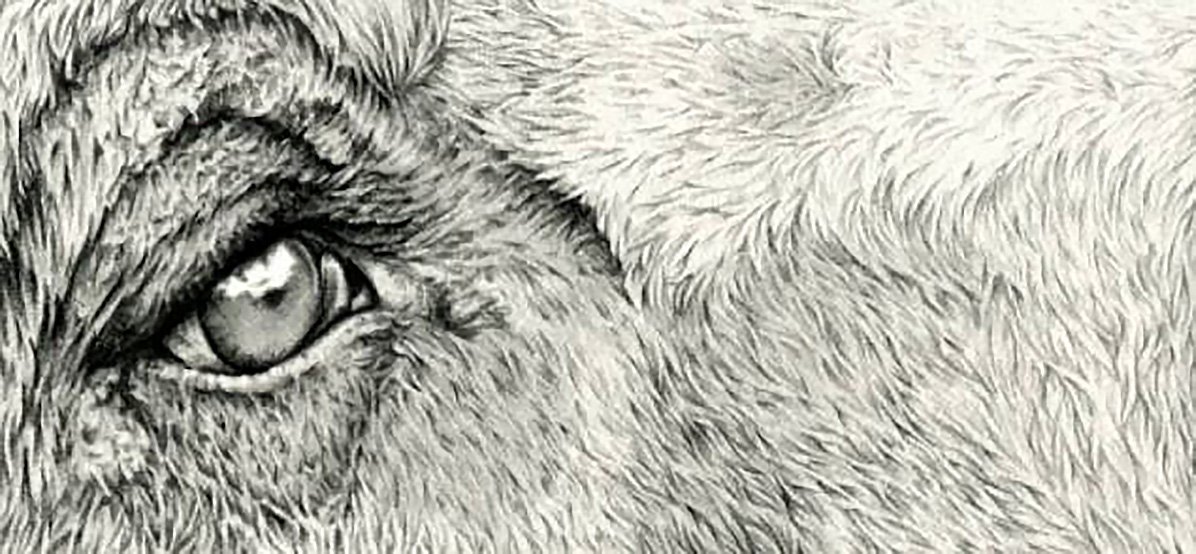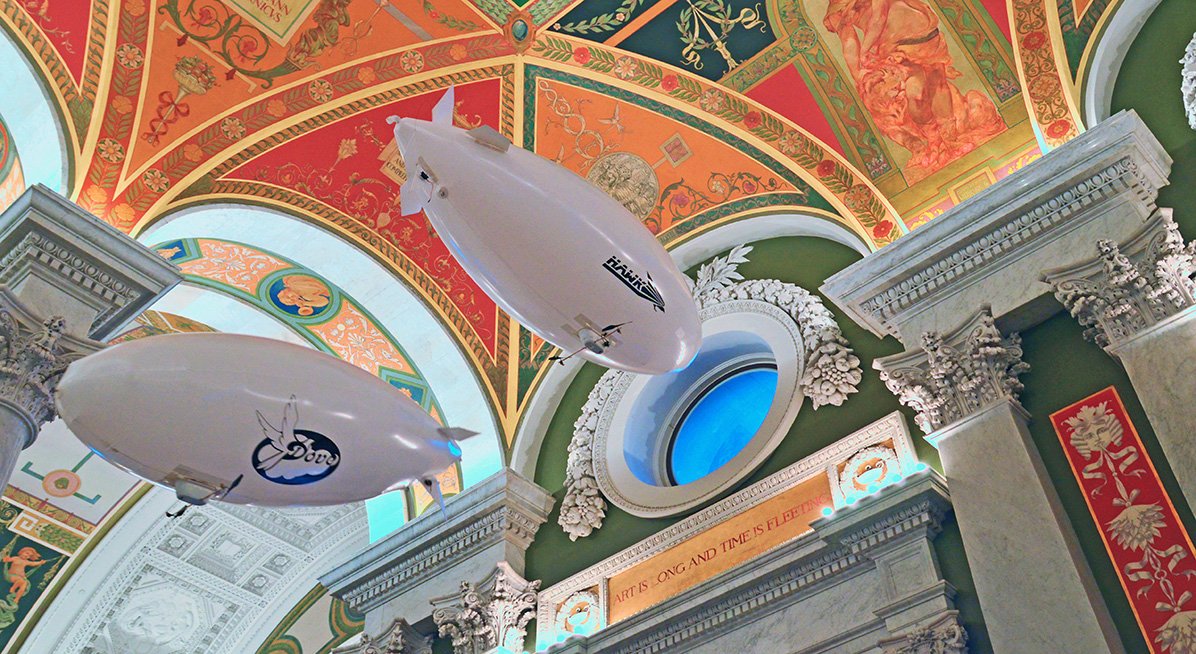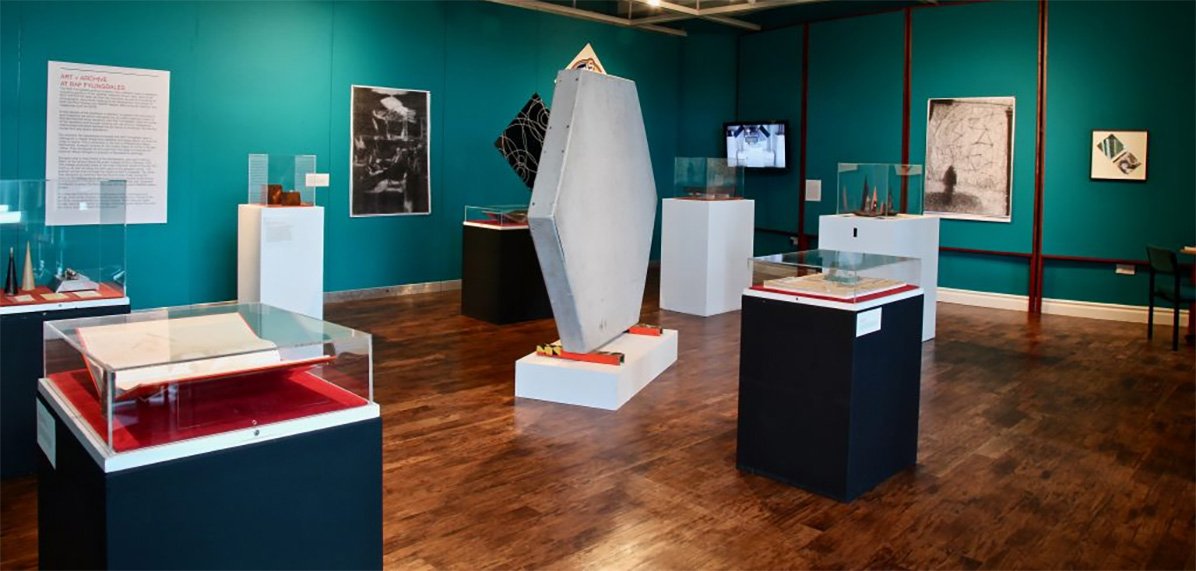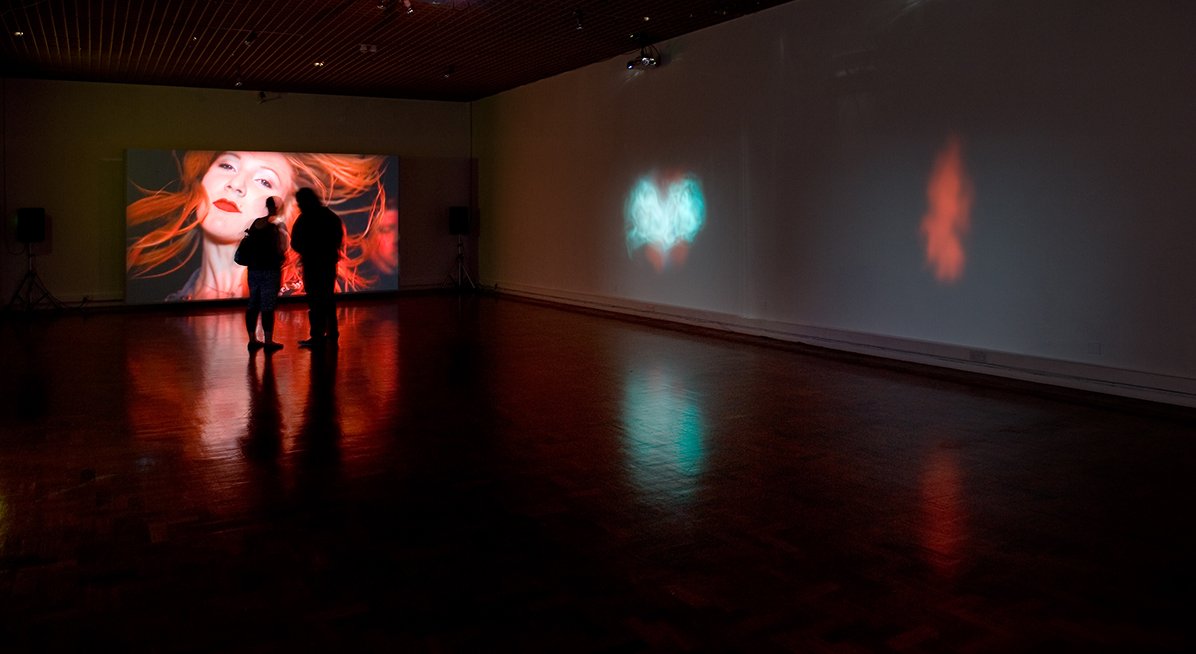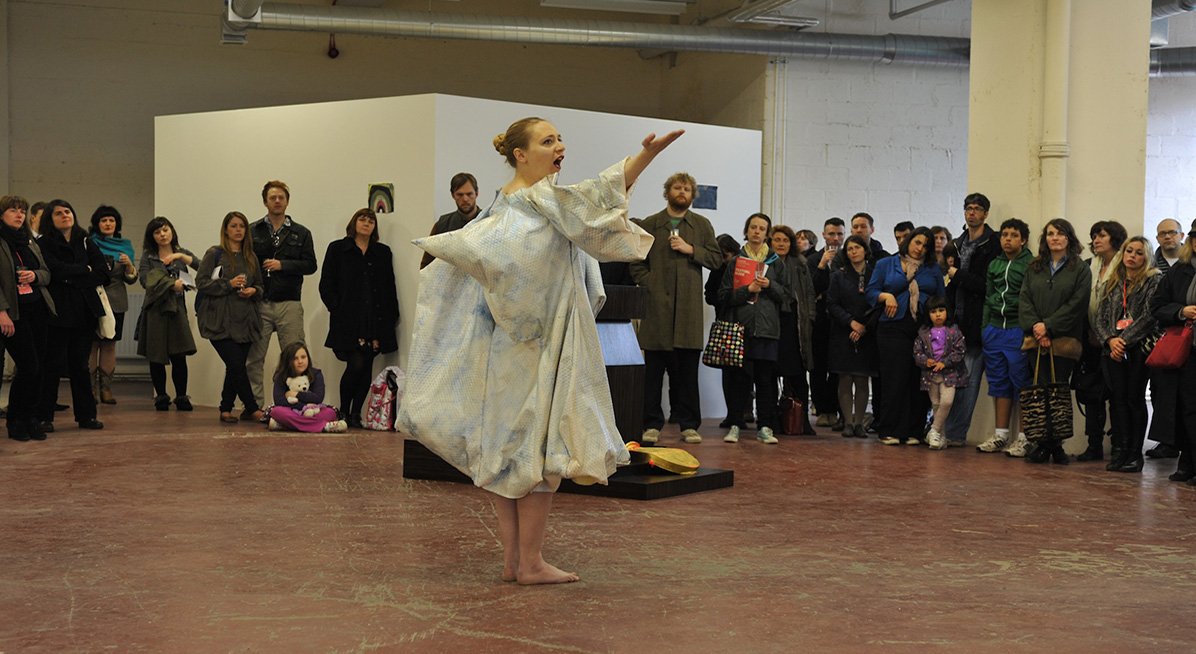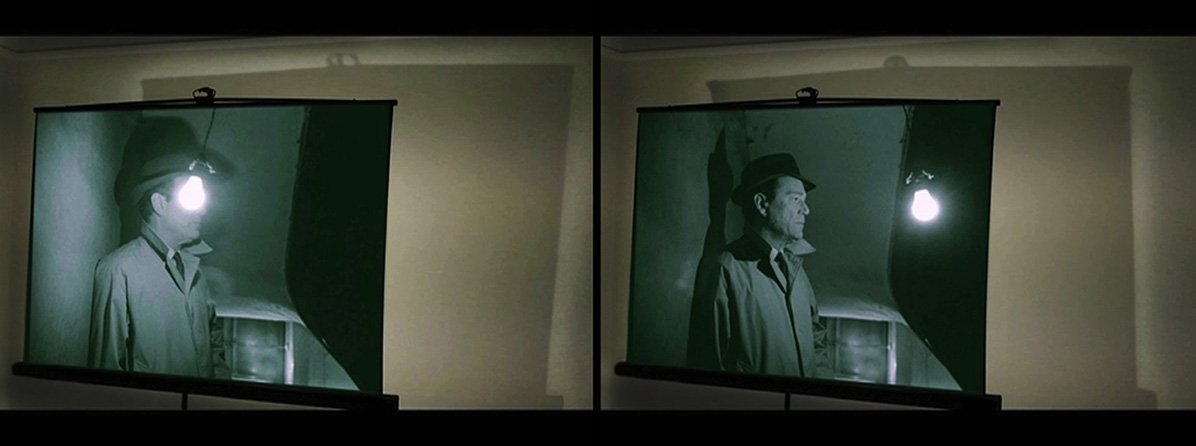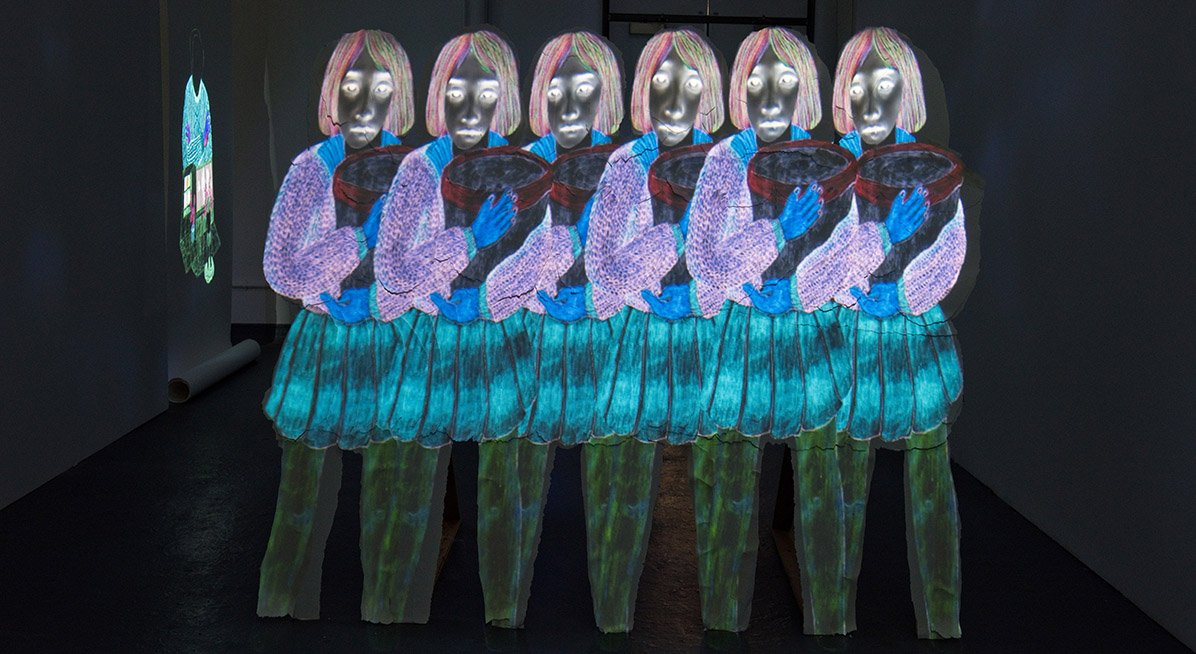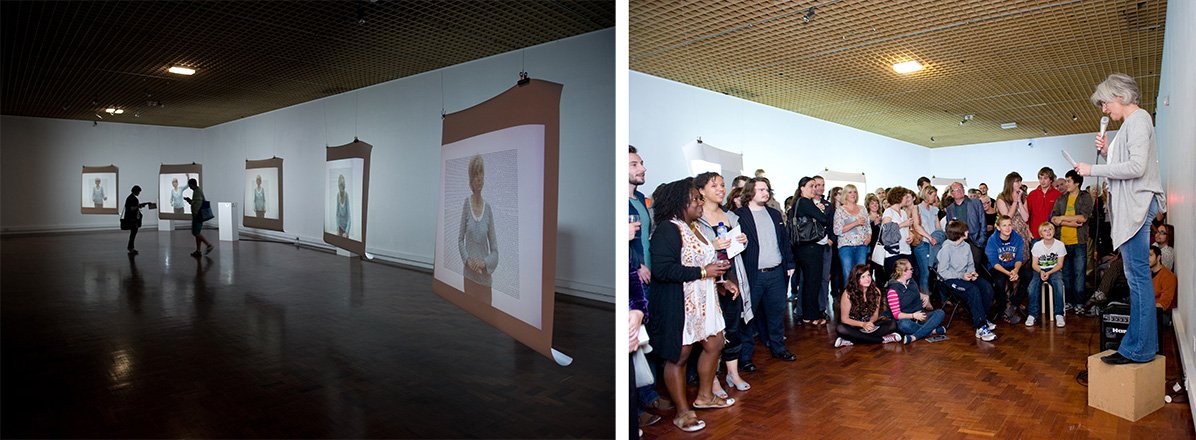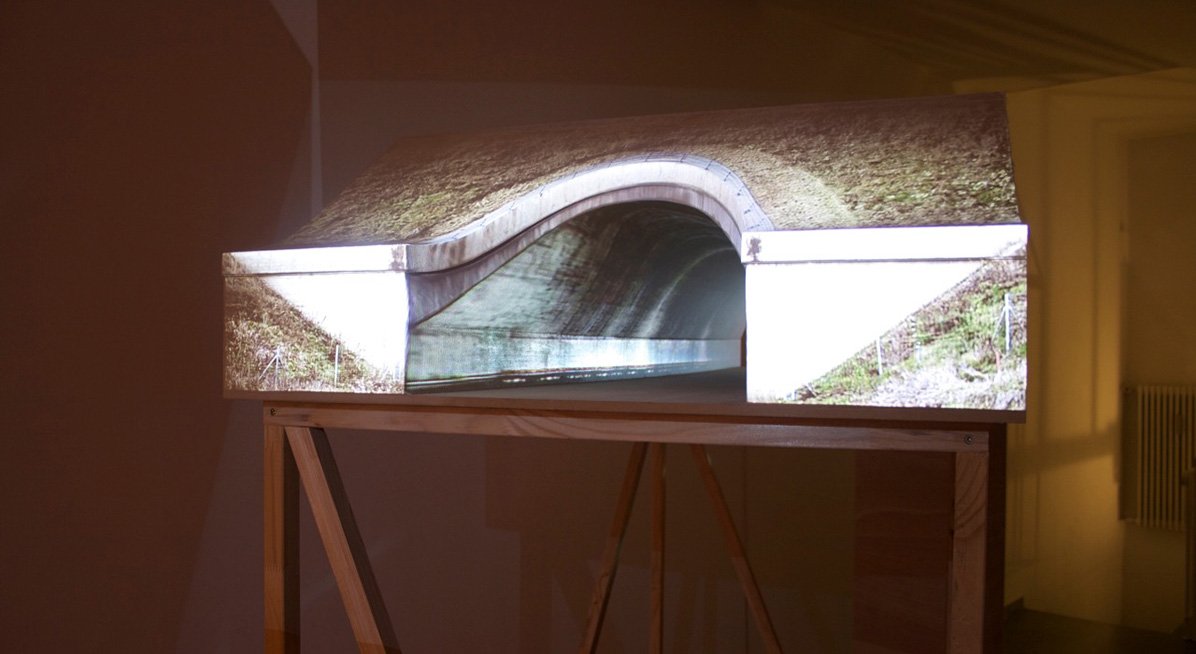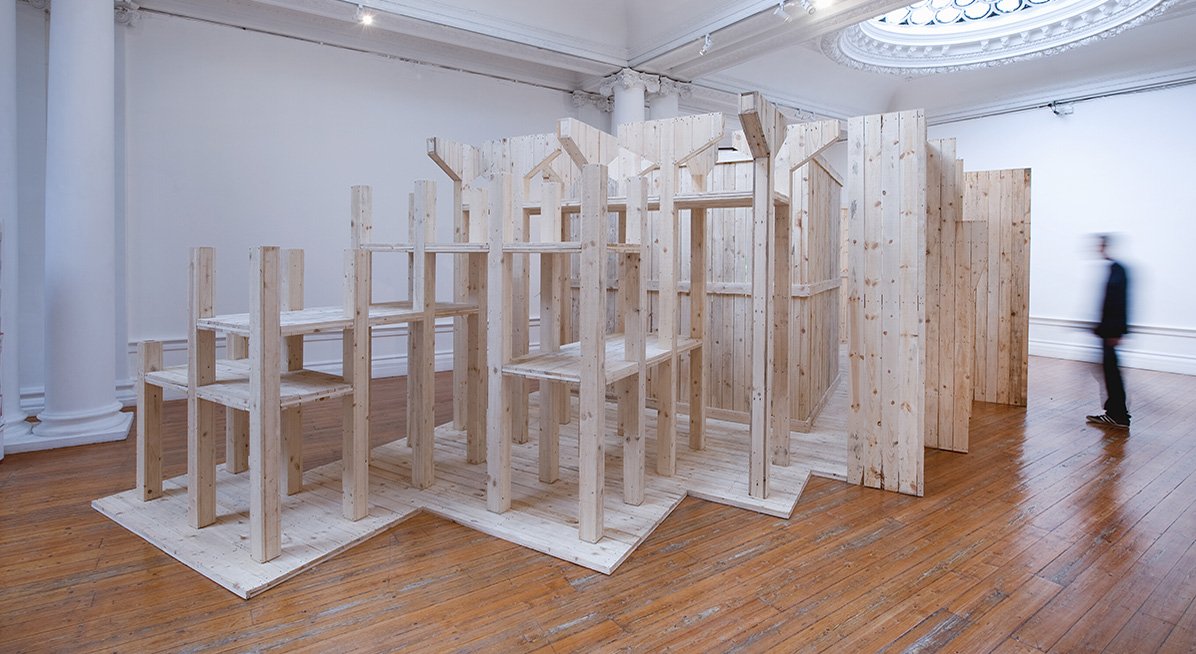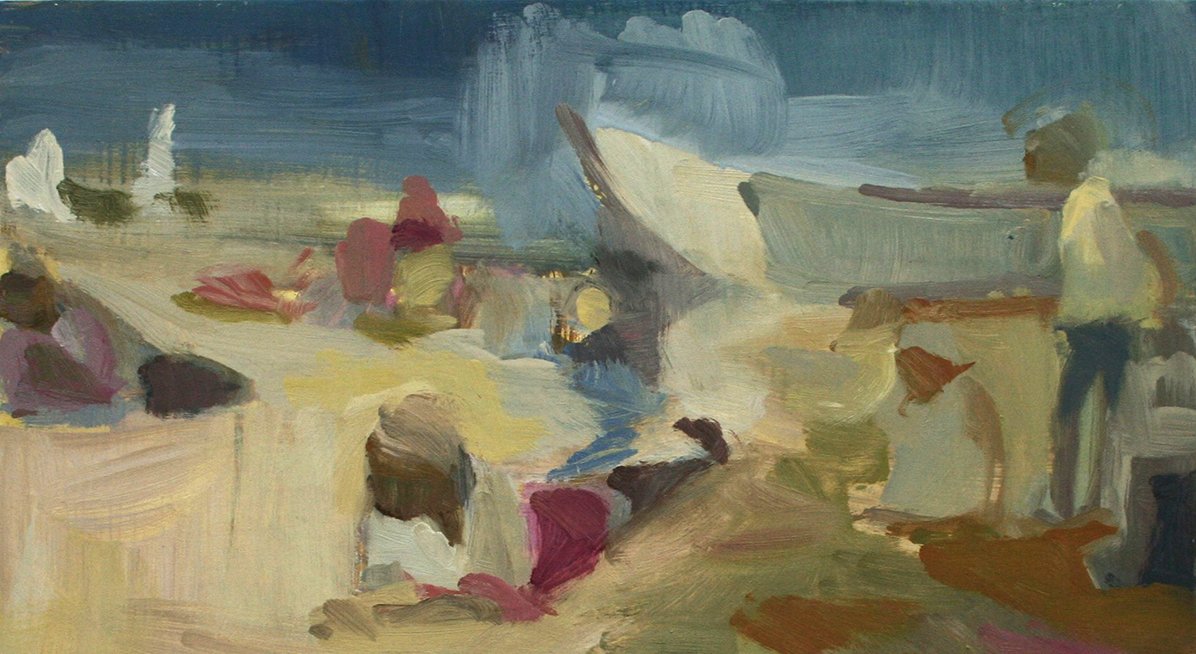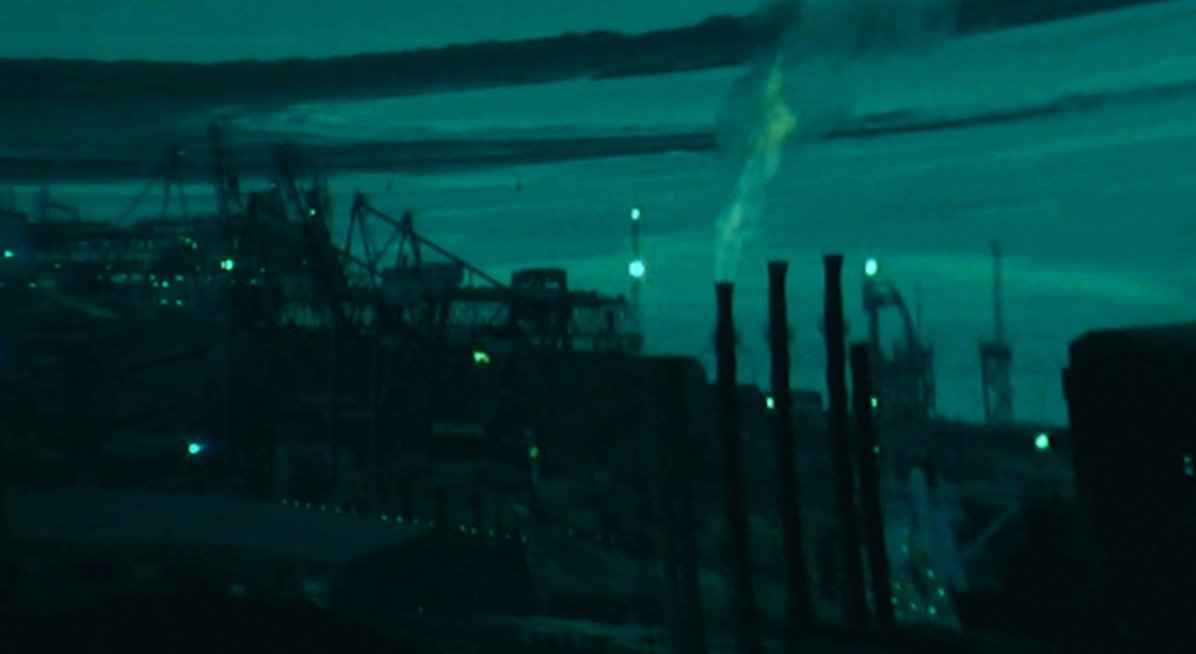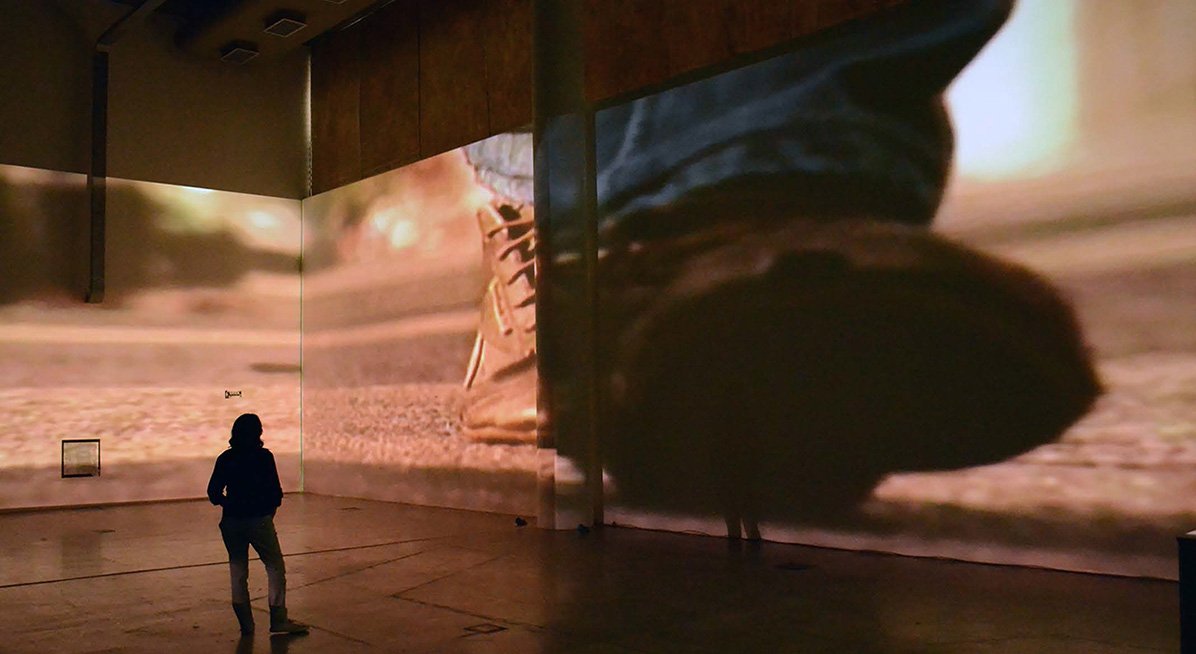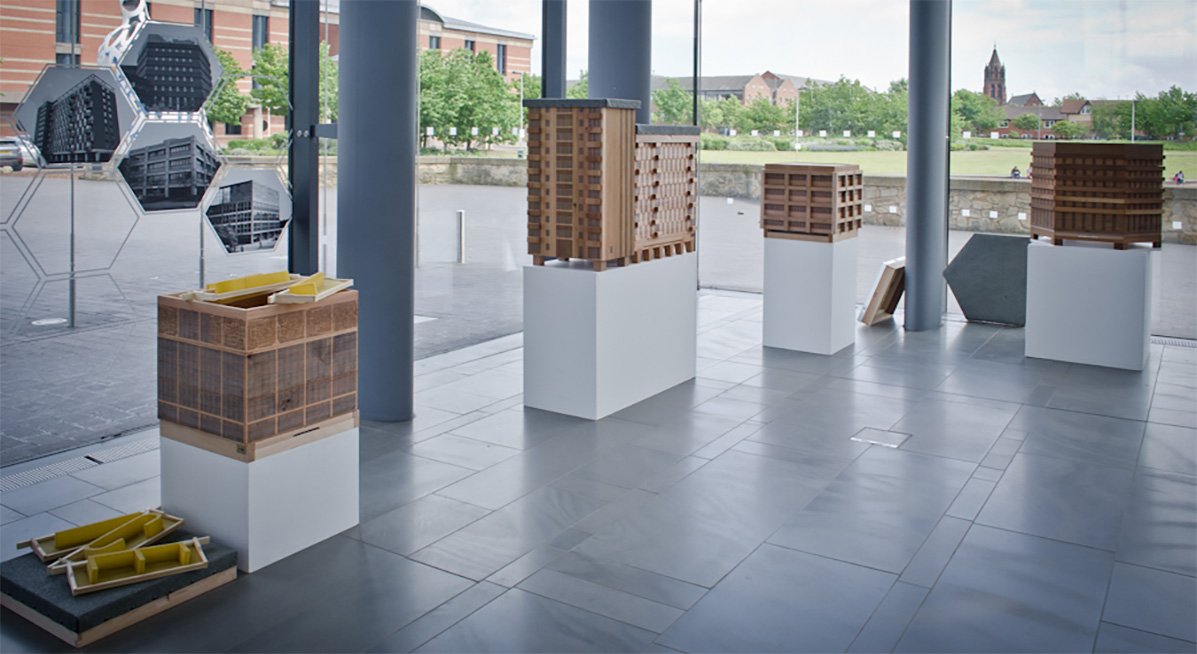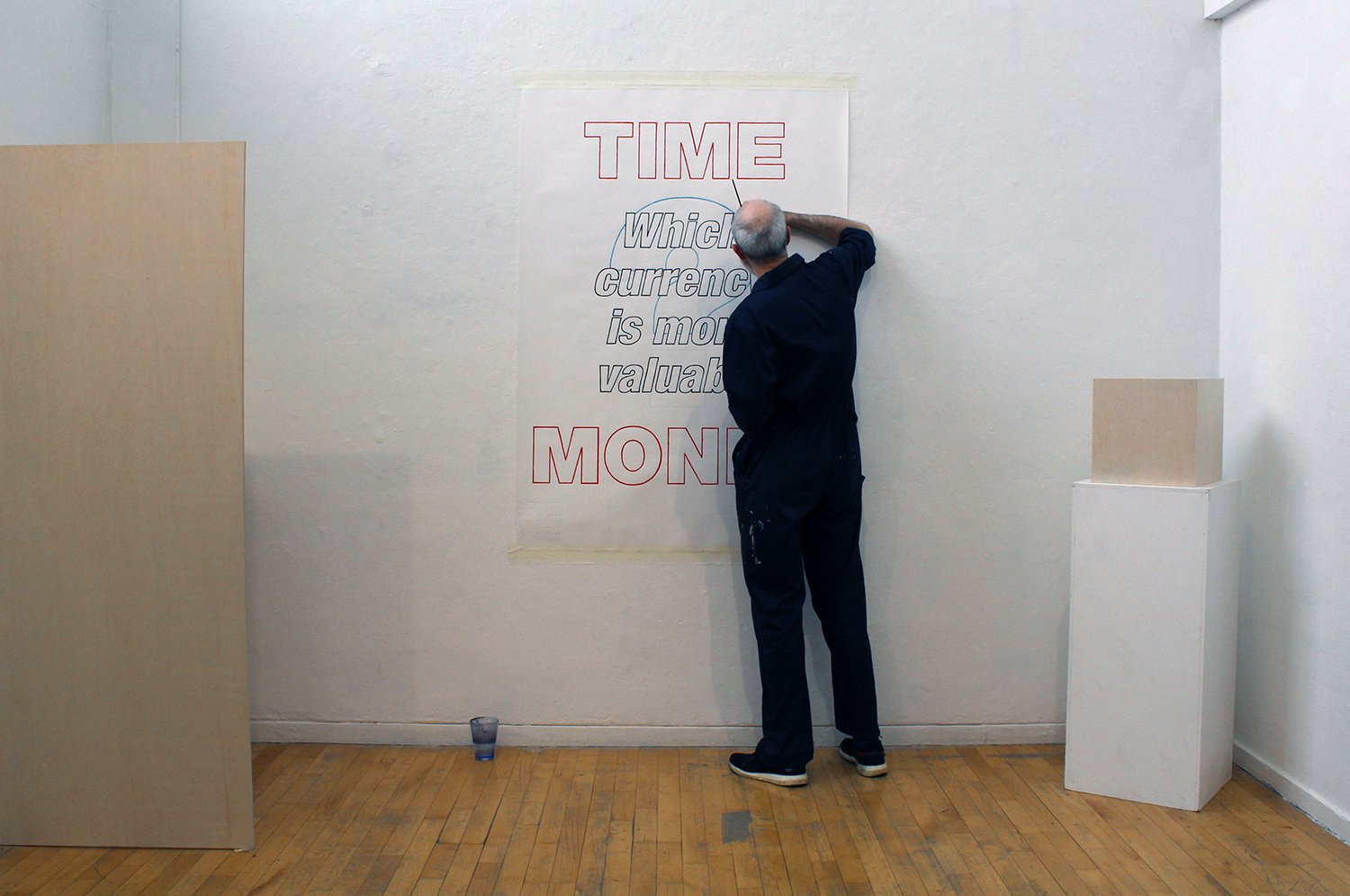Fine Art Postgraduate Research
Fine Art has a thriving community of PhD students; it has built a strong reputation for quality of supervision, and for excellent resources for practice and research.
PhD Study in Fine Art at Newcastle University
Fine Art has a thriving community of PhD students. We support a wide range of both theoretical and studio-based practice and research across Fine Art, Digital Cultures and Art History.
All staff in the unit are available as supervisors, and as a large university, many of our most exciting projects challenge traditional disciplinary boundaries with supervision from across different subject domains. Students whose projects are more digitally-oriented are based in Culture Lab with its attendant facilities.
The department is strongly committed to supporting artists' individual practices through practice-led research. All students are encouraged to participate in the department's and the university's wider research culture by involvement with research seminars, including chairing seminars with visiting artists/researchers. The Institute for Creative Arts Practice provides an important route for engagement and networking with creative practice-led researchers across the University.
All students are also encouraged to engage fully with professional and academic opportunities - for example exhibiting, attending and presenting at conferences, and organising symposia and conferences.
Below are summaries of the projects of both current and recent PhD students.
Narbi Price
Repainting the Pitmen: The Ashington Art Group & Robert Lyon - Rethinking Legacy through Archive and Practice
The work of the Ashington Group (also known as the Pitmen Painters) is a celebrated historical record of a working community, held in great affection in the North East and further afield. However, the main narratives are very limited (a single text by William Feaver, ‘Pitmen Painters – The Ashington Group 1934 -1984’ and Lee Hall’s play, ‘The Pitmen Painters’).
Using three distinct methodologies - archival research, curatorial and creative practices, my AHRC funded Collaborative Doctoral Award research challenges dominant narratives about the Group’s intentions, methods, output and legacy.
At Woodhorn Museum, in Ashington, Northumberland, in Summer 2018, I presented ‘Pitmen Painters Resurfacing’, a major public outcome, which presented a new invigorated position on the work of the Ashington Group. This comprised two new exhibitions; ‘Pitmen Painters Unseen’ gathered previously un-exhibited work, forming the largest and most complete exhibition of the Ashington Group’s work ever staged.
This was accompanied by a major new body of my own work, drawing upon innovative painting and psychogeographical practices, ‘The Ashington Paintings’ investigates the changed landscape of a common geography. It engages with the Permanent Collection of Ashington Group paintings (held in perpetuity at Woodhorn Museum), in its construction and shared longitudinal study of the locale, and provides a neoteric position on how contemporary practice can have an informed, discursive relationship with historical collections.
The shows were accompanied by two new publications with contributed texts by the art critics William Feaver and Matthew Collings.
A selection of the work is scheduled to tour the UK as part of an Arts Council England funded group exhibition entitled ‘Where We Live’, from late 2021 through 2022.
This PhD was one of three studentships that were part of an AHRC-funded Collaborative Doctoral Award research project (CDA) which investigated aspects of art education and culture in the North East from the 1930s to the 1970s.
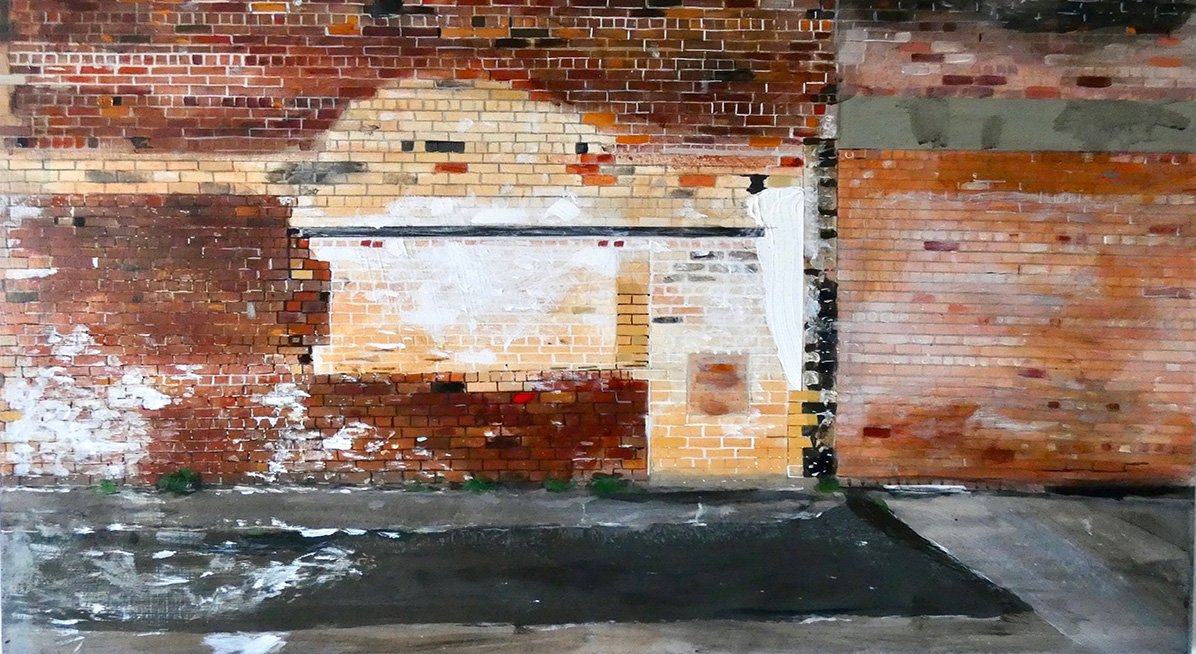
Sneha Solanki
Speculating through the eyes of the othered: eating in the remains of the rural
Set in a parallel rural space and anchored to present-day Northumberland as a case study, this research foregrounds intra-disciplinary arts practice as a tool to interrogate and speculate on rural diversity through the lens of food and eyes of the othered.
Breaking apart the problematic and ongoing perceptions of the rural which perpetuate a static and superficial idyl of nature, English bucolic ‘timelessness’, and the given notion of ‘diversity’, this research aims to identify, remove and set aside the current rural imagination, asking what ‘remains’ and how can speculative thinking from the ‘othered’ offer missing or new research into minoritsed rural inhabitants and food culture.
Food, intrinsically linked to both the rural space (production and cultivation) and to those minoritised through ethnicity has been identified as the lens to explore rural diversity. Connected to community, religion, ethics, land, hybrid-identities, cosmic occurrences and seasonal variation, shifts, infections and adaptions in food culture can be seen with presence in urban areas through transmission activity between and from diaspora or through subsequent generations. In rurality, this is more difficult to see, either invisible or largely ignored.
This research specifically asks-
If there is a relationship between food within rural English countryside landscape and the ‘diversity’ of the population?
Can speculative thinking and making through the lens of food imagine a parallel, asymmetric or more engaged food landscape from the perspective of the ‘other’?
This is a Northern Bridge Collaborative Doctoral Award in partnership with The Maltings (Berwick) Trust (MBT).
Website- http://electronicartist.net/
Cecilia Stenbom
Rules of Engagement: Investigating the transformation of unwritten social protocols into screen-based representations through hybridity and liminal practices.
Cecilia Stenbom’s practice is focused on the moving image and its relationship to the real world – how the moving image permeates reality and in turn, how the everyday is transformed into narrative fiction. Her research interest lies in the processes and methods – both conventional and experimental – involved in narrative filmmaking and how they feed into the above interrogation.
By deconstructing the filmmaking process - a process that employs both documentary and fictional conventions - Rules of Engagement aimed to uncover the complex relationship between actual and screen-based reality. It examined how the process of filmmaking itself further blurs the boundary between the two, and via its position between moving image art practice and narrative filmmaking, the research explored hybridity in screen- based practices across disciplinary boundaries. This practice-led inquiry resulted in a 22-minute-long semi-fictional film Rules of Engagement, which consisted of three filmic vignettes depicting everyday scenarios wherein individuals come up against unwritten or tacit social protocols. The film has the look and structure of conventional narrative drama but has no dialogue creating a deliberate sense of things being staged, unnatural or not quite right, feeding into the tension between reality and representations of it.
Rules of Engagement first screened during a national tour in February 2018: the tour went to Regent Street Cinema (London), CCA (Glasgow), Tyneside Cinema (Newcastle-upon-Tyne), The Maltings (Berwick Upon Tweed) and The Tetley (Leeds). Since the premiere, the work has publicly shown nationally and internationally, including the official selection at London Short Film Festival and screenings at CineKasimanwa film festival in the Philippines, both in January 2019. Rules of Engagement was exhibited in March 2020 at Innsbruck International Contemporary Biennial of the Arts in Austria. Rules of Engagement was awarded runner-up in the 2020 BAFTSS (British Association of Film, Television and Screen Studies) Awards in category Moving Image (Documentary & Image) (Best Practice Research Portfolio).
Cecilia’s project was Funded through Northern Bridge Doctoral Training Partnership and she was awarded a PhD in July 2019. She started as a lecturer at Northumbria University in September 2019. She is currently developing new films work incorporating applied theatre techniques to explore the tension between role-playing as community activity designed to generate change and as corporate training device.
Mathew Parkin
Mathew Wayne Parkin is undertaking an AHRC-funded, practice-based PhD, supervised by Dr Fiona Anderson and Giles Bailey. Their research explores the cultural and creative value of true crime, queer intergenerational mutual aid, and touch through moving image practice. The project centres on the unresolved 2016 fire at Steam Sauna Complex, a queer sex space in a former bingo hall in Armley, West Yorkshire. Using narrative strategies associated with omission, it examines how absence, speculation, and erasure operate within both true crime and queer histories. Mathew’s research is grounded in community engagement, an intersectional understanding of accessibility, and archival investigation, with a particular focus on access within artist moving image practices.
As part of the project, they undertook a residency at the British School at Rome and have presented work through exhibitions at Cubitt Gallery and York St John University, as well as at PERCOL’s My Evidence: Creating LGBTQI+ Art and Archives conference in Amsterdam.
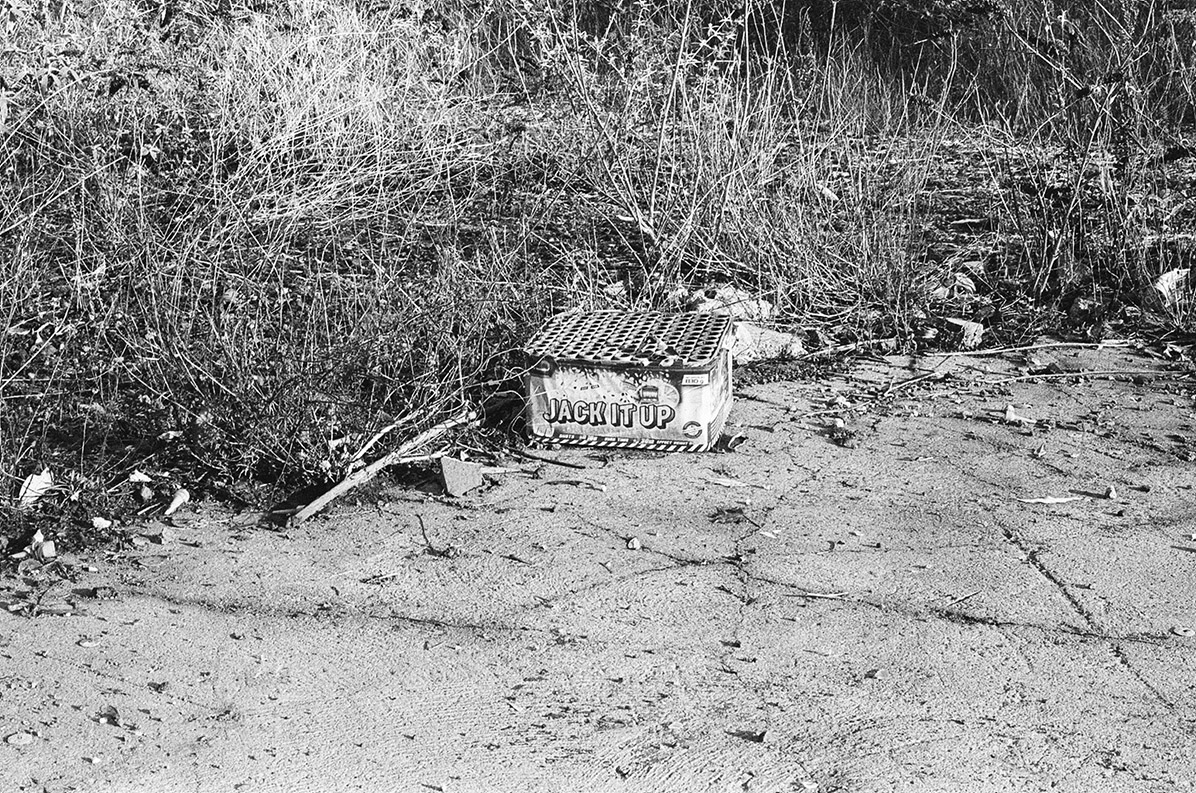
K. Woods
‘It’s Happening’: Countering digital fatalism and narratives of inevitability through interactive art, digital art and installation.
Summary of research:
Digital fatalism is mediated through predictive technologies (that predict crime, educational achievement, future behaviour), and automated decision-making AI (that deny access to housing, credit, employment). To investigate how artistic practice can expose digital fatalism, a contextual review of artists addressing technological determinacy will be conducted, bolstered by an analysis of apocalyptic internet memes as a form of subcultural indulgence in fatalistic ideology. New installation and interactive digital artworks will subvert the tools of predictive and decision-making AI to explore how art can destabilise and mitigate against the effects digital fatalism has on agency.
The core research questions are:
Q1: How can artistic practice expose and critique ideologies of digital fatalism as manifested in predictive technologies, automated decision-making AI and algorithmic inference?
Q2: How does exposing digitally mediated inevitability through art practice affect notions of cognitive and political agency?
Q3: How can artistic strategies mitigate against the negative influences of digital fatalism (i.e. perceived limited agency and lack of control over life-course events)?
Using Hayles (2002) media-specific analysis, a series of practice-led experiments will develop ways to combine interactive/responsive elements with automated/mechanised design to generate new perspectives on digital fatalism. One installation using the framework of voting will explore how digital fatalism interfaces with political agency. Another will intake biometric data to output a supposed psychological profile and future actions (cognitive agency). In addition, semiotic analysis (Kress and van Leeuwen 2006) of the apocalyptic ‘It’s Happening’ meme will produce additional aesthetic references, the meme being a subcultural indulgence in fatalism which started circulation on 4chan in 2008 and provides 14 years of unstudied data.
Liang Zhou
The Integration of text within Contemporary Printmaking
This research is a practice-led exploration of the combination of cross-cultural text art and printmaking in a contemporary environment. I will explore the materiality of printmaking in relation to text and explore the possibilities of cross-cultural text reading.
I will develop my research questions through three series of works. My aim is to examine the ideographic nature of the text, but also to challenge the reading habits of the audience. First, I will explore contemporary printmaking and digital development of Chinese characters. Secondly, I will explore whether the attention of contemporary text artists has shifted from the visual text to the text itself. Finally, I will explore the possibility of creating texts that can be understood by people of all cultures in the context of globalisation. In my work, new symbols will be created by mastering certain rules of symbol designation and arrangement.
Aleksandra Gajowy
Be/Coming in Touch: Queer touch and affective attachments across time and space in Polish art since the 1970s.
Dr Aleksandra Gajowy (she/her) is an art historian working at intersections of Polish visual cultures and marginalised narratives in Poland, including queerness, feminism, race, and Jewishness. Her doctoral thesis (2020), Be/Coming in Touch: Queer touch and affective attachments across time and space in Polish art since the 1970s, was funded by the AHRC and explored theretofore scarcely discussed queer practices in contemporary art from Poland. Examining Polish art practices through narratives of the queer archive – material and imaginary – as well as haunting, cruising, fantasy, empathy, HIV/AIDS, and sex, the thesis aimed to restore the significance of the body to disrupt the hegemonic discourses of compulsory heteronormativity prevalent in today's Poland. Through the body – the material entity available to us "here and now," our body – Aleksandra asked the reader to feel, to sense viscerally, to imagine touching across time and space, in order to come into contact with the queer ghosts haunting Polish history – the discarded, forgotten, silenced, isolated lives, of which little material traces remain. Fantasising with desire is crucial to preserving histories and lives subjected to marginalisation and forced into the sphere of abjection. It enables the long-silenced queer lives in Poland to speak for themselves outside of the victimising discourses of shame, fear, and persecution, which, although crucial to recognise, do not constitute the entirety of queer lived experience. In this way, queer lives are not only remembered, but desired and yet again enlivened and embodied.
Aleksandra’s current research project investigates how Polish artists since the nineteenth century until the present have imagined and represented race, ethnicity, and Jewishness, in relation to the continuously ambiguous positioning of Polishness within Europe, oscillating between narratives of exceptionalism and the sense of inferiority towards the West. Exploring legacies of colonialism in Polish visual culture, she examines the contemporary moment in Poland and its uneasy relationship with difference, belonging, and national identity, through performative perceptions of race and ethnicity.
Aleksandra has presented at multiple international conferences in Europe and the US, including London, Edinburgh, New York City, Reykjavik, Brighton, Warsaw, and Moscow. Her writing appeared in Art Margins, Third Text, Contemporary Theatre Review, and QED: A Journal in GLBTQ Worldmaking. She has upcoming publications in Oxford Art Journal and East Central Europe. Aleksandra is a contributing author in upcoming volumes Queer Print in Europe (Bloomsbury, 2022), The Handbook of Sexuality in Central and Eastern Europe (Routledge, TBC), and Ambivalent Work*s: Queer Perspectives and Art History (Diaphanes/Chicago University Press, TBC).
Twitter: @DrAGajowy
Anthony Polo
Eco-intervention Art: Reinterpreting Gas Flare Practices in Niger Delta through Contemporary Paintings.
Anthony Polo's works investigate the complex relationships between humans and nature. His works focus on the ecological issues in the Niger Delta.
However promising, with vast crude oil mineral resources and reserves, fertile fishing grounds, and forest games, teeming with endangered species of wildlife and aquatic life, toxins, industrial pollutants, and gas flares practices, from oil exploration operational activities have increasingly polluted the environment, affecting the region's farmlands and potable water supplies thus marking the Niger Delta as one of the world's most ecologically endangered regions.
He engages the ideas of ‘Change and Transformation’, ‘Destruction and Creation’ to highlight the issue of Anthropocene subjectivity and the precarious nature of the Niger Delta landscape while exploring the role of combustible materials in art making. His works are conceptual inquiries into the illimitable nature of art to constitute meaning with an exploratory link between fire and other combustible materials. Since fire is light and so also is color, the exploration of both energies is used to create a visual resonance depicting climate change and ecological issues facing the Niger Delta region of Nigeria.
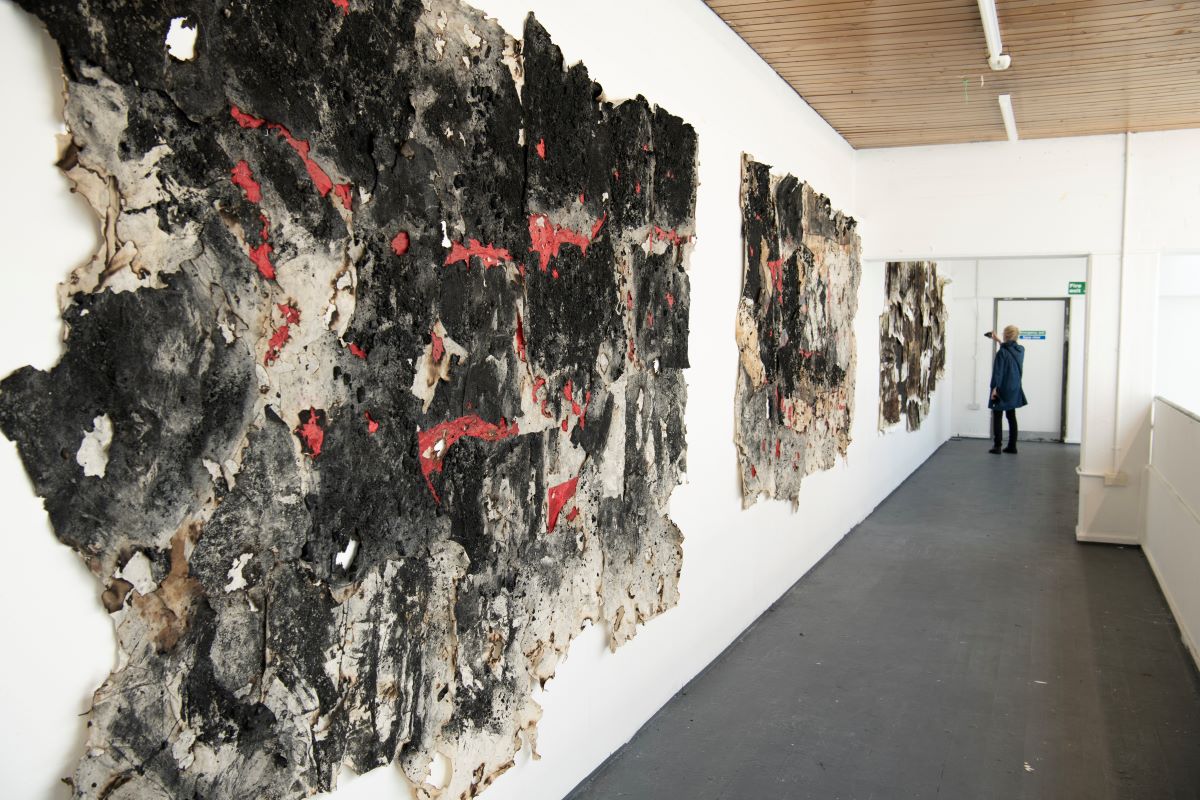
Marjolaine Ryley
Time, Image, Archive: Visualising garden communities through auto- ethnographic photographic practice.
Marjolaine's practice-based PhD research encompasses interdisciplinary strands including working with photography, writing and plants and exploring gardens as sites of practice. Using auto-ethnography, post-humanism and critical plant studies her engagement with the Garden interweaves creative writing, sustainable photography, plant-made imagery and collaborative workshops to instigate dialogues around human-plant relations and our place in a more than human world.
Her research montages both archival and auto-ethnographic stories emphasising Women’s experience in the garden through a number of current and historical voices. The practice also raises awareness about the current extinction risk to plants and the beneficial effects of gardening/growing/plant-relations for both humans and the environment, told through these personal encounters.
Using three sites of practice the National Trust’s Wallington Heritage Garden, Dilston Physic Garden and her own allotment Plot 92 her work is rooted in the ‘horti-counterculture’ questioning how arts practice can transverse ecology, growing, sustainability and photography to generate acts of resistance, protest and hope in an age of uncertainty. As part of her practice she is also artist in Residence at Dilston Physic garden and undertaking an RHS level three qualification on Horticulture.
Marjolaine is a Lecturer in Photography at Sunderland University, and her research is funded by the AHRC.
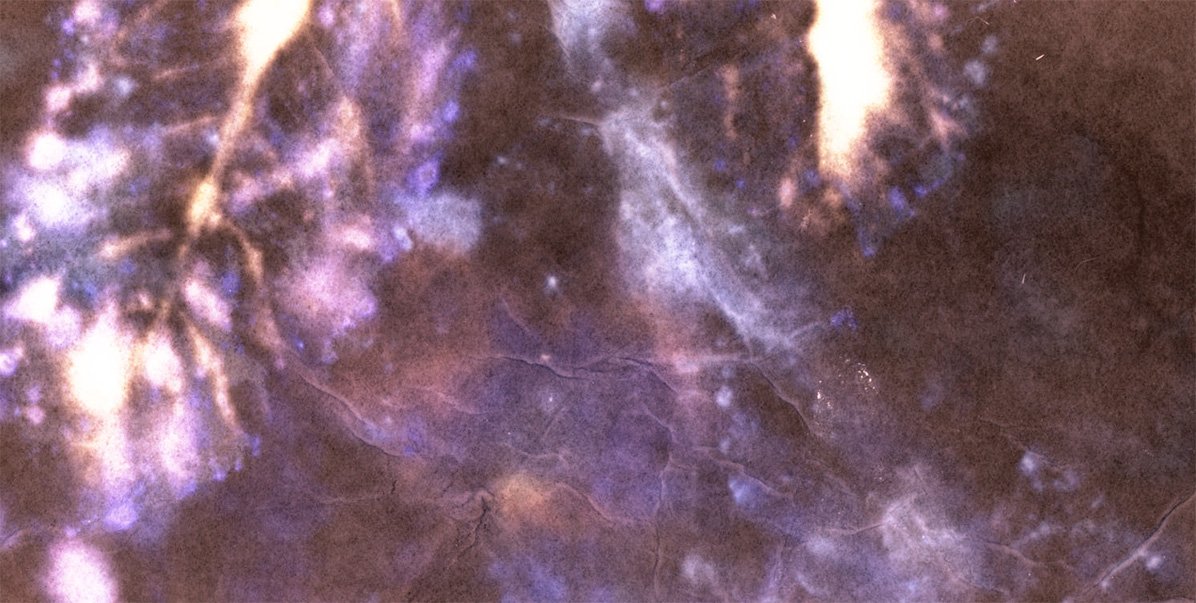
Martin Eccles
Sonic Walking: using sound and text to present the embodied experience of movement, time and distance in the landscape
This practice-led research explores the analytic tools, sound and text, alongside personal experience in presenting movement, time and distance in the landscape. Sound, text and drawing will be the principle analytic tools and walking the principle method. Together they offer a range of links between the artist, the embodied act of walking, its context, its sound and the audience. Works, in performance or presentation, will evoke the embodied movement of humans in the landscape; guided by theoretical ideas, the thesis will enquire into the structuring and depiction of movement, time, distance and landscape. Evolving ideas include: the use of replication to re-imagine time and distance; the use of randomness as a means of choosing where and when to walk; and the exploration of islands (both real and imagined) as a structure within which to present time and distance.
Exhibitions:
- ‘Fair Isle Reels 4 x 2 (after John Cage)’, at ‘Schhh…Culture’ event, Culture Lab, Newcastle University, November 21st 2016.
- Performance: ‘Four Northumbrian Rants’ (60 minutes, 4-channel sound work mixed live; accompanying A8 score and poems) at ‘Material Potential’, Culture Lab, Newcastle University, 10th March 2017.
- 4 Island Reels (after John Cage) (20-minute sound installation, 200 cm concertina fold A5 book of poems, 30 cm concertina fold A8 score), Sound+Environment, Hull, July 1st 2017.
- Around the Wind (10h 27m 9-channel sound piece, mixed live, 2300 cm floor text work), Culture Lab, Newcastle University, July 25th 2017.
- trace no trace Allenheads Contemporary Arts. 20th – 22nd April 2018 and Cheeseburn Grange May 19th – 20th & 26th – 28th 2018.
- 2: ‘no trace’, Digital Lounge, Tyneside Cinema. 18th October 2018. The work was also performed in Culture Lab, Newcastle University (Nov 6th to 8th).
- begin to hear: sounds of a colony (10 minutes 4-channel sound work) in The Art of Field Recording Various Artists, The Arches, Quadrangle Gateway, Kings Walk, Newcastle University, UK, Walking Festival of Sound, Newcastle upon Tyne, 11 October - 14 October 2019.
- begin to hear: Soundwalk, Walking Festival of Sound, Newcastle upon Tyne, 11th - 14th October 2019.
- begin to hear installation 104-minute, 8-channel sound installation and poetry work composed of recordings of walks to the same natural phenomenon - a Kittiwake colony. XL Gallery, Fine Art Department, Newcastle University, 23rd & 24th October 2019.
- 2: “no trace” (version 2) (Št 2: “brez sledi”) 106-minute, 8-channel sound installation. Steklenik Gallery, Ljubljana, opening 12:00 16th November 2019, running until 11th January 2020.
- 2: “no trace” (version 2) (Št 2: “brez sledi”) - live performance. 25 minute, 8-channel, live performance, Steklenik Gallery, Ljubljana, 19:00 19th November 2019.
- four rants for the summer solstice (after John Cage, 1977). A 3h 55m 37s 4-channel installation, The Arches, Newcastle University, 09:00 21st December 2019 to 09:00 23rd December 2019.
- One Day in June 60-minute, 2-channel sound installation and poetry work, XL Gallery, Fine Art Department, Newcastle University, 12 - 14th February 2020.
- in the south of an imaginary island; soundwork and books, Landlinks Exhibition, group exhibition curated by Kel Portman, June 17th - 27th 2021, The Three Storeys Centre gallery, Nailsworth, Gloucestershire.
Radio broadcasts
- Eccles M, Orford Ness1 Mixdown (13m33s to 18m10s). In: Framework Radio #609: 30th July 2017; a quiet position – orford ness [curated by Jez riley French & Phoebe riley Law] (http://www.frameworkradio.net/2017/07/609-2017-07-30/)
- Eccles M, Orford Replication (1hr radio show). Framework Radio #627. Premiered ResonanceFM Feb 4th 2018 (https://resonancefm.com/schedule/2018-02-04) (http://www.frameworkradio.net/2018/02/627-2018-02-04/).
- Eccles MP. Beàrnaraigh (presented as 24 one-hour episodes) - a programme exploring movement, time and distance through walking on an outer Hebridean island. Beàrnaraigh is a durational, 24-hour work. Resonance Extra, Nov 2nd 2018 to May 10th 2019. (https://extra.resonance.fm/series/bearnaraigh) (https://www.mixcloud.com/martineccles2/playlists/bearnaraigh/)
- Eccles MP. Flux #2 - Búðahraun (2hr radio show), Resonance Extra, Feb 3rd 2019, 16:00 - 18:00. (https://extra.resonance.fm/episodes/flux-number-2-budahraun)
- (https://www.mixcloud.com/martineccles2/playlists/búðahraun/)
- Eccles MP. Beàrnaraigh (24h sound work) - a programme exploring movement, time and distance through walking on an outer Hebridean island. 24-hour broadcast Radiophrenia 26th May 2019 11:59 pm - 27th May 2019 11:59 pm; https://2019.radiophrenia.scot/schedule/ ; http://radiophrenia.scot/news/
- Eccles MP, One Day in June (1hr radio show). Framework Radio #687. Aired on ResonanceFM 23:00 September 22nd, 2019 (https://www.mixcloud.com/framework_radio/framework-687-20190922/) (http://www.frameworkradio.net/2019/09/687-2019-09-22/)
- Eccles MP, No. 2: ‘no trace’ (stereo; 107 min; FM Radio (88.8 MHz) and internet radio (radiocona.si)), 20:00 January 21st 2020. Broadcast during radioCona: StoryscapesSE, FM sound art exhibition, live from Ljubljana, Slovenia, Sat 18th - Thu 23rd Jan 2020, each day 6.33PM - 11.30PM. http://www.radiocona.si/blog/2019/12/18/radiocona-krajine-pripovedi-jv/ http://www.radiocona.si/program-po-dnevih_radioconakrajine-pripovedi-jv/
- Eccles MP, Dawn chorus walk, 3rd May 2020 (44m56s duration). In: Star and Shadow Radio, Tyneside Sounds Society: Dawn Chorus Broadcastathon - Saturday 11 July 22.00 - Sunday 12th July 11.00. http://mixlr.com/star-shadow-radio/events/tyneside-sounds-society-dawn-chorus-broa
- Eccles MP, The 42 Walks of Contención Island (stereo; 1hr radio show), Framework Radio #728. ResonanceFM 23:00, October 4th 2020. (http://www.frameworkradio.net/2020/10/728-2020-10-04/).
- Eccles MP, Back Up The Long Wall: four midsummer dances for an imaginary island (stereo; 4hr radio show), Radiophrenia 15th Nov 2020, 6:00 am to 10:00 am (https://2020.radiophrenia.scot/schedule/15-sat/)
- Eccles MP, A Very Random Lockdown: 42 days walking an imaginary island (stereo; 1hr radio show), Radiophrenia 22nd Nov 2020, 7:00 am to 8:00 am (https://2020.radiophrenia.scot/schedule/22-sun/)
- Eccles MP, Walking to the sounds of contención island day 10 thursday january 14th, aporee soundmaps. Included in framework #746: 2021.02.28.
Presentations
- Eccles Martin P. ‘trace no trace’, presented in ‘Desire Lines, Dawdles and Drifts: Walking together as research’, Royal Geographical Society (with The Institute of British Geographers) Annual International Conference, Cardiff, 29th August 2018.
- Eccles Martin P. ‘trace no trace’, presented at 4th World Congress of Psychogeography, Huddersfield, 7th September 2018.
- Eccles Martin P. “Walking slowly while recording the unseen” - 90-minute panel presentation and discussion with John Beauchamp, Jeremy Evans and Andy Fell; chaired by Andrew Stuck. Sound Walk September; Walk, Listen, Create, 17th September 2020 (https://walklistencreate.org/walkingevent/walking-slowly-while-recording-the-unseen/)
- Eccles Martin P. Walking Contención Island. 20 min Audio Paper. Walking as a Question, Prespa, Greece, July 2021.
Personal website links: martinpeccles.com
Facebook: @martinpecclesartist
Olivia Turner
Between Doctor, Patient and Cadaver: The Slippages of the Visceral Body in Medicine.
This practice-led Fine Art PhD examines the visceral body in medicine through imagined encounters with the doctor, patient and cadaver, using ‘examination’ as concept and critical method.
Through sculpture, performance, video and installation, this research considers the complexity of the visceral body within the clinical encounter. It reflects upon the different types of gazes projected and languages used to uphold or transgress the boundaries of the body. The nature of clinical space is explored within the waiting room, examination room, and dissection room. This research embodies a subjective feminist voice and the lived experience of what it means to be an examined body; about what it means to be in my body.
This PhD is fully funded by the Research Excellence Academy Studentship. In 2019-21, Olivia was recipient of 2 Wellcome Trust awards. Co-Investigator for a £30k Wellcome Trust Discretionary grant, Thinking Through Things: Object Encounters in the Medical Humanities; and Principal Investigator for a £10k Wellcome Trust ISSF Small Grant, The Visceral Body in Medicine. Since 2017, she has been working with the Wellcome Centre for Mitochondrial Research. In 2019, she was appointed Lead for the Arts & Medical Science Research Cluster at Newcastle University.
During her PhD, Olivia has exhibited: Archival Imaginarium (2021) Thinking Through Things [Online]; Confusion of Tongues (2021) SpeakEasy, AirSpace Gallery, Stoke-on-Trent; The Body (2021) Zest Hall [Online], Round Lemon; O (2020) XL Gallery, Newcastle University; New Sculpture (2019) Cheeseburn, Northumberland; Women and Power: Switched on! Shining a light on female innovation (2018) collaborator Dr Pavandeep Rai, Cragside National Trust, Northumberland; Palace of Science (2018) Wylam Brewery, Newcastle; A Seat at the Table (2018) Curated by Gayle Meikle, Gallery North, Newcastle; STRETCH (2017) Galleri Bokboden, Bergen, Norway; Reality Check (2017) The NewBridge Project, Gateshead; Valence (2017) Vane, Newcastle; Bish, Bash, Bosh (2017) We are the North, Liverpool; Moving on up, Moving on out (2017) The NewBridge Project, Newcastle.
She has shared her work at the 4th Congress of the Northern Network for Medical Humanities Research, Institute for Medical Humanities, Durham University, 2021 and 3rd Annual Congress of the Northern Network for Medical Humanities Research, University of Sheffield in 2020. In 2022, she will present at the conference Senses and Modern Health/care Environments at the University of Bristol.
For more information, visit: www.oliviaturner.co.uk
Gaoxiang Han
Aesthetics, Class and British Modernism:the East London Group and the London arts scene, 1928-39.
This research attempts to analyze the complex relationship between the aesthetic interest of British audiences in modernist art and class divisions in the 1920s and 1930s by examining the East London Group and other related groups of London artists (Camden Group, etc.). For the research, the definition of audience is expanded to include not only spectators who entered galleries to view artworks, but also managers of art institutions, art dealers, critics, publishers, and even other art groups and artists of the same period, which collectively constituted the wider reception of modernist art in the London art scene during the period 1928-1939.
The ELG exemplifies unique research value in at least the following ways. First, ELG was one of the very few art groups at the time that was initially active in the East End of London and eventually gained recognition by opening exhibitions in the West End as well. This suggests, in part, that the group's artworks were enjoyed by audiences and critics of different class identities, and that ELG became a cultural symbol that transcended geography and class. Second, the ELG gained national and international recognition. At the Venice Biennale in 1936, ELG's works were exhibited alongside those of masters such as Cézanne, Renoir, Picasso and Monet. As a workers' art group, the fact that the ELG was able to participate in the exhibition as a representative of Britain's artistic achievements, while at the same time gaining appreciation in a context where modern British art was considered relatively 'backward', undoubtedly demonstrated that the ELG was worthy of attention.
Some potential research questions might be:
Question 1:How does the work of the East London Group, and its relation other artists' groups in London, alter our understanding of modernism in Britain during the inter-war decades?
Question 2: How did audiences respond to East London Group's work, and what does this tell us about the competing aesthetic and political ideologies of the 1920s and 1930s?
Question 3: What was the relation between the aesthetic interests of the East London Group and its class affiliations?
Melanie Stephenson
“We don’t have a collection, just an art gallery”: An enquiry into the origins, rationale and role of the Hatton Gallery Collection formed by Professor Lawrence Gowing for King’s College, University of Durham, from 1952 to 1957.
I was one of three postgraduate researchers participating in an Arts and Humanities Research Council funded Collaborative Doctoral Award (CDA) which investigated aspects of art education and culture in the North East from the 1930s to the 1970s. My fellow researchers on the CDA were artists Harriet Sutcliffe and Narbi Price. The Hatton Gallery, managed on behalf of Newcastle University by Tyne & Wear Archives & Museums, was the non-higher education institution with which I collaborated for my research. The CDA began in September 2015, and I was awarded my PhD in March 2020.
My specific area of research was an enquiry into the role the Newcastle University Hatton Gallery Art Collection within the pedagogy of the Fine Art School of Kings’ College/Newcastle University, predominantly using archival material and text and oral personal narratives. The outcome of my research was a thesis which focused on that part of the Hatton Gallery Collection established by Professor Lawrence Gowing in the 1950s which comprised a significant number of European and British artworks ranging from the 14th to the 20th Century. My thesis considered how the historical, institutional and pedagogic development of the Art School and the personal, professional and pedagogic aspirations of Lawrence Gowing influenced the creation of this collection.
I shared aspects of the subject of my thesis-based study – the Fine Art School, the resources of the Hatton Gallery Archives, the potential student cohort of the period, with my fellow researcher, Harriet Sutcliffe, whose research was practice-led. This resulted in our collaboration in undertaking work with the Hatton Gallery Archives, interviews with former students and staff and in presenting our ongoing research to the public in an exhibition in the Hatton Gallery from February to May 2018, Re-frame/Re-model: Reconstructing the Archive.
https://hattongallery.org.uk/whats-on/re-frame-re-model-reconstructing-the-archive
Since the award of my PhD I have continued researching subjects relating to my research and have presented at the following:
- 2021 Association for Art History Conference – The Hatton Gallery as the Scene of an Experiment – presentation for session “From Keeper to Maker: British curatorial practices”.
https://eu-admin.eventscloud.com/website/2065/from-keeper-to-maker/
I have been awarded an Association for Art History Scholarly Research Grant to support this ongoing research.
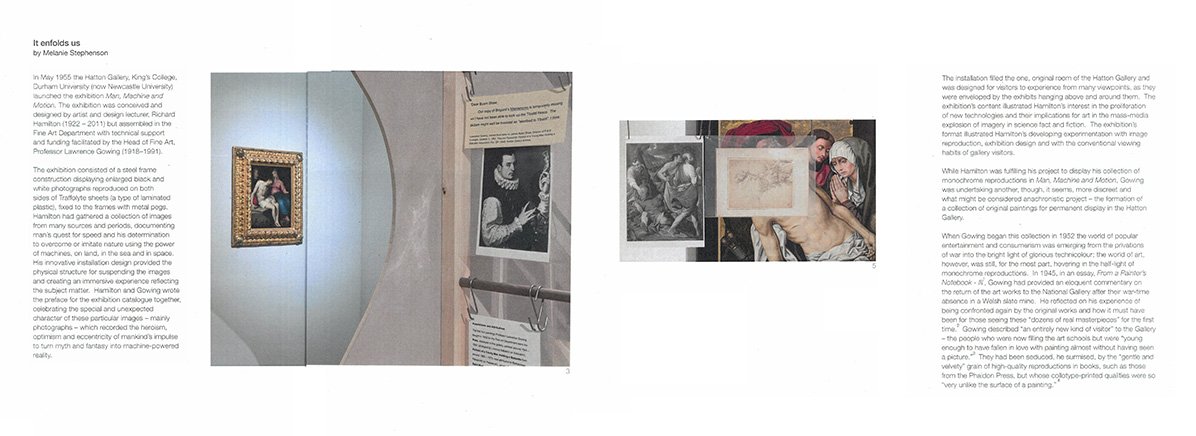
Tijana Mamula
Adaptation as Theory
My doctoral project explores the ways in which literary adaptation can be conceived and practiced as a mode of film philosophy. I look at how the process of translating between words and images provides insight into certain aspects of what cinema “is”—how it’s perceived and felt; how it interacts with memory and becomes memory itself. This research contributes to current debates around postcinema, intermediality and “uncreative” writing. I’m especially interested in adaptations of children’s literature for their ability to tread the line between fantasy and reality, and thus to become part of a child’s psychic life in ways that are often indistinguishable from physical experience. This inherent uncanniness places such works in a privileged position to theorize the primacy of audiovisual media in social and cultural consciousness.
My first film produced within the PhD is a narrative short titled The Writing Box. Set in 1939, the film follows Grace, a manipulative schoolgirl, as she schemes and dreams her way from England to India—with increasingly violent effects on the people she encounters, who do not share her racial and socioeconomic privilege. The Geraldine McCaughrean story on which the film is based is itself a postcolonial text that implicitly critiques Victorian children’s literature. My adaptation brings these references to the forefront of the narrative—embedding Grace’s actions within the very experience of consuming colonial, supremacist mythologies—and interweaves them with numerous other artworks through more experimental techniques of citation and collage. The result is a kind of Classical Hollywood-meets-conceptual poetry hybrid that retains the spirit of McCaughrean’s postcolonial critique, whilst situating Grace’s plight within a postcinematic world in which the distinction between memory and media has all but ceased to exist. The Writing Box premiered at the Visability Film Festival 2021, where it won the awards for Best Director and Best Actor.
My second film, a feature titled Hotel Savoy, takes this use of collage and citation a step further by weaving together a series of disparate sources, including books by Joseph Roth, Diana Wynne Jones and Ann Radcliffe. These serve to evoke a WWII fantasy inspired by the Kindertransport and by my own grandparents’ wartime experiences in the Independent State of Croatia, and held together by a documentary, essayistic framework built around interviews and re-enactments. Hotel Savoy continues my engagement with themes of postcinema and uncreative writing, while adding to this a more explicit reflection on adaptation’s relationship to historical trauma and postmemory.
My research is funded by the AHRC/Northern Bridge DTP.
Websites:
newcastle.academia.edu/tijanamamula
Lucy Carolan
Picturing a Cloud of Unknowing: Photography, Lostness, and Cognitive Decline
Lucy Carolan’s doctoral research is situated in the context of the increasing global prevalence of dementia, and within the growing field of contemporary photographic approaches to medical concerns.
Dementia is a collective name for progressive degenerative brain syndromes. Conditions grouped under this umbrella term – e.g. Alzheimer’s – variously affect orientation, perception and communication, and the difficulties people living with dementia experience with their senses and memories can cause them to misinterpret the world around them. The idea central to Lucy’s research is that the cognitive ambiguity that is dementia can be creatively apprehended and visualised by means of lostness as a concept, with particular focus on the agnosias – the ‘unknowings’ – experienced in neurodegenerative conditions. The project aims to develop new photographic approaches to cognition and its decline, building on the fundamental relationship that photographic imagery and its materialities have to time and space, and to our perception and understanding of the flux and fragility of memory. In the work, photography is deployed in sculptural installations, as moving image, and through the medium of artists’ books that play with form, photo-poetics, creative writing and text/image.
In the course of her PhD so far, Lucy has presented her work at the 2018 edition of Being Human Festival, the 2019 Representations of Memory in the Visual Arts seminar series (hosted by Regent’s University London), and the Northern Network of Medical Humanities Research Annual International Conference ‘(In)visibility’ in 2021. In 2019 she completed a three-month placement at the British Library, working with curators in the Contemporary British Publications department towards the development of an exhibition that will showcase approaches to memory in artists’ books drawn from the library’s collections. She has exhibited as part of the 2018 annual summer Fine Art show at Newcastle, and (pandemic permitting) intends to complete her research in exhibition, with an installation piece and a series of publications in the form of innovative artists’ books.
Lucy’s research project is funded by Northern Bridge Doctoral Training Partnership. She is also recipient of a 2021 NNMHR/Thinking Through Things ECR Support Scheme Award; this fund was granted towards the creation of an artists’ book inspired by an item in the Wellcome Collection.
https://www.instagram.com/icarousse/
Jim Lloyd
A Bird’s eye view
Jim Lloyd’s doctoral research investigates how we might seek to gain a better understanding of an avian perspective through art practice.
The context is in the crisis in the environment leading to mass species extinction and the realisation that current ways of thinking might be inadequate to solve such complex problems. Seeing from the perspective of other beings might be a critical part of the solution.
The specific questions are:
- How might multi-media art practices be developed to represent avian perception?
- To what extent can artworks based on the avian sensorium expand human environmental consciousness?
- How might video and sound installations draw upon avian perception to critique anthropocentric narratives in ecology?
The techniques involve video, photography, field sound recording, software development and writing. Recording beyond the reach of human senses, such as using UV photography or ultrasonic sound recording is one key element of the work.
A major output to date has been the construction of a device to translate birdsong into human language based on the archaic musical language “Solresol”. This is a “speculative fabulation” in the spirit of Donna Haraway’s proposition. This work will be published in the Journal for Artistic Research in 2021, was presented at the Second (Un)common Worlds Conference in Derby in November 2020 and will feature in a book of the proceedings of that conference.
Creative writing and poetry are also important elements in this research and a poem “Rainwolf” won a prize in the RSPB/Rialto “Nature and Place” competition in 2020.
The project is funded by the Arts and Humanities Research Council through the Northern Bridge Doctoral Training Partnership.
Personal Website: https://www.jamesjosephlloyd.com
Sabina Sallis
Aesthetics of Sustainability: Multimedia Visionary Scenarios for Sustainable Futures
This research seeks to contribute to an emerging field examining what an aesthetics of sustainability might look like and in particular how a critical multi-media arts practice can both inform and impact upon collective visions for a sustainable future.
This has been explored through looking at already existing sustainable land practices and traditions internationally. The research has engaged with permaculture design and re-indigenizing with local ecosystems through involvment with herbs, bees and the hive, the Voynich Manuscript, earth based metaphysics and healing practices.
By considering arts practice through the complexity and richness of synergetic systems built upon a sensitive, reciprocal relationship with the land and “more than human worlds” this has led to the development of the (S)Low Disturbance Exhibition Method (SDEM), the Apparatus for Resurgence in Trophallaxis (ART) and Multispecies Visionary Institute (MVI).
Lauren Dudley
Hubert Robert (1733 - 1808) and the Louvre during the French Revolution, c.1789 - 1798
My research is focused on the artist Hubert Robert's paintings and drawings, as well as aspects of his professional life in Paris, during the French Revolution. As a prisoner during the Reign of Terror and one of the first curators of the Republican Louvre museum, Robert directly experienced the effects of political reform and upheaval within the artistic profession. Having successfully established a career painting classical ruins and imagined landscapes, Robert produced numerous images that invited viewers to consider political events in Revolutionary Paris through the lens of classical Rome. He also appropriated several motifs associated with Rococo imagery, often referencing François Boucher’s work, that he re-signified for revolutionary audiences. My thesis argues that Robert explored political debates in his images, using the official Salon exhibition at the Louvre as a platform from which to contribute to debates about art, religion, and politics. His oeuvre is testament to the unequivocal importance of artistic responses to social change.
Lauren's PhD is funded by the AHRC.
Heather Ross
Time Past Contained in Time Present: Investigating Kurt Schwitters’ Merz Barn Wall as a Living Fragment
My practice-based project is focussed on generating new sensorial insights into Kurt Schwitters’ Merz Barn Wall (1947), situated in the Hatton Gallery since 1965. I’m interested in challenging the static and stable characterisation of the ‘Wall’ as a historical remnant of a past artwork, by exploring its time-based possibilities, multiple identities, materiality and ephemerality. I approach the ‘Wall’ as a porous structure to be disrupted, agitated, ruptured, manipulated, studied, re-configured and experienced anew, by using a variety of arts practice-based research methods.
Re-performance is used as strategy for perceiving Kurt Schwitters’ approach to site, environment and materials; past gestures and actions are restaged and used as a reflexive device to facilitate new readings. This methodology is used to contain, distribute and to synthesise archival fragments, to articulate loss and to make visible the actions of those who have been part of the ‘Wall’s’ renovation and re-contextualisation. My project affirms the historical and continued influence of conservation practice in the surveying, movement and maintenance of the ‘Wall’ as part of its re-siting in the Hatton Gallery. I’m interested in how this largely unseen activity - if made more visible - might provide new ways of connecting to the ‘Wall’s’ current and continually evolving context. In addition, how this can be articulated within and as art objects to give greater visibility to what was lost or is currently absent from the structure.
My research is funded by Northern Bridge Consortium (AHRC) and I work closely with the Hatton Gallery to create exhibitions with the intention of encouraging dialogue between exhibits, facilitating new reflections and sensory experiences of Kurt Schwitters’ Merz Barn Wall, as a time based and expansive ‘living’ fragment. Recent solo exhibitions at the Hatton Gallery have included: The Losses (2020); All The Better To Hear You With (2019) and The Loud and the Soft Speakers (2018). Recently published articles include: The Loud and the Soft Speakers: A Contemporary Iteration of Kurt Schwitters’ The Silence Poem (2020) Sch…The Journal of the Kurt Schwitters Society; Towards An Archaeology of Gesture in Kurt Schwitters’ ‘Pointless Collage’ (or how I ‘learned’ about Schwitters’ work through painting leftovers) (2018), JAWS Intellect Journal.
Website: https://www.heatherross.online
Harriet Sutcliffe
An Evolving Process - Continuing Conversations: A Practice–based Investigation into the Significance of the Role of the Exhibition, Space and Form within the Pedagogy of the Basic Course
This practice-based PhD investigates the Basic Course, which was devised and developed at King’s College Durham University (now Newcastle University) in the 1950s and 1960s, by artists and teachers Richard Hamilton and Victor Pasmore, both influential figures in the history of British Art.
The project was part of an Arts and Humanities Research Council funded Collaborative Doctoral Award (CDA) which investigated aspects of art education and culture in the North East from the 1930s to the 1970s.
The project's partner organisation was TWAM, and my project had a dual focus:
Firstly, it investigates the vital role that ‘exhibition’ played within the history of the course, posing the question: What insight can exhibition-making bring to an understanding of the Basic Course, given the prominent role within it of student and staff exhibitions? Exhibitions were used as important elements of the curriculum, both as spaces in which to develop the practices of the artists involved, and to disseminate the new shift in pedagogic ideas.
Secondly, it asks: What insight can a sculptural and installation approach bring to an understanding of the Basic Course, the outputs of which were largely two- dimensional? This enables the exploration of sculpture within the Basic Course, an area largely under-investigated in previous literature and practice.
The submission’s written component is framed around conversations with my main case study, Joan Iona Clift. As an artist, alumni, sculptor and teacher, Clift provides crucial, critical insight into the course, and contributes a much-needed female voice to existing accounts of, and current debates around, the Basic Course.
Through a mixed methodological approach - creative practice, archival research and interviews, new insights into the nature and significance of the Basic Course have emerged. The research also reveals elements of the history of the Basic Course that firmly place the North East, and particularly the University and the Hatton Gallery, back into focus as a major contributor to a significant moment of change in the thinking and practice of Fine Art education in the UK.
Qirui Tan
Surrealism and Architecture
Qirui Tan’s work as an artist and researcher focuses on the relationship between painting and architecture. The research is a cross-disciplinary one which tries to combine fine art with architecture. To be more specific, he focuses on how the methods and ideas of Surrealism can be used to re-examine architecture and space in the context of postmodernism.
The research will involve artistic practice and writing in an attempt to provide a definition of Modelscape: an alternative architectural space consisting of paintings, drawings and architectural installations. The aim is to apply my fine art practice to interdisciplinary purposes and contribute new knowledge to the understanding of the bridges and interstices between fine art, architecture and space.
Qirui Tan’s personal website: https://519328993.wixsite.com/mysite
James Quin
The Temporal Conditions of the Static Image: Repetition as an Engine of Difference
Research Questions.
- How does repetition reposition the temporal conditions of the static painted image?
- What are the operational means of repetition as an engine of difference?
- How does repetition temporalise the space of its encounter?
Quin’s AHRC funded PhD research project examined the temporal conditions of painting and the potential for repetitive strategies in re-thinking these conditions in ways that move beyond those ascribed to painting by convention. Starting from the premise that repetition is an engine of difference, Quin is also interested in the ways that an encounter with repeating images, specifically painting, temporalises the space of their encounter. In order to test the temporal conditions of the static painted image and the temporalisation of space, Quin explores the role of parallax motion in relation to paintings exhibited in series within labyrinthine installation spaces. Quin’s Phd, completed in 2018 was supervised by Professor Richard Talbot and Professor Christopher Jones.
Quin’s ongoing research explores the potential for motion tracking technologies to examine the ways in an audience’s encounter with repeating painted images temporalise space. The context for this research is an interest in the ways that contemporary artists such as R.H Quaytman use repetitive and paratactic strategies to construct relations between painting, time, and the space of their encounter.
Recent exhibitions have included The BEEP Painting Biennial, Elysium Gallery, Swansea (2020), Enough is Definitely Enough, The General Practice Gallery, Lincoln, Oceans Apart Gallery, Salford, and Pineapple Black Gallery, Middleborough (2021), and Vitalistic Fantasies, The Cello Factory, London (2020).
James is now Lecturer in Fine Art at Lancaster University.
Website: http://james-quin.blogspot.com/
Anthony Schrag
State Craft: Participatory Arts and Conflict, Beyond the Administered World
The aim of this practice-led PhD research project was to explore the role of conflict in participatory artworks carried out in a policy-related context. The key question was – how is conflict important for socially engaged practice?
I configured the research around three key themes that are posed below with additional research questions:
- Physicality: How can physicality be used a “generative metaphor” for critique?
- Role of the Artist: What is the role of the artist within participatory practices, and how can he/she create and/or encourage agency within the participants?
- Policy: As the main ‘producer’ of participatory art projects, how can conflict impact (and be impacted by) cultural policy?
This research works on the hypothesis that conflict can reveal a plurality of voices, engender debate, add to public knowledge, entrench alliances, and be the tool by which groups and individuals navigate their interrelationships. It is this tension between the positive attributes of conflict and its absence within policy that lies at the core of my research.
I collaborated with policy makers/implementers (i.e. local authorities) to develop projects that will allow me to examine the central themes of my research:
- Physicality: Within my discursive text and within my practice, I would like to explore how participatory projects that involve a heightened notion of physicality (such as Boal’s Theatre of the Oppressed, 1971) can induce an alternative language of critique to other less-successful forms of didactic and pedagogic attempts at criticality.
- The Role of The Artist: Artists such as Autur Zmejewski and Christoph Schlingensief problematize participatory projects by complicating the role of the artist within the production of work – Is the work for certain people? By certain people? With certain people? Does the artist create more agency for participants or less? And how is the work framed within an “art institution?”
- Policy: As local authorities fund more socially engaged projects they increasingly become “producers” of art projects with specific outcomes in order to justify their funding. As such, there is a specific remit that limits the outreach/participatory projects to those specific outcomes, creating a feedback loop that does not allow for criticality. By basing myself within council settings and policy-implementers (i.e., Local Authority run galleries & museums) I explore how conflict can intervene into these loops and offer criticality.
To develop this unique research, I worked on residency-like situations with local authorities to create original works of different scales/intentions that explore the interface between policy and conflict. I primarily employed a strategy of “Participation Action” with policy makers/implementers as well as communities, reinforced with feedback and interviews pre- and post- each project. A key text here is Sophie Hope’s Participating in the Wrong Way which will keep these methodologies relevant to the subject area.
Anthony is now Senior Lecturer in Arts Management and Cultural Policy at Queen Margaret University, Edinburgh. His PhD research was funded by the AHRC.
Janet Lambert
Experiencing Place: Mapping Connectivity In The North Pennines
This exploration of a rural landscape through diverse yet interlaced approaches was a study in mapping connectivity through transcribing subjective experience of the place. The research area was defined by the boundary of Bruthwaite Forest, a medieval hunting forest in the Cumbrian North Pennines.
Detailed observation and research provoked artworks reflecting integration with the continuum of past and present, responding to the geological, topographical, ecological and historical characteristics of these uplands, and engaging with ideas of change and chance. Impermanence in the landscape was celebrated through artworks engaging with structural decay, the topography of place-names, and the human traits of finding and collection. The challenge underlying the research aims was not only to make a profound connection with a place but to find ways of communicating this connection visually. The thesis drew together a textual and visual narrative of those characteristics of the local history and topography that inspired the artworks that embody the material reality of the landscape, while the photographic and ceramic artworks act as a stimulus to reflection on the human place within the natural world.
At the core of the study is the ordinary activity of walking, a fundamentally defining human behaviour. From the outset the character of this walking was in the spirit of the dérive, random walking open to surprise, curiosity and chance encounter. This approach generated a heterogeneous collection of thoughts and interests, as stimuli reached the brain via byways and meanders spontaneously followed.
The documenting of change and movement, finding and collecting, gave rise to artworks that reflect an interest in vernacular structures, the names people give to places, and the detritus of ordinary lives. They map a growing understanding of this landscape and its idiosyncrasies, and an exploration of the sort of relationship one can have with a place, an experiment in how closely one can approach the primal sense of belonging through engagement, intense absorption, and random wandering.
Parcelling human knowledge or natural behaviour into separate disciplines or enclosed fields is antithetical to my understanding of the world. Culture is about cultivation of the earth and the mind alike, and the branch is part of the tree, an almost infinite organism. Our language itself thus refutes the Cartesian divide. Following molehills introduces a gentle anarchy and a fruitful illogic, and their seemingly random ubiquity made them an appropriate linking theme for my own wanderings. To find things lost in the earth I enlisted the mole in making play with the unpredictable, inviting the synchronicity of the creative moment.
Sand, lime and stone for local buildings all came from quarries nearby, and until the early twentieth century so did the thatch for roofing. Since the demise of local industry and the redundancy of many buildings, these materials are slowly sinking to the ground, mingling with Darwin’s ‘vegetable mould’ produced by earthworms, which plants then begin to colonise. The process of structural decay, from the lichens on the stone walls to the willowherb nourished by rotting timber lintels, is evidence of the lack of separation between natural events and human endeavour.
The camera can capture arrested time in an oak leaf frozen into water that has ceased to flow, or the memory of water in a time of flood returning to its course of centuries before. Fleeting glimpses of ephemera driven by wind and water are balanced by the gravitational pull of a derelict house towards its foundations in the earth. Falling Leaves demonstrates entropy and embodies decay. This is a fragile work, a prototype pile of sheets of thinly rolled clay stamped with place-names which, surprisingly, has survived while shedding fragments along the way.
How do discarded artefacts come to be where we find them? Some are airborne, like seeds blown on the wind, but most travel on and under the ground. The appeal of surface finds is their tangible yet impenetrable link with the past; in the depth of the soil is a depth of memory. The journey of the object is affected by many agents including humans, wind and rain, weathering and erosion, moles, rabbits and earthworms, accident or coincidence. Artefacts are thrown up, or buried, in a continual repositioning of things in time and space. A collection of fragmentary and abraded artefacts from the environs of former dwellings may eventually constitute the only reminder of lives once lived within their now tumbled walls. To record, collect and document is to pay tribute to past communities of people of whom we know almost nothing yet whose actions shaped the landscape in which we now live.
To create new artefacts that celebrate our connection with the substance of the landscape, I employed the ordinary materials of everyday life, exemplified by pottery. The decision to use locally sourced boulder clay transformed the experience, as the physical effort involved in collecting and preparing the raw material made a clear connection with the environment even before pots and tiles were made.
The investigation into local place-names led to more encounters with entropic process, deciphering maps that had endured centuries of use and damage through handling to the extent that some are fragmentary. Some of the names lifted from these maps have likewise drifted free from their locations in the landscape, and I attempted to re-place them where possible, bringing back into current memory names and places which were once common knowledge. The topography and climate were fundamental to the experience of the people who first passed through the area or lived here a thousand and more years ago. To reach back to those first settlers, and to see the place through their eyes, I related the place-names to the land they describe, bringing the story up to date with a survey of field-names used by people who live here now.
Janet's PhD research was funded by the AHRC.
Further information on this research can be found at: hdl.handle.net/10443/1149
Tim Shaw
Listening Through Making: Artistic approaches to sound, technology and field recording.
This thesis draws on notions of ‘thinking through making’ to consider how the act of field recording reveals new ways of thinking about how technology shapes sonic experience. Within sound art practice, evidence of the act of making audio recordings is commonly removed from or aesthetically neglected in the context of public presentation or performance; sound recordist and recording technology are made invisible to the audience. Rather than concealing the act of recording, the artistic projects presented in this thesis explore methods for engaging publics in the practical activity and particular material qualities of field recording.
Three artworks are presented that employ and examine field recording practices; a musical performance (Fields, 2014-2018), a sound walk (Ambulation, 2015-2018) and a sound installation (Ring Network, 2016-2018). Particular elements of the making processes, the technical materials employed, publicly manifested artworks and critical reflection thereon are shared alongside a supporting portfolio of documentation and presentation details (this can be found in the appendices and accompanying USB storage device). The written component of this PhD submission offers an additional access point into this body of work and is designed to accompany rather than stand in for the practice itself.
The artworks presented in the thesis were developed in relation to a programme of ‘experiments’ conducted within a number of different cultural institutions. The thesis defines these experiments as an artistic and research methodology, and describes how the process allowed for multiple lines of enquiry and numerous artistic outcomes to be explored in relation to specific thematic, material and contextual concerns relating to sound and technology. The learning that emerged during the creation of each artwork, through field recording and the making activities, contributes to dialogues surrounding practice-based research and the value of artistic practice within academic contexts.
Research findings emerging from this thesis offer insight to artists and researchers interested in field recording and electroacoustic music, performance and liveness, sound and technology and making as a research methodology. To the diverse fields of sound art practice, sound studies and soundscape research, which this research is situated within, particular themes relating to sound and technology are also addressed. They include; critical reflection of field recording and electroacoustic practices and technologies, revealing the technological characteristics of creative systems through sound, liveness in relation to digital media, the use of listening technology to extend human perception, approaching technology as a material process and making as a research methodology. Discussion of these specific themes contributes to understandings of the role of listening in art practice, anti-solutionist approaches to technology, creating arenas for attentiveness in performance and sound walking. The work presented in this thesis extends Ingold’s terminology of thinking through making to working with technologies associated with sound and media art practice.
Tim is now Lecturer in Digital Media at Newcastle University. His research was funded by the AHRC.
Tom Schofield
Materiality and making in experiential ecologies.
This thesis and the accompanying artworks articulated the following research question: What is the role of materiality in ecologies of technological experiences and how can (and do) artists and designers design for and with it?
Theories and practices which design for and with digital technologies have expanded from their roots in computer science and electronics to become involved in diverse areas of research across the humanities as well as scientific and design disciplines. With that expansion, and particularly since the birth of the world-wide-web, researchers have sought to analyse the impact of such technologies in culture.
From the late 1990's some influential research (such as (Negroponte, 1996), (Mitchell W. J., 2000)) stressed the immateriality of digital technologies focusing, for example, on the interchangeability of digital information and the de-spatialising effect of the net. This thesis argues that this view remains a pervasive one. More recently though, and in response, an interest has developed in the nature of the materiality of digital technologies.
This materiality is expressed and investigated in a number of different ways. Some research (such as (Wiberg, 2013) (Drucker, 2013)) has focused on formal qualities of materiality, such as physical shape, texture and colour. Others focus on a broader notion of materiality in terms of objecthood. Still others differentiate objecthood from 'thingness'; the quality of being a thing.
This thesis first examines a range of research on materiality and from analysis of this, and from practice-based research in the form of the creation of artworks, develops a formula of five separate facets of materiality. These are developed through making and analysis to form a framework to inform designing and making for and with technology. The facets of materiality developed are; performative; distributed; spatio-temporal; fragile; and future-oriented.
The framework developed positions design and making within a context of 'experiential ecologies' and theorises the role of materiality within such ecologies. Experiential ecologies build on and integrate previous strands of research which have emphasised the impact of infrastructure on experience (such as (Dourish & Bell, 2011), (Star & Ruhleder, 1994)), the agency of non-humans (such as (Latour, 1993), (Bennet, 2010) and the aesthetics of experiences with technology (such as (Dewey, Art as Experience, 2005 (1934)), (McCarthy & Wright, 2004)). This thesis adds a techno-historical dimension to the concept of an ecology, and proposes ways in which contemporary technological experience is historically founded in ecologies.
Tom is now Senior Lecturer in Digital Cultures at Newcastle University. His PhD research was funded by the AHRC.
Peter Merrington
Curating post-traditional art festivals: The analysis and development of site responsive strategies
The aim of this research is to provide a new critical framework for analysing and developing contemporary, post-traditional art festival curatorial strategies, seeking to redraw them as questioning, critical entities within public culture. The research sits in a productive but under-developed area between contemporary art practice, curatorship, festival studies and theories of site, space and place.
The objectives of the research are being addressed through a series of critical case studies of contemporary, post-traditional festivals and artistic practice in Europe, underpinning this area of the research is a series of questions centred on festivals and curation, including:
- how have experimental arts festivals developed across Europe, particularly since 1989?
- what are the differing roles of spectatorship and participation within the festival?
- how do festivals engage their spatial context, particularly urban space?
- how can the festival act as an intervention both within public culture and existing institutional structures?
- how can festival curation in relation to space, place and site be theorised?
- what is the role of the curator in mediating issues of space and place in relation to that of the artist?
The research is a partnership between AV Festival and Newcastle University’s Fine Art Department, supported by the International Centre for Cultural and Heritage Studies. It is funded through an Arts & Humanities Research Council (AHRC) Collaborative Doctoral Award.
Peter is now a researcher at Glasgow University.
Hazel Barron-Cooper
Digging Deep: Unearthing the Genius Loci
This PhD examines the visual representation of sense of place and the human compulsion to observe, record, and map the rural landscape.
It looks at art as a conduit for this compulsion and the ways in which the artist responds to the landscape and local distinctiveness. Can the artist undertake the role of conduit between people and place by instigating community participation, working with local people bringing together the threads of material and intangible culture? Is the artist able to assist in revealing and preserving disappearing dialect words, customs, folklore and other elements which contribute to local distinctiveness?
Ancient sites, place names, weather terminology, dialect for geographical features and occupational terms, customs and folklore particular to a focused area in Northumberland are investigated and recorded.
Three specific sites in Tynedale, on or near Hadrian’s Wall, are the focus of the research: Beltingham, Brocolitia and Heavenfield. The project employs investigating archival research and fieldwork, out walking in the landscape, observing, recording, drawing, painting and writing. The study also explores how artists can work with archaeologists in interpreting significance of place and how visual art can act as an interface.
The role of an artist as a conduit between people and place is also at the heart of the research. As the uniqueness of a place is unearthed and revealed, the local community are involved, consulted and engaged in the process of revealing the layers of their locale. Local people are interviewed, and events are held at community venues where the public will be able to add to the data gathered about their area. By consulting with the community discovering and documenting oral histories, disappearing words and customs, focusing on three ancient sites in the Northumbrian landscape and gathering local knowledge, new information will be added to academic knowledge.
Website: hazelbarroncooperartist.com
Amy Dover
Re-wilding our Imagination.
Amy Dover’s doctoral research looks to study the impact and relevance of animal drawing on conservation. This project recognises that myths that are perpetuated within images perpetuate myths within culture and consequently our understanding of other species - thus reinforcing ‘othering’ and ‘speciesism’. We often 'other' non-humans - our attitudes still dominated by the Cartesian perspective that we have dominion over all other species. In the time of mass extinctions and the Anthropocene, the human perception of dominance over nature is dangerous, and could in the end lead to our own extinction.
Questions: How does drawing shape our perceptions of non-human animals and what visual constructs are used to create “speciesism” and aspects of the “other”? How can contemporary drawing generate empathy towards those animals? How does historical drawing embed or change our perception of now extinct animals and how can the creation of new visual representations of animals expose current myths, and help in the advocacy and act of conservation?
Dover has exhibited internationally including LA, London, Sweden, South America, Edinburgh and Newcastle. She also works as an illustrator and has worked for clients such as The Scottish Government, M&S, World Animal Protection, Target and many more.
Johanna Latchem
The Art of Justice: Reconfiguring the Courtroom Object
I am a visual artist working in site-specific installations that address the phenomenology of legal process. My PhD research was co-supervised in History and completed in 2019 and I made large-scale works that intervened in the material culture of the courthouse to inform public understandings of the law, challenge traditional court rituals and expose the need for new ceremonies and rites to convey messages that are suitable in the present day. They are located in courts, the street and galleries and involve digital media, archive material, sound, performance, and audience participants.
I have worked in the historic courthouse environment to gather data on courtroom acoustics that revealed how the architecture and acoustics of the court silenced, or facilitated, those involved in judicial hearings. These datasets, along with visualisations of the sound movement within the space and archival research, have been employed as a source for producing site-specific artworks. I have devised performative street processions using revised courtroom objects I made and through such practice, interrogated historic legal and museum narratives that are not inclusive of the voice of women.
The courtroom object at the centre of my research was the Admiralty’s silver oar. It has its origins in the earliest admiralty court, during the reign of King Edward III in the 1360s. It was the only courtroom object processed to the gallows and it is still processed and displayed in courtrooms in the UK and globally today.
Since completing my PhD I have been a Visiting Academic at Oxford University in the Faculty of Law, Centre for Socio-legal Studies and have published in the journal Law and Humanities. My current practice and academic research focus on contemporary and historic sex workers and court. Working with contemporary sex workers’ stories and an under-utilised c19th archive in the Bodleian Library Oxford offers, through practice, a reflection on continuities and disruptions in accounts of prostitution and sex work over time, through film and object-hood. It aims to expose and disrupt a little-known history of the Chancellor’s Court, highlighting the disproportionate number of cases for prostitution it heard.
I am also coordinator of the Screening Rights international film festival based in the West Midlands.
Dan Goodman
System Gallery
What Forms of Value Are Generated Through the Everyday Activity of Artist-Run Initiatives as Understood Through an Arts Practice-Based Autoethnographic Account as System Director?
This study connects the personal understandings of forms of value generation within artist-run initiatives (ARIs) as director of System (Gallery) to cultural policy makers and public funders’ understandings of it. Drawing on my own experiences as director of System, I will offer a first-hand and reflexive perspective of the forms of value generated and how it is generated. These findings will be critically extended through interviews conducted with artists that have exhibited at System.
Jez Coram
Essay Zones and Image Things: ways of thinking in expanded essay films
A practice-led research project that critiques ways of aesthetic, political and technological thinking within the formal properties of expanded essay film works, including the architecture, assemblage and apparatus. This focus positions my research contribution as a small step towards widening the dominant research focus on the single channel essay film and instead considers five expansions on the act of essaying and how the essay form may exist using a range of expanded formal aesthetic and technological translations. Thus, taking into account the impact of post-cinematic theory and spatial and networked technologies on moving image making and locating these translations amongst contemporary essay works in an essayistic family of resemblances.
I am using a creative critical methodology to produce a collection of 10 essays that will make up the body of the written submission. Each essay contains aphorisms, a vocabulary of terms discovered during the research, and fragmentary findings from my journals and note books, supported by a critical commentary. There is also an intertextual photo essay joining each section and a map of the essays or zones.
Jack Laidlaw
Maximalism: An Exploratory Framework via Interdisciplinary Creative Digital Practice
This research will adopt and extend existing theories of, and practice embodying “maximalism” through creative and analytical approaches in the context of interdisciplinary digital practice. Outputs will include audiovisual works combining moving image, sound, and interactivity in both online and ‘live’ environments. The research will not seek a canonical definition for “maximalism” in this context, rather it will produce exemplar works and an actionable framework for other practitioners seeking inroads into the aesthetic.
Exhibits will be documented by video recording and will be live-streamed where appropriate. Practical outputs will be described in a thesis of approximately 30,000 words which will document theoretical background, the core concepts explored, the aesthetic choices made, and any custom tools created. These will be drawn together to produce a framework for exploring maximalism in creative digital practice and the suite of tools, along with the works themselves will constitute the contribution of the research.
Isabella Streffen
I Spy With My Military Eye
Isabella Streffen completed her PhD in 2013. I Spy With My Military Eye was funded by the Arts & Humanities Research Council, and exposed similarities between military doctrine and the development of artwork to demonstrate the efficacy of using fine art practice as a method for critiquing militarism. Key questions relate to the identification of a specifically military vision, the development of ‘visioning technologies’, and their impact on subjectivity and objectivity.
Isabella developed her pseudo-ethnographic field-craft methodology to produce Dead Reckoning (2009), a geo-caching game devised on site in Northumberland and Cumbria with military snipers; The Model (2009-11), exhibited at Alderman Fenwick’s House in 2012; Illuminating Hadrian’s Wall (2010), which lit the 84-mile long Scheduled Ancient Monument from end-to-end as part of an artist residency at the UNESCO World Heritage Site at Hadrian’s Wall; and Hawk & Dove (2012), originally devised during a research fellowship at the Library of Congress and initially exhibited as an architectural installation as part of Washington DC’s inaugural public art festival 5x5.
Other exhibitions and events in 2012/13 include convening Surreptitious Networks at the Tyneside Cinema; curating Drones Baby Drones (touring); and Magnificent Distance at Globe Gallery. Her article The Underlying Horror of the English Countryside appeared in Dandelion Journal vol 5, and she has written for Dean Clough Galleries, Situations and AN.
Isabella became an Early Career Research Fellow at Oxford Brookes University, where she continued her research into drones, aerial culture, intelligence practices and contested spaces. She was also a post--‐doctoral research associate in English & American Studies at the University of Manchester, where she co-curated Show Me The Money: images of finance 1700 to the present with Alistair Robinson for the Northern Gallery of Contemporary Art. She was previously a post-doctoral researcher at CRUMB and is now a Lecturer in Fine Art at De Montfort University.
Website: https://www.isabellastreffen.com/
Michael Mulvihill
This research investigated how creative activity can be used as a method to make visible the way in which nuclear weapons have influenced and structured the way we experience our social and cultural environment. This working was realized as the first ever artist in residence at RAF Fylingdales. It was funded through AHRC Northern Bridge Doctoral Training Partnership (AHRC NBDTP).
Linked to this activity I worked with English Heritage as an assistant curator in their Cold War Collections, which is composed of materialities from the UK governments preparation for nuclear war between 1946 and 1992. This has resulted in a report making recommendation regarding how English Heritage acquire knowledge about the collection, conserve key elements and engage the public.
I was Associate Producer on A British Guide to the End of the World (2019) an Erica Starling production for BBC Four Arena series, directed by BAFTA winner Dan Vernon. The 70-minute film emerged from my research at RAF Fylingdales and with English Heritage.
https://www.bbc.co.uk/iplayer/episode/m000b1gn/arena-a-british-guide-to-the-end-of-the-world
I am now Co Investigator for AHRC funded project 'Turning Fylingdales Inside Out: making practice visible at the UK’s ballistic missile early warning and space monitoring station.' 2020-2023. This research is being carried out by an interdisciplinary research team who seek to understand how RAF Fylingdales, has historically and currently interacts with its environment through various practices, and cultural productions to produce multi-scaled geopolitical and social spaces.
A major outcome of this research will be an online archive that will allow the public to search and view RAF Fylingdales collection of objects and materials it has amassed since becoming operational on 17th September 1963, and more information about the project can be found here:
Prior to this research I held a Leverhulme Artist in Residence with the Military War and Security Research Group in the School of Geography Politics and Sociology at Newcastle University. This work resulted in an exhibition called Standby for the New Stone Age (2015) that intervened amongst the artefacts at English Heritage’s York Group 20 ROC HQ museum to mark the 70th Anniversary of Operation Trinity, the first nuclear detonation. Additionally I have recently shown work in solo exhibitions A Mid-Century Modern (2015, Berwick Gymnasium Gallery), The Means and the Instruments (2015, Northern Gallery for Contemporary Art, Sunderland) and I featured in the group show They used to call it the Moon (2014, BALTIC Centre for Contemporary Art, Gateshead). I took part in the 4th Ghetto Biennale: Kreyol, Vodou, and the Lakou: Forms of Resistance (2015) in Port-au-Prince, Haiti with a project called Charcoal. I am represented by VANE Gallery, Newcastle-upon-Tyne who have recently shown my work in the group exhibitions Vicennial (2017, Vane Gallery, Newcastle-upon-Tyne), Seeing a Who (2016, with Art Helix, Brooklyn, New York) and The Karman Line (2016, with Object A, Manchester).
Gareth Hudson
Removing the Frame - The advancement of projection and the re-establishing of auratic art in the moving image
This PhD investigated and employed the techniques and technologies of Projection Art, in engagement with the existing discipline of Video Art, in order to explore transcendent and spiritual experience.
In a time when Video Art is reproducible across varying formats, transferred without loss through the immateriality of the internet, and its established forms of practice are being commodified and safeguarded by galleries, Projection Art techniques, such as video mapping, are a welcome advancement of the moving image in art. The processes are often highly site-specific, with much of the work conducted in situ.
Projection Art often combines the plasticity of sculptural or architectural forms with the ephemerality of light installation, often in conjunction with soundscapes. It is often temporarily installed with no commercial or collectable value akin to the avant-garde practices of conceptualism, but unlike these practices, the focus remains on the art object, not on the processes of the art production. . It is because of these qualities that I think it can re-establish what Walter Benjamin coined the "aura" of art, a reverence of the "here and now" and "distance-no-matter-how-near” in the age of digital media.
While more traditional Video Art practices are viewed within a frame, flat, bound by the conventions of the moving image and easily reproduced, Projection Art creates an experience that is unique and individual to its installation. It can still inspire an experience of immersion that the framed video alone cannot. This artistic research will employ these immersive qualities to explore the phenomena of transcendent and spiritual experience.
As an artist, I am interested in creating works which attempt to appeal to the transcendental sensibilities of their audience, prompting them to reflect upon experiences that occur at the margins of our lives in society. Artists – of the past, such as Wassily Kandinsky, and of the present, such as Bill Viola – have been concerned with creating art which elicits, as Kandinsky put it ‘emotion beyond words’, and expressing the spirituality of humanity. My aim is neither to create art which examines religion, nor which expresses spirituality, but to engage with transcendental and spiritual experience in a way which highlights the commonalities between the viewpoints of the secular and the sacred, without reducing one to the other. I intend to create work which, when placed within sacred spaces like churches, complements and affirms their intended atmosphere. I will also create, in secular spaces such as galleries, installations which themselves constitute spaces of secular or sacred spirituality or religiosity.
Projection Art has a history rooted within the phantasmagoria, perspective illusion and video sculpture (especially those of Tony Oursler) but remains relatively under-critiqued and unexplored within the Arts. Artists such as Joanie Lemercier, Roberto Fazio and Elliott Woods, who fill an odd remit between artist, designer and programmer, lead the field. Using a practice-led approach I aimed to advance my study and experimentation with the software, technology, techniques and theory behind Projection Art, whilst exploring the idea of immersive transcendent and spiritual experiences.
Gareth's project was funded by the AHRC. He is now a Lecturer at the University of Huddersfield.
Ruth Barker
A Gilgamesh Cycle
Ruth Barker is a Glasgow-based artist, whose work is performance-based. In Barker’s work, the re-telling of ancient myths through original poetic composition becomes a gesture towards the ritual understanding of self, gender, and mortality. For A Gilgamesh Cycle, Barker developed a series of new works, which re-composed the ancient Mesopotamian epic of Gilgamesh through the lens of her own unconscious associations, experience of the contemporary world, and mythological research.
The performance poems that make up the Cycle are hypnotic, ritualised events. Barker’s words are recited from memory with a concentrated focus that becomes by turns magical, claustrophobic, and cathartic. The performances incorporate lavish performance garments, bespoke creations that are commissioned for each work from fashion designers with whom Barker works.
The epic of Gilgamesh is a myth from ancient Iraq that explores some of the biggest questions about love, loss, mortality and immortality. By making this work, and by reflecting upon it, Barker is exploring what the impulses are that push her to retell these ancient stories. What does she wish to achieve by doing this, and what might that tell us about art, or myth, or the human condition more generally?
This research project is developed in the context of Barker’s inquiry into why some artists (including herself) feel drawn to work with ancient myths in this way. The study contextualises Barker’s experiences alongside the perspectives of other artists, and examines the decision-making and composition within her practice in relation to the approaches of other artists who work in similar ways.
This process hopes to illuminate the intentions behind – and implications of – these artists’ work. Drawing on the work of theorists such as Jan Verwoert, Kaja Silverman, and Carl Jung, the study explores what these practices reveal about the relationships between psychoanalytic readings of the unconscious, the alogical structures of performance composition, and the role of the artist as a metaphorical seer, medium, or shaman.
Key to this study’s development is Kaja Silverman’s writing on ontological similitude, and her argument for recognising the deep commonality between ourselves and the world. When we look most deeply inside ourselves, to the most intimate, private folds of our being, perhaps we can see not what makes us individual but what connects us to other people.
Research Questions
In what ways is my own creative practice echoed by those of other performance art practitioners who retell ancient myths? (What are the motifs that these practices share?)
What can these motifs reveal about how and why ancient myths are still informing the creative practice of these performance artists?
Methodology
Through keeping an ongoing blog, Barker charted the conscious decision-making and intuitive processes involved in the development of new work, and used this as a way to explore her own subjective experience of writing, composing, editing, and performing. A total of 5 new performances have so far been made, documented, and analysed. These new works range from approximately 20 minutes to 6.5 hours in length, and all have been publicly performed.
To Sing of Gilgamesh (Performance, 20 minutes pprox.., 2012), and Gilgamesh Song (Single channel video, 12 minutes, 2012), take Gilgamesh from the clay and build his likeness on a kitchen table. The works find certainty in the things that are known and not known, and peer at death through the glass of someone’s front door.
Of Gilgamesh, And Others (performance, maximum length 6.5 hours, 2012 – 2013), attempts to tell the whole of the Gilgamesh epic, but tangles it through the artist’s own life and images. Through Barker’s attempts to retell this ancient story, it becomes apparent that the epic is ungraspable – an amorphous, ever changing narrative that has been re-imagined and re-shaped by every teller who has ever adopted it. The story of Gilgamesh, as it appears in Of Gilgamesh, And Others, is too long to hear during one gallery sitting.
Mouth Open In An Open O (performance, 25 minutes pprox.., 2012), is a vegetation myth that takes the form of a single calendar year running from September to September. The work is a tightly structured sequence of images of dreaming, growing, joining, and losing, which closes with Gilgamesh awake / asleep on the beach at the end of the world.
A Love Song, For Gilgamesh (performance, 20 minutes pprox.., 2013), focuses on the final section of the epic, and imagines the dead Enkidu calling Gilgamesh back from his failed search for immortality. As with all the works in the Cycle, A Love Song synthesises Barker’s personal images, partly drawn from her own unconscious associative responses, with an understanding of the structure and content of the source myth.
In relation to her own work, Barker is examining the practices of Rachel Rosenthal, Joan Jonas, Meredith Monk, and Danai Anesiandou. Exploring similarities in compositional structure, creative methodologies, and subject matter is revealing repeated motifs that, when viewed in relation to the work of thinkers such as Kaja Silverman, shed light on the wider questions regarding why as well as how ancient myths are being retold in this context.
The performances that comprised this research project have been presented at venues including the Cornerhouse, Manchester; The Agency Gallery, London; the SS Rotterdam, NL; and Camden Arts Centre, London.
Jason Dee
Out of body experiences: a practice-led evaluation of the shifting boundaries shared by analogue films and their digital counterparts.
Jason Dee’s practice-led research used digital technology to distort the previously fixed spatial and temporal boundaries of 20th-century analogue films. This approach works in conjunction with installation techniques that alter cinema’s carefully aligned layout of projector, screen and audience. These two methods combine to reveal the fragmented structure and viewpoints of a hybrid medium that has been in a constant state of flux and renewal for over a century.
Cinema has always been a layered form of ‘out of body’ experience: the physical film-strip has its animated, ephemeral shadow projected onto a screen, which is in turn transformed from an object to a ‘window’ that pulls the viewer into the film world, leaving their bodies sat motionless in the dark.
Digital transfer both heightens and, paradoxically, reveals this process: the material structure of the filmstrip becomes as illusory as the narratives it once contained, suspending its ‘body’ in a form of immaterial digital afterlife. Yet the alternative viewing patterns allowed by this new media also help to reveal the filmstrip’s physical structure, creating a self-reflexive distance unattainable to 20th-century cinema audiences.
Digitally altering the temporal structure of a film space (by freezing, or looping scenes) cuts it off from the viewer’s own space and time. Similarly, by shifting cinema’s traditional layout to a gallery setting, viewers are invited to step back and contemplate the ill-fitting relationship between the screen, projector and their own shifting viewpoint that the installation creates.
By using these methods, this work places viewers in shifting hybrid zones that allow their perception to oscillate between awareness of, and surrender to, the physical and illusory aspects of cinema.
From this alternative angle a new light is shone onto old recordings and viewing methods. The fractured worlds revealed by this approach are not intended to highlight the ‘fakeness’ or obsolescence of film; instead these structural gaps reveal the outer limits and hidden layers within which previously unseen aspects of past recordings are stored.
These installations offer a unique insight into how digital transfers both duplicate and subtly undermine analogue film’s carefully constructed worlds, shifting its fixed boundaries and framed structure to reveal underlying anxieties and contingent qualities previously hidden at the edges, or below the surface of film narratives. In this context by exposing and altering film’s underlying form, the influence of its structure on our own subjective sense of being, perceiving and remembering is brought to the surface.
Jason was the 2013 winner of the AVANCA | CINEMA 2013 – International Conference prize, with his paper "Celluloid´s Digital Other".
Jason's PhD research was funded by the AHRC. He is now Lecturer in Photography at The University for the Creative Arts.
For further information, please visit: www.jasondee.co.uk
Fang Qi Colbert
Spatialising narrative pictures: Transforming 2D narrative drawing/illustration in to video installations
Qi Fang is an artist, researcher and illustrator who completed her practice-based PhD in 2019. The research investigated the processes and problems, both practical and conceptual, involved in the transformation of her small-scale two-dimensional narrative drawings into immersive video installations based on self-narratives on the dramatic social reformation in contemporary China. The aim of this transformation between 2D and 3D was to increase the active involvement and engagement of the viewer and to enhance the open narrative/s reflecting on re-construction of the fragmented identities.
As an artist coming to this inquiry from a drawing/illustration background, the three key concerns and questions were: how to transform a two-dimensional narrative illustration into an installation without losing the drawing/painting quality? When transformed into a video installation, what changes happen to the narrative and to the audience’s engagement and self-awareness, and subsequently the audience’s understanding of the narrative? How can technology, sculpture, installation, and video projection be used to develop and enhance the drawings.
The research used art practice and exhibition and led to exhibitions By No Definition (2015), Northern Landscapes: Picture Poems (2016), The Outsiders (2017) at Newcastle University and The Reversible Future (2016) at Abject Gallery, Breeze Creatives. These research outcomes were published in Art Review Magazine Issue 50, 2019, Speech The Meanings of Transformation, Beijing University of Agriculture, 2019, The Urgency of Art, Royal College of Art, 2019, Evolving Fields - Sensoriality, Imagination and Memory in the Humanities Experience, Queen’s University Belfast, 2017, Experimental Illustrations for BA students, Portsmouth University, 2016.
Qi’s video installations revealed the paradoxical relationship between two-dimensional pictorial space and installation space: by projecting drawn images/videos, the artist turned the physical space to be walk-in ‘pictures’, however at the cost of cancelling out the pictorial space and thus went beyond the definition of ‘drawing’.
Artist website: https://qifang.wixsite.com/qifangcolbert
Kate Stobbart
It's not what you do it's the way that you do it
This investigation aimed to answer the following questions.
- How can re-presentation of non-verbal communication manifest as art?
- What are artistic equivalents of empathy and rapport?
- How can the working methods used in medical practice influence the production of art?
The research builds upon my previous work, which examined the non-verbal communication of prominent politicians/celebrities during some of their public speeches.
In an effort to examine my research questions, I am conducting a "Series of unfortunate (art) events" that focus on the re-presentation of non-verbal communication that takes place when people are doing "normal" things such as talking, waiting, walking, socializing and eating: whether alone or in groups.
I concentrate on movements, intonation of speech, non-verbal utterances, sounds of movements, laughter and peoples own experience of empathy/rapport.
Overarching the research I use medical working methods to inform my artistic practice. This involves the appropriation of processes that take place within medical consultations, medical education and appraisal of doctors, using them as a model for both making and critiquing my work. Examples of these medical processes include making an appointment, speaking to a receptionist, waiting, history taking, examinations, investigations, use of templates and computer technology and annual appraisals.
The first events in this research project include:
- 'The Great Forced LOLathon' 2013: a 26.2-minute marathon of people laughing out loud, collectively. This is at the Mining Institute, Westgate Road, Newcastle upon Tyne on the 26th of November 2013. Supported by Wunderbar.
- 'Synchrocrispicity': collective synchronized crisp eating: at the Gallery North Project Space, Gallery North, Northumbria University 28th November 2013.
- 'Trying to look like Steven Gerrard when he scored in the World Cup qualifier against Poland at Wembley, 2013'
Kate's project was funded by the Arts and Humanities Research Council.
Anita Edenhofer
Light and Shadow: The creation of meaning through the use of artificial light sources in gallery-based contemporary installation practice
This practice-based PhD examined the presentation of absent information, of things that are not shown, of things that are missing. By giving space to the invisible there is in reverse a considerable importance given to the information which is provided, as this information can be used to convey incompleteness. A lack of information can be shown through a created incompleteness in the content of a picture as well as through very practical givens, in particular through light and darkness in the gallery context. This research deals with the factor of light in form and content.
I am particularly interested in submitting and placing information through the use of light that is found in our everyday life. The research of this PhD is based on artworks that show everyday lighting situations to inform an atmosphere. Traffic lights, construction site lighting, shop window lighting: our cultural context sets up a tremendous flood of information, which is conveyed with the help of light or light signals.
One could say that there is not much information that is perceptible without light in general, but few would negate the fact that through the last decades the amount of semantic codes in our environment that work through light have increased exponentially. Using such signals by extracting them out of their familiar context shifts the kind of attention in which they are normally perceived. But this procedure does not only affect the extracted subject. In claiming this subject is a negative mould another considerable importance corresponds to it.
A negative mould always conveys incompleteness by calling attention to the original positive mould that is not shown, by calling attention to the things that are missing. Do these missing things inform a meaning because they tell a story from which the viewer cannot escape, as our brain always tries to complete incomplete pictures with the missing information? And what happens to elements in an artwork that replace the original context of the extracted subject?
Within the aforementioned contexts, this PhD dealt with the factor of light in form and content in gallery-based contemporary installation practice. This led on the one hand to providing information through light and light signals, known from our everyday life. On the other hand, it meant concentrating on the atmosphere that is created through the absent information in an artwork.
This results in the following research questions: How is it possible to create meaning through darkness and absent information? How do the presence and absence of what is being shown relate to each other? Is there a way to give information more intensely by not showing its content? To what extent does the genesis of the material enhance the incompleteness of the narrative and vice-versa? And what is the role of the perspective used to destabilise the observer’s perspective?
Whereas the increasing artificiality in our everyday life causes a certain kind of distraction, I wanted, in the first instance, to extract those artificial scenarios and present them within the gallery context to offer a space of concentration. This perceived abundance of signs in our environment should at this juncture be taken as just one of the changes in the present renewal of the language of signs, as a stylistic term, even though it might be the most concise stylistic term in our current language of signs.
Ben Jones
Digital butterflies of the backstreets :participatory art and the digital divide.
Ben Jones’ practice-based PhD aimed to understand how people and groups, in the community where he lives, through creativity and digital media, can implement change in their immediate environment. The research investigates the possible interim uses of ‘urban cracks’ - derelict and underused land - and proposes creative and alternative uses and temporary solutions. The initial project is temporary or ephemeral, but with the idea of becoming sustainable enabling an understanding of how the immediate environment and surroundings can be improved.
This has been achieved by volunteering and working with community organisations, investigating the past and present of the area such as housing, cultural events, community groups, initiatives and campaigns, and future possibilities of how the people who live in it can take control of their local environment. The research takes as a starting point the modus operandi of Deveron Arts ‘the town is the venue’, as a strategy to work with people within my locality, and questions the role of government and local policy in terms of localism, digital technology and the Big Society.
The approach is to understand and work within the area not just as an artist and researcher but also as a community member and resident. By taking on these various roles the purpose is to question whether this potentially changes, conflicts and enables the work to take place alongside and with community organisations and other community members. The project is seen as long term to continue beyond the initial practical period with the aim of developing a sustainable organisation.
Through discussions with community organisations, community groups, community activists and residents and the needs that were expressed, a series of cooking and growing projects were developed in collaboration with community organisations, community members and professionals, and the development of an online resource and mapping project of potential community growing sites. The aim for these projects to become sustainable beyond the initial actions through community interest and activism.
The project encourages and bring about discussion around the needs of the community, community organisations and local resources, volunteering, localism and the role of hypermedia and social media. Achieved through the creation of temporary events and projects, working with local community groups and organisations on projects and understanding what digital resources they currently and potentially could use. It aims to work across both the ‘physical’ and bounded (urban space) and the digital and open. It straddles both the authoritative (community groups, council run organisations) and independent structures (resident-led groups) to work with and acknowledge these groups and structures that already in place.
Ben Jones’ PhD was based at Culture Lab with the research project SiDE and was funded through EPSRC.
Gabrielle Arrigoni
Future-making Living Labs: the Emergence of Speculative Culture and New Challenges for Curatorial Practice
The project acknowledges the emergence of a speculative and future-oriented tendency in our contemporary culture, and describes a context of rapid technological change and endemic, supply-driven innovation. The research is aimed at suggesting new challenges and opportunities for curatorial practice in such context, and locates, in the concept of the lab, a crucial space for engaging publics in trans-disciplinary discussions centred around innovation and development in science and technology.
The research is conducted by addressing a series of case studies and by developing specific collaborative practices in the forms of workshops and exhibitions. One of the case studies is Connecting Cities, a European network of media facades initiated by Public Art Lab (Berlin), and involving 18 arts organisations including FACT. This project allows for an interpretation of the city as lab, where digital artworks in the public space can facilitate in the citizenship an understanding of the transformations cities are undergoing in connection with the development of sensing technologies, data gathering and visualisation and smart cities initiatives.
Design is addressed as an expanded field for the convergence of research (and innovation), public engagement (and public understanding), and the construction of reality, future practices and behaviours. Curatorial practice can draw inspiration from design approaches such as design fiction and/or critical and participative design, to find ways of mediating the dynamics of innovation to the public and allowing more voices in the debates around technological change.
The project is funded by the AHRC and is a partnership between Culture Lab and FACT Liverpool.
Gwen Heeney
Topographies of the Obsolete
As an artist/designer and author I have worked within the brick industry and used brick in public artworks for over 20 years. My book Brickworks focuses on its creative uses within public art through discussing the work of a number of international artists who use brick as their main medium. Within this PhD project I am interested in adding a new vocabulary to an existing language developed by myself and other artists, which has its technical origins in my research into the historical traditions and contemporary innovations within the brick industry; specifically, with a focus on cutting boxes and the extruder.
The insights gained will be used to inform innovative new ways of exploiting the technology within my practice, i.e. alterations to the basic process of brick making, developing the cutting boxes and extruder to enable the play of light and shadow, development of glazing techniques to explore reflectivity and the way these developments will impact on the use of brick both within my own construction methods and in the context of the broader landscape.
The research will identify and evaluate key theories and debates associated with the manipulation/exploitation of light and shade in sculpture/architecture in aesthetic terms with particular relationship to their place within the landscape.
A recent key project within this PhD has been ‘Topographies of the Obsolete’, funded by the Norwegian Artistic Research Programme and Bergen Academy of Art and Design in collaboration with the British Ceramic Biennial (BCB) 2013.
Heeney developed work which formed part of the Topographies of Obsolete, Vociferous Void exhibition at the Spode factory site Sep-Nov 2013, as part of the BCB. The exhibition included work relating to the post-industrial site in Stoke on Trent, and aimed to address a number of issues, including the Socio-Economic Post Industrial Landscape as site, The Human Topography of Post-Industry, The Topography of Objects/Archives the Artist/Archaeologist, The Topography of the Contemporary Ruin.
Using moulds from the redundant mould stores, Heeney meticulously selected forms which articulate through a site-specific floor installation using light and shadow, issues of collective memory, history of ‘place’, a record of a past ‘site’ of invention, a mapping of creative pasts. The structure of the installation made connections with current information technology i.e. ‘Quick Response Codes’. The moulds become a means of communicating the past and possibly declaring/ predicting the future; a key to the skills left behind.
The moulds are conceived as multiple structures slightly parted, in grids on the floor. Heeney uses the constraints of the building to articulate form and movement interacting with the light and shadow as it moves around the derelict building. Like the shell of the empty building each mould represents the shell of a productive past allowing the light to reveal shadows; the shadows reveal the anthropology of the forms within. Light and shadow on another level physically and metaphorically describes the past ‘dark side’ of the company; the physical labour which marked its worldwide success.
Julia Heslop
Julia Heslop is an artist and writer who works mainly in sculpture and installation. Her work could be said to sit in the space between art and architecture. Not content with the confines of the gallery space her most recent work can be found in the outdoors; in spaces of social interaction. She is interested in how urban space and architecture affect how people interact in a social sense, and her work questions how we produce and maintain social and public spaces in an age of changing neoliberalism.
In 2013 she received a commission from the Maison de la Culture in Amiens, France to complete a permanent architectural installation for the Hortillonnages: Amiens’ floating gardens. Her piece ‘Traversing the Round’ formed part of the Art, Cities and Landscape festival in the summer of 2013. In 2012, as part of her MFA, she presented her work at the Hatton Gallery, Newcastle, and, working alongside an architect and an archaeologist, at the 2012 Venice Architecture Biennale as part of REcall, an ongoing project which seeks to formulate a new role for the architectural environment through the re-appropriation of European sites with a difficult history. This project has also taken her to Rome in 2013 and, forthcoming, Berlin in 2014.
Much of Julia's previous work has stemmed from research into post-socialist geographies in Albania. She is interested in how people deal with the physical remnants of Communism but also how the urban landscape changes with the politics of the day. She received the Bartlett Travel Bursary awarded by Newcastle University in 2011 for research into Communist and post-Communist architecture in Albania and received this award again in 2012, when she travelled to Belarus and Russia examining highly political forms of urban space and architecture. This research was presented in a lecture at the conference Connecting Principle at Newcastle University in 2012 and at the conference Creative Methodologies in Durham in 2013, where she also examined innovative creative research approaches, including transdisciplinary and participatory methodologies.
More recently her research has focused on alternative methods of housing in an austerity context; attempting to find solutions to the shortfalls of capitalist planning systems. This concept forms the basis of her PhD in Human Geography. The PhD involves a critical examination of self-build construction as one solution to the current social housing crisis. This research is very much rooted in the austerity politics of the present day. Displacement and homelessness are on the increase and as government budgets are slashed, the state could be said to be in retreat. This has especial pertinence in North East England where reliance on local government services is particularly heavy.
A participatory research approach will involve an examination of established, yet marginalised, practices of informal housing in Albania, and mobilising these self-build approaches within a UK context. Working with a cross-disciplinary team of supervisors, between Human Geography at Durham University and Fine Art at Newcastle University, and in collaboration with Tyne Housing Association (THA), the research will engage Participatory Action Research (PAR) to mobilise a homeless community in Newcastle upon Tyne to develop a small scale self-build housing model. The research will thus fuse geographical theory and practice with design and construction techniques; rethinking the role and impact of transdisciplinary research.
This research will draw lessons from low-income informal housing in the Kombinat, an ex-textile mega-factory in Albania’s capital city, Tirana. The Kombinat is a vibrant, tightly knit community which is fully integrated into city life, whilst the revival of many derelict industrial buildings has triggered urban renewal. Thus the residents have learned to cope with problems pertaining to the diminished responsibility of the state post-Communism. This has particular resonance in relation to the current and future housing situation within the UK in the face of a retreating state. In Tirana I will explore traditions of self-build in conditions of scarcity, and question whether this set of practices can ‘travel’, to be effective in aiding marginal communities in the UK in the face of funding cuts. Crossing borders, the research will be transnational, focusing on policy and planning mobility. This research will thus aim to challenge the age-old colonial assumption that so-called ‘developing’ countries are not models for urban (re)development.
I will then use this first stage of the research as a platform to motivate a dialogue into self-build housing which will form the basis for the second stage: a participatory construction project in Newcastle. Working within the premise of PAR I will work in partnership with the charitable housing organisation Tyne Housing Association (THA). Through THA I will collaborate with a homeless group in Newcastle to build a small housing model that will then be resided in by the participants, creating a physical example of sustainable, low cost methods of housing. The Kombinat research will act as a departure point for the participants, giving them a working example of construction and community building methods from which to draw and develop upon.
The merging of geographical contexts and design/build strategies will offer a distinctive critical stance; merging theory with practice; enabling new perspectives on social and self-build housing. Employing PAR will aid in, and allow for, cross-disciplinary thinking and collaborative action through “the performance of research” (Sanderson et al. 2007: 128), which will be fundamental to create a unique investigation into the wider philosophical contexts relating to urban planning, community participation and social cohesion.
Website: www.juliaheslop.com
Blog: www.unofficialculture.wordpress.com
Email: info@juliaheslop.com
Annie O'Donnell
Know Your Place: Dialogues of the Monumental and the Hyperlocal
Annie O’Donnell’s doctoral research unfolded links between people and their significant places, to form an idiosyncratic expression of the ‘hyperlocal’, the baseline spatial knowledge that each individual uses to interpret sites and their objects.
It specifically focused on how the hyperlocal can be discovered in contemporary sculpture. Drawing upon improvisatory, gestural sculptural practices, O’Donnell explored identity and belonging, as demonstrated in her own sculptural practice, and in public artworks in her home area, Teesside, in the North East of England, an area often under-represented in art research. In this way, she revisioned the monumental sculptural paradigm, demonstrating the potential of alternative placemaking dialogues and strategies.
This PhD used exhibition as a research strategy, with works in progress and finished works being shown in a variety of spaces and places. O’Donnell’s final thesis exhibition, Know Your Place (2012), at ‘Platform A Gallery’, Middlesbrough, used the man-made materials originally developed in the chemical laboratories and plants of her hometown, Billingham.
Now globally produced, these plastics helped investigate issues surrounding how narratives are unfolded and enfolded in our engagement with objects and everyday surroundings. The sculptures examined why particular symbols central to a place or person’s life are chosen to represent them as metaphors of identity.
The meanings of these symbols are often lost over time, especially within traditional sculptural depictions, and this demythologisation allows for contemporary reinterpretations of the community identities that are passed from one generation to another.
Know Your Place alchemically transformed Town Giants and overheard conversations into dog-toy structures and camping-mat scrolls, where the unmooring of colour from local industrial complexes was developed into an asymmetric Teesside Rococo.
These assemblages inhabited the spaces of the gallery to form thresholds, corridors and rooms, providing encounters between the body and the site that highlighted the tensions arising in private and public space, belonging and displacement, and the monumental and the hyperlocal.
O’Donnell’s ongoing performative approach to making springs from her previous career as a community dance artist. Her body-scaled works form an open-ended dialogue between themselves and their sites, rather than a linear narrative or categorization.
In this way, they reference the works of Neo-Dada, Fluxus, and Arte Povera artists, with contingent strategies of production clustered around an innovative approach to materials; the assemblage of found objects; the collage of elements from different worlds; and the extensive use of chance and improvisation in urban settings.
Annie O’Donnell’s postgraduate research at Newcastle University was supported by the AHRC, MFA (Research Master’s Award) and PhD (Doctoral Award).
http://www.platformagallery.net/index.php/artists/annieodonnel
Christian Mieves
After the Exotic: The Beach and other Heterotopias in Contemporary Art
The thesis ‘After The Exotic: The Beach And Other Heterotopias In Contemporary Art’ deals with notions of the exotic, cannibalism and heterotopia and explores these ideas in relation to representations of the beach in contemporary painting, with particular emphasis on the work of Dana Schutz. The thesis culminates in an analysis of how these issues are worked through in my own paintings.
The first part of the thesis questions representations of the exotic, covers a number of short case studies and traces the locus classicus of Western exoticism and Orientalism in the late eighteenth and nineteenth centuries. It then continues by focusing on the topos of cannibalism. This theme grows out of the first chapter since Western fascinations for (and fear of) cannibalism are built on an Orientalist and exoticist worldview. The topic takes some of the same issues encountered in the exotic (what it does to other-places, for example) and rehearses them in the territory of the body.
The final chapter in this theoretical part of the thesis deals with Foucault’s conception of heterotopia. This conceptualises the relationships between places, spaces and new conceptions of borderlands, of which the beach is an exemplar, and their radical potential in disturbing representational norms. All three main topics impact directly on artistic practices since they all bring to the question of what can and cannot be represented an enrichment and a critical turn. More specifically we can say that these issues impact not only on thematic questions but also fundamentally on the formal preoccupations of visual artists in the twenty-first century.
Part two of the thesis falls into two larger sections both of which seek to take the theoretical frameworks of the first section (the exotic, cannibalism and heterotopias) and test them against artworks, especially those of American painter Dana Schutz and, in the final chapter, my own work. Schutz’s paintings offer ways of working through the tensions between abstraction and figuration. This formal problem is a productive site for the thematisation of issues such as liminality, borderlands and the dissolving of figure into background.
The final chapter of the thesis picks up the theoretical challenges of the first part and focuses on the question of how to address figuration in contemporary painting. In my own work, I had to develop strategies that created a kind of visual alienation or distance by choosing subject matter that raises questions about location, space, and setting such that the images do not present themselves as immediately recognisable. Throughout this process I found that the same topics presented themselves over and over again (the exotic, cannibalism and heterotopia) and these helped me to develop the ‘distance’ I sought in the image, but also, paradoxically, notions of flatness, of levelling and of isolation and autonomy.
Issues explored in my thesis were further developed in the international conference ‘Revisiting the Beach’ funded by the AHRC (2010, Newcastle University, organised by Philippe Cygan and Christian Mieves).
Website: mieves.info.
Matt Smith
Unpresentable Landscapes and the Art of the Index
This practice-led PhD, which was completed in 2011, determines an aesthetic approach through which a sense of the 'unpresentable' may be exposed within camera-based representations of the industrial landscape. Through an interrogation of contemporary lens-based media, it proposes ways in which experiences problematic to representation such as the sublime, the uncanny and the traumatic might be revealed within photographic/filmic images of such landscapes.
The culmination of the practical element of the project is a 25-minute narrative-based, single channel video piece entitled Re: Flamingo, which combines HDV and Super-8 footage with digital and traditional still photography. The narrative structure of the work is based on E.T.A. Hoffmann's short story The Sandman (1816), which Freud cited in his essay The Uncanny (1919). Re: Flamingo is a semi-autobiographical variation on that tale, consisting of an email conversation between the artist, his father and the fictional 'Clara'.
Through this correspondence, the piece reveals correlations between themes in The Sandman and Ridley Scott's science fiction film Blade Runner (1982) (e.g. traumatic memory, a fascination with eyes/sight and each protagonist's obsession with mechanized life). It reflects upon how the industrial landscape of Teesside, which inspired many of the visuals in Scott’s film, has been remembered in different photographic media by three generations of the artist's family.
There are a number of recurring ideas and motifs that provide a contextual 'spine' for the project's argument. Of these, perhaps the most important is the hypothesis that lens-based media in its contemporary form(s) offers intriguing possibilities for figuring registers of the unpresentable. In the wake of digitization, the camera-image's retention of a sense of indexical veracity, allied with its increasingly limitless capacity for manipulation and construction, has facilitated a uniquely promiscuous approach to the opposing ideas of subjective and objective. It is the uncertain space between these two ontological categories, I believe, that constitutes this project's most compelling area of enquiry.
Through interrogating the inherent properties of contemporary lens-based media, this research project aims to determine a form or set of forms through which a sense of the unpresentable may be exposed within camera-based representations of the industrial landscape.
An important aspect of my approach to creative practice is that what I explore in the studio remains open to 'aesthetic intuition' - that it does not become theory driven. This formal impulse transfers to the work, allowing its sensible presentations of the 'unpresentable' to touch the viewer directly, rather than simply present 'illustrations' of intellectual concepts.
My artistic impulse is based largely upon a tacit understanding of the concepts of ineffability and 'unpresentable-ness' examined throughout this project. Allowing my inquiry to remain open to aesthetic intuition means that a valuable aspect of that practice remains intact - informed, but not encumbered by theory. As the documentation of a creative, practice-led research project, the written element of my submission reflects upon what is explored in the studio and gives it theoretical context, but it does not seek to define it. As David Lynch, that preeminent purveyor of the unpresentable in cinema so eloquently suggests, "[i]t's a dangerous thing to say what a picture is... [i]f things get too specific, the dream stops" (quoted in Woods 2000: 176).
This project was funded by the Arts and Humanities Research Council (AHRC).
Yiran Zhang
Building Future Community with Postbugs
Postbug - A multicentric community building.
“We don't merely approach other species as humans; instead, after encountering them, we becoming with each other.”
My research explores the concept of Postbug, a term I coined to describe a multi-centric community that envisions symbiotic coexistence between humans and non-human species such as insects. Drawing inspiration from speculative fabulation and participatory practices, my project aims to reimagine the relationships between humans, insects, and more-than-humans through collaborative artistic methods.
The project combines printing, drawing, storytelling, and performance, engaging participants in workshops to create speculative futures that challenge anthropocentric perspectives. By focusing on coexistence and interdependence, I aim to construct an imaginative framework for living together in harmony with other species.
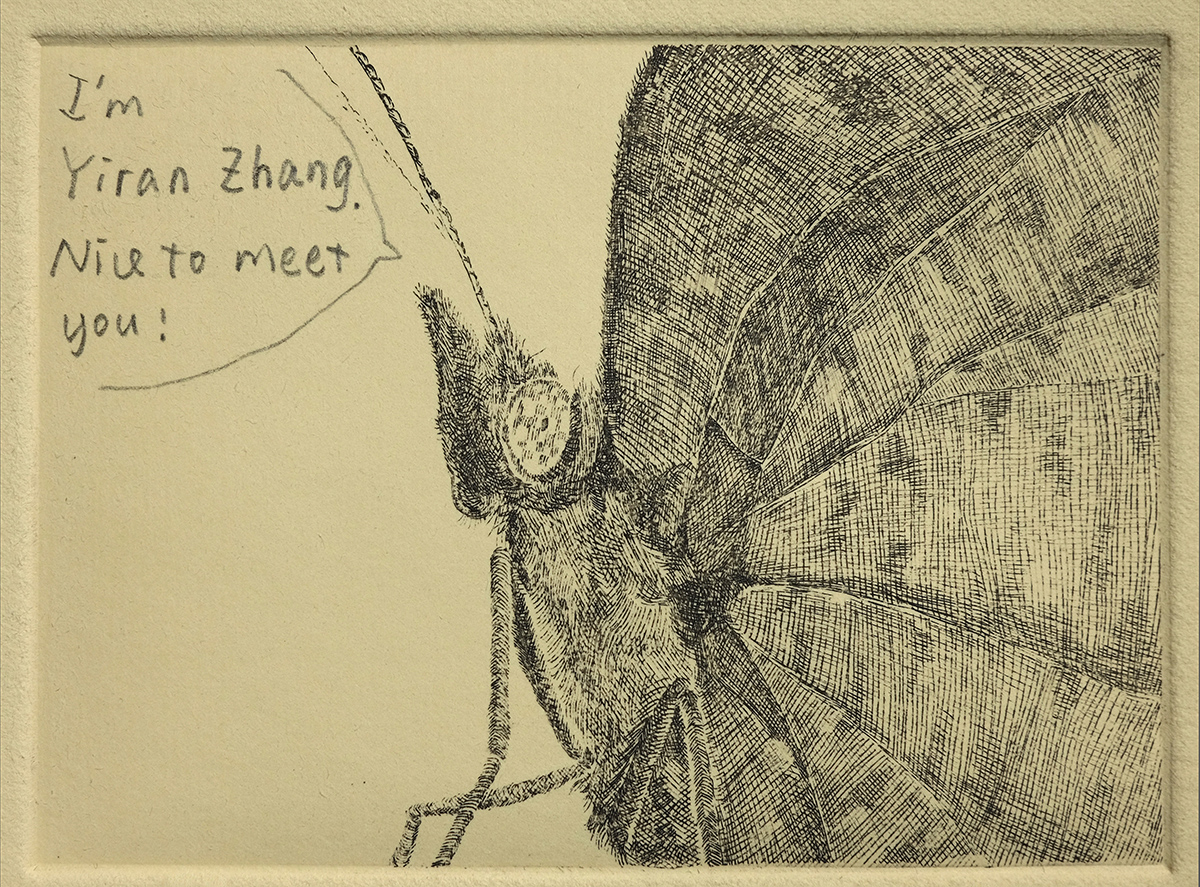
Ria Pazarlis-Stiles
From Downtown to Provincetown: AIDS and Queer Domestic Life in America’s Oldest Art Colony
Project summary:
This project unites research on queer domesticity, materiality, memory, and AIDS to examine the art colony of Provincetown, Massachusetts, in the 1970s and 80s. It focuses on snapshot photography and experimental film by Downtown New York artists holidaying in Provincetown (Nan Goldin, Peter Hujar, Mark Morrisroe, and Tseng Kwong Chi), disrupting ideas of the Downtown scene as purely ‘synonymous with [...] sex, drugs, rock and roll’ (Taylor, 2006). In examining work reminiscent of family photo albums or holiday souvenirs, the project will introduce narratives of queer domesticity and AIDS care, offering new perspectives to the Downtown scene.
Funded by AHRC via the Northern Bridge Consortium.
Qualifications: MA History of Art, The Courtauld Institute of Art (High Distinction) 2022-2023, BA History of Art, University of East Anglia (First Class Honours) 2013-2016
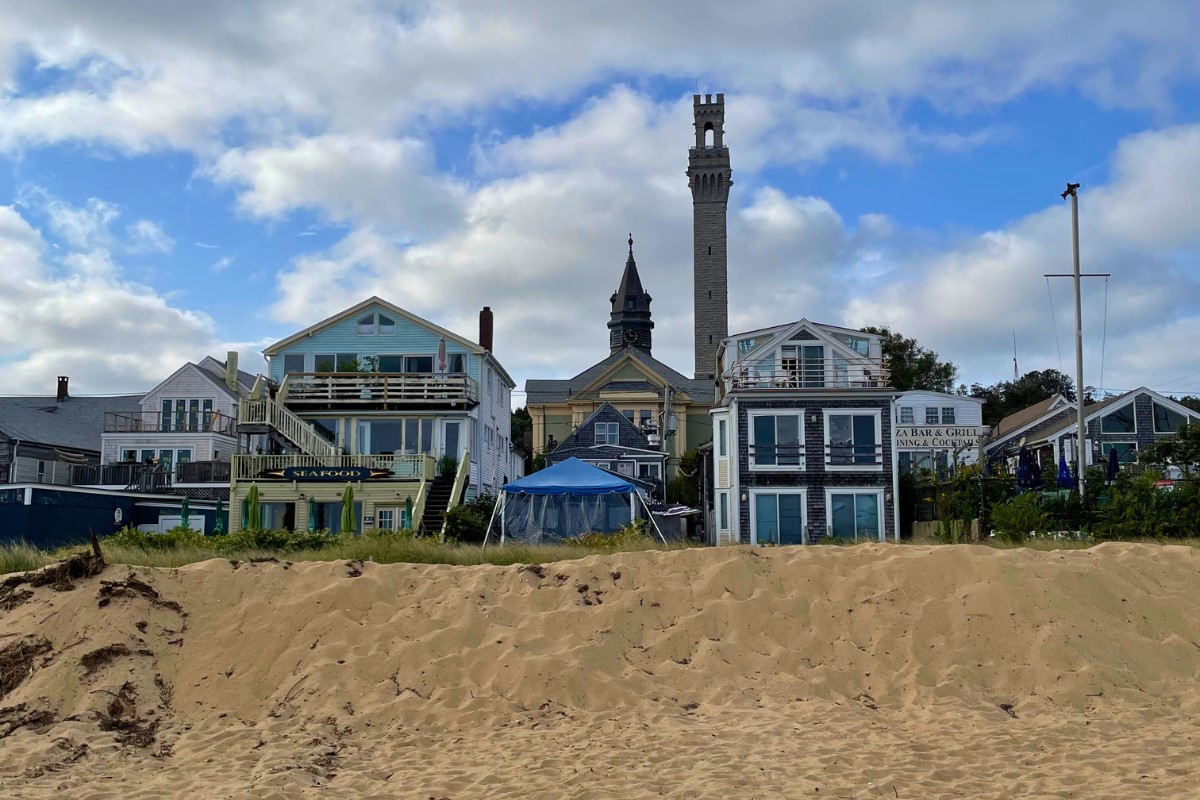
James Epps
With scattered red, green and brown: Reimagining Roman Mosaic Fragments in North-East England Collections through Contemporary Art Practice and Creative Writing
Using artistic practice, this project examines and reimagines mosaic fragments from across the Roman world now held in North East Museums (https://www.northeastmuseums.org.uk). Roman mosaics differentiate space, engage the eye, and draw the viewer through the architecture in which they are placed.
The project re-envisions and celebrates the fragments held in North-East collections to consider afresh the spatial and decorative function of pattern within architectural spaces. Through contemporary installations and creative writing this research project creatively expands upon the patterns and possibilities contained by these evocative yet overlooked mosaic fragments.
Researching how mosaics function in-situ, using existing documentation and site-visits to understand the devices at play, this project produces new creative knowledge of North East Museums’ fragments, revealing how they operate spatially, thus bringing new perspectives and engagement to this collection including un-exhibited items.
Using Roman examples of geometry and tessellation as a springboard, Epps will experiment with motifs and multiples e.g. flipping, rotating and expanding patterns from North East Museums’ collection. Developing installations that test visual devices, this research will generate new methodologies and knowledge for site-specific practice. The project will utilise creative writing from the position of an artist, treating text as another material that an artist can use. The mosaics are investigated as both artefacts and once-functional surfaces, thus enabling an anachronistic reimagining of these ancient patterns and spaces and present-day perspectives to form an original critical position.
This research project is funded by the by the Arts and Humanities Research Council.
Website: https://jamesepps.cargo.site/
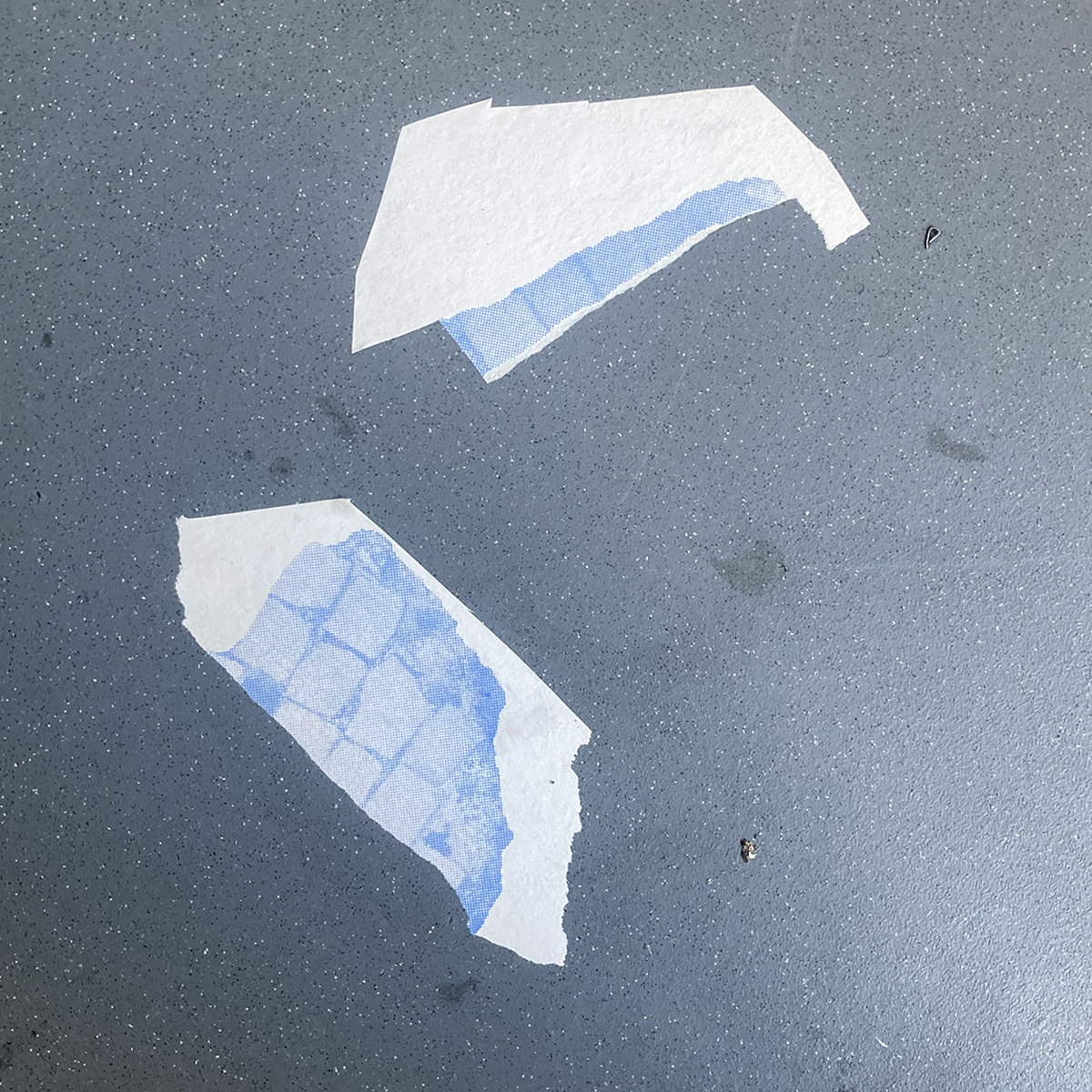
Alice Highet
Screen Time: how can multimedia arts practice imagine new technological modes of interaction, which prioritise care and wellbeing.
Summary of research:
I am interested in The Attention Economy, how Big Tech companies hijack our attention for economic gain, through everyday screen-based technology. This technology negates creative, self-generated, internal states of mind. I am asking if embodied and somatic practices (e.g. meditation, Somaesthetic Design) and theory (e.g. phenomenology, new materialism), can help inform the design of technology to address this. My research explores embodied knowledge, theorised by Donna Haraway as ‘Situated Knowledges,’ which includes feminist and non-human perspectives.
Through my creative practice, I am imagining a multi-sensory technology that encourages embodied experience, allowing space for creative internal states such as daydream and meditation. Some of the ways I do this are by creating multi-sensory installations, alongside participatory embodied smartphone filmmaking workshops.
This interdisciplinary research is across Fine Art, Digital Cultures and Open Lab.
Website: www.alicehighet.com
Instagram: @alicehighet
Hannah Morris
A question of emotion: how does emotion inform subjective narratives, individual expression, and aesthetics in a contemporary painting practice?
This research explores the concept of emotion in a work of art. Specifically, how that notion is developed by an artist, understood and managed by an artist, and read by an audience. The project will attempt to create understanding and perhaps help define what appears to be a new trend in painting today something I call, the ‘emotional narrative’.
Through a desire to better understand my own painting practice and my relationship to my subjective choices and emotional context in which I am working, I examine other contemporary artists working in this manner. These case studies include an examination and reflection upon my own work made during this research period. I attempt to reveal the intentions and mechanisms within this body of abstract based paintings in the broad context of contemporary painting, art history, and art criticism. This research will be asking the questions, does portraying emotion in a work have its own aesthetic tools? Are we still painting in the post-modern? What is the connection between the autobiographical and the emotional in a work of art?
Framing this project as being both of modernism and beyond modernism, the focus will be on contemporary painters working post 1975. Specifically, I will be using the modernist idea of working towards a sensation as a parallel to working towards emotions today. With an investigation into term the post-medium condition (Rosalind Kraus) to progress the idea of using emotion as a new form of medium working against modernism. This also raises the question of the audience in relation to the image, and how the inflection of emotion through gesture, touch and imagery influences an overall Affect for the viewer.
The term post-medium condition refers to the materiality and the context from which a work of art is being made; its reveals to us the ideologies behind our thinking on art and how it references a codex or language seeped in signifiers ingrained in a European tradition.
Michael Russo
Transatlantic Journeys: American Painting’s Postmodern Reflections on Europe
Michael’s research project looks at four different American artists to examine how American artists interacted with European culture and society in the late twentieth century. While R. B. Kitaj, Cy Twombly, Joan Mitchell, and Robert Rauschenberg each had unique experiences, analyzing them in tandem allows for a fuller picture of Euro-American relations over the period. Each chapter takes a particular thematic focus to discuss each artist: exile, heritage, pilgrimage, and dialogue. By focusing on these themes, this research would showcase historic models for American treatments of Europe and, hopefully, encourage positive relationships between the two regions in the future.
Maria Magalhaes Pacheco
Space-time and creation in arts: three practice-led experiments
Abstract: This study addresses site-specific sculptural practice and examines the tensions arising from the interactive relations between site and the artworks that exist within it. It applies the concept of 'anthropophagy' to re-signify traditional models of representation in order to re-organize them into new contexts through practice-led research into site-specificity. Anthropophagy, a metaphorical vision of the Brazilian indigenous people, utilises cannibalistic customs "in order to legitimate their critical, selective and metabolising appropriation of European artistic tendencies" (Mosqueira 2010: 12). The use of this concept in this thesis arises from the idea of simultaneously belonging to two geographically separated cultural universes: one individual (in my case, Brazilian) and another related to the centralised European/US cultural model of influence that dominates the art world.
The differences and intersections between these two universes provide a rich field for practice-led research into how artistic creation is affected by attitudes to space and time. In order to explore this, the thesis is divided into four chapters. The first develops a theoretical framework dealing with concepts of space and time and demonstrates how anthropophagy draws these concepts together. The next chapter examines walking in the UK as an art practice to expand the understanding of site-specific practice through the artworks of Richard Long and Hamish Fulton. The third chapter focuses on work, site and location in order to examine how anthropophagy can re-signify the idea of walking as related in Chapter two. The final chapter analyses site-specificity, drawing on my own practice-led research explored through three art projects implemented in Brazil and England. These projects develop ways to negotiate the complex relationship between art, place and temporal contexts, re-inscribing events within specific sites over time.
To build a methodology for the research, I developed three different projects and situations testing the spatial-temporal contexts of site. By using site-specific art practice I shape my arguments upon a creative practice ruled by concepts, materials and techniques. In my practice I have delineated some creative responses to the transformations of the contemporary world, weaving reflections between work/site/body as well as on my own perception regarding current 'temporalities'. The theoretical frameworks that inform this study range from postmodernism to globalisation theories in order to draw together work, site and location under the overarching concept of anthropophagy.
Maria is currently a Professor at the Visual Arts Department, Paraiba Federal University Brazil.
Jiun-Shian Lin
Applying sensory distortion devices in artistic production: practice-based studies of creating artefacts with perceptual devices which confuse artists' vision and kinesthesis.
When I was an art school student, I was trained to pursue the likeness of subjects in all my artworks. This practice-based research explores alternative forms of self-expression in art practice. The exploration starts by questioning the relationship between perceptual devices, artists’ perceptions and artistic production. Most perceptual devices are designed to enhance artists’ sensory capabilities and facilitate the creation of art. Their success is often based on enabling artists to achieve a likeness of the subject drawn or making the creation of artefacts easier. My research focuses on investigating the consequences and artistic potential of applying sensory distortion devices that confuse, mislead and distort artists’ vision and kinesthesis, increasing the difficulty of making art, and exploring the productive potential of such devices to engender new creative forms.
In this research three visual distortion devices and two kinaesthetic distortion devices are prototyped and used in experimental calligraphy, painting and drawing exercises. After analysing the artists’ experience of using these devices, the influence and artistic potential of applying them are examined. It is discovered that distorted vision and kinesthesis can greatly influence the making of art by disrupting habitual eye-hand coordination and control over producing artefacts. Besides which, the use of visual and kinaesthetic distortion devices can be a technique for new forms of artistic expression. It can also be an effective technique for creating serendipitous opportunities in the visual arts and a way of exploring and provoking reflection upon artistic methodologies. Consideration of the attributes of visual and kinaesthetic distortion devices and distorted perceptions during the process of prototyping can benefit the generation of ideas, methods of production and the contents of artworks. Some practical implications for creating art with visual and kinaesthetic distortion devices are also explored. They are discussed in relation to theories of human performance, such as flow theory, and attitudes toward the conflict between habitual and unfamiliar perceptual experience. Keeping an open and uncritical mind toward unfamiliarity, chaos and the accidents caused by distorted perceptions and reduced control of drawing instruments is suggested to working artists. Finally, this research contributes to art education by demonstrating a possible way of achieving self-exploration through art making.
Cath Keay
1000 Tides
Cath Keay’s doctoral project built on her previous, long-running work on bees and wax sculpture to investigate ways in which art and the natural world can interact, exploring dynamic natural processes that can influence the final form of a sculpture.
Keay’s sculptural works provide a basis for animal colonisation in natural environments (a wax architectural sculpture in a beehive; terracotta text sculptures in the sea); over time it is possible to investigate the way in which these animal forms adapt to and alter the artworks, creating beauty in nature’s response to human intervention. Her work highlights the role of nature as collaborator in the creation of the artistic product.
Her doctoral work involved three large terracotta word sculptures that have been placed in the sea underneath the pier at Blyth, to be colonised by barnacles, mussels and sea squirts. After this colonisation had taken place, and the original sculptures almost obliterated by sea life, they were transferred, still living, to tanks for exhibition. She also worked on a large terracotta rendition of a quote by Ruskin, colonised by as beautiful a range of sea life as possible.
Keay’s original work on bees and wax sculptures reflected on humans and bees as social creatures within the context of 1930s utopian architecture. By creating an art deco-style wax building and placing it in a hive as a starter structure for bees to use to build wax cells, it was possible to observe how human architecture and bee architecture could merge. Her PhD work referred to the vast number of organisms living in the sea that we know nothing about, and the difficulty of preserving sea life for study.
The words that Keay chose to place in the sea are ‘fecundity’, ‘feracity’ and ‘uberty’, all variations on the theme of fruitfulness, and the flowing italic form of the sculptures expresses this theme further. Through this project an interest in Victorian understandings of art and science also emerged: the use of Victorian tanks at the Newcastle University’s Dove marine laboratory resulted in her focussing on Ruskin, particularly his crossover interest in art and science and his negative response to Darwinism.
Cath Keay held a Norma Lipman Foundation Scholarship and was also sponsored by the Catherine Cookson Foundation. Link: The Dove Marine Laboratory
During her time as a student at Newcastle, Cath was awarded the Helen Chadwick Rome Fellowship.
Subsequent projects included:
2012 - Arts Council England & British Council - Artists International Development Fund for Culturia Residency to Berlin.
2013 - Denkmal Solo Exhibition, Galerie Lage Egal, Berlin. [http://www.lage-berlin.de/portfolio/denkmal-cath-keay-culturia-residency/](http://www.lage-berlin.de/portfolio/denkmal-cath-keay-culturia-residency/)
2013 - Middlesbrough Modern Beehives, Middlesbrough Institute of Modern Art (MIMA).
Parallels between two kinds of social animals inspired the Middlesbrough Modern Beehive project, commissioned by Rednile Projects. Cath constructed four beehives in the form of Modernist and Brutalist architecture from Middlesbrough and Teesside. These buildings are Steel House, Redcar, Kennedy Gardens, Billingham, and Melrose House and the former Dunning Road Police Station, Middlesbrough which was on the site where MIMA is built. Following the exhibition at MIMA, and again at Lingfield Point, Darlington, the hives were colonised with honeybees and subsequently maintained by local beekeepers across Teesside.
Cath’s work has subsequently been included in the following publications:
Scott, J. (2013) The Language of Mixed Media Sculpture. Marlborough: Crowood Press.
Hutton, S, Goldsworthy J. & Branthwaite M. (2012) Factory Nights: Discovering and Activating Spaces. Stoke on Trent: Rednile Projects
Ullrich, J. (2013) Apiculture and sculpture practice. Berlin: Neofelis Verlag
Horn, T. (2011) Beeconomy: What Women and Bees can teach us about Local Trade and the Global Market. Lexington: University of Kentucky. P140-142
Isobel Harbinson
Embodied Ecologies: A Corporeal Ecofeminist Approach to Contemporary Art
This thesis will examine the representation of the marginalised body within a selection of artworks created by women and gender nonconforming artists from the 1970s to the present day. Utilising ecofeminist theory, it will prioritise an analysis of the body as a site of resistance against forms of interconnected oppression under the capitalist-patriarchal system.
At a time in which scholars and curators alike are acknowledging the climate crisis must serve as fundamental context for all future work, an extensive application of ecofeminist theory to contemporary art is necessary to explore the potential for art to resist the interlinked issues of social injustice and environmental harm. A return to the body is a particularly necessary aspect of this work in light of the material turn in which scholars such as Stacy Alaimo (2008) have shown the importance of considering the ‘trans-corporeal’ permeability of human/nature divides.
This thesis will offer a reconsideration of early ecofeminist theory, art and curation within this context. It will argue that the preoccupation with the corporeal in this work had more nuanced motivations which included an acknowledgement of the importance of materiality to ecofeminist analysis.
Elisabetta Fabrizi
Elisabetta Fabrizi’s research at Newcastle University stems from her practice of Head of Exhibitions at the British Film Institute and of Curator at BALTIC, offering an analysis of the significance of curators’ creative work and their role in institutionally embedding the moving image at the centre of the contemporary art field.
Elisabetta’s curating and her reflections on creative practice have been recently included in a new book, ‘Artists Moving image in Britain since 1989’, published by Paul Mellon Foundation and Yale University Press to which she contributed an essay analysing her own curatorial work at the British Film Institute – describing the creative opportunities and challenges of curating a contemporary art programme for a gallery sited within a Film institution. This important and timely publication offers a critical appraisal and art historical survey of a period of great transformation for this area of creative practice; a book which aims at considering the practice of artists alongside that of curators who had an impact on the field in the period.
In the book Elisabetta reflected on how curatorial practice holds a central role in the network of forces shaping exhibition, collection and production making strategies, of which moving image is now an important part. Following her PhD research, she did this by referencing some of her commissions, including one with artists and Newcastle University Fine Art Professors Jane & Louise Wilson, who have also been acknowledged for their important contribution to the period with the inclusion of their text part of the 'Artists' section of the same publication.
Elisabetta also reflected on her work with practitioners whose work navigates between gallery and cinema auditorium, and the importance of curatorial practice in shaping the opportunities offered to them in terms of site, context and content: examples cited are John Akomfrah, Michael Snow, Apichatpong Weerasethakul and Iain Forsyth & Jane Pollard, whom she worked with in both their capacity of visual artists and mainstream filmmakers, including by offering them access to the BFI’s extensive Film Archive to create a new commission.
Through a more personal and practice-based outlook which she has developed while at Newcastle University, the text complements The BFI Gallery Book , a book she previously published (BFI, 2011). Both Artists Moving image in Britain since 1989, and The BFI Gallery Book are available from the Robinson Library.
Elisabetta also articulated some of the ideas stemming from her PhD as part of the Oslo Biennial; and in two reviews published by Art Monthly, ( https://www.artmonthly.co.uk/). She also discussed her research on art radio Resonance fm, in a panel comprising critic and broadcaster Morgan Quaintance (Art Monthly Talk show, https://www.resonancefm.com/).
John Maclean
The Open Council
John Maclean’s work as an artist and researcher focuses on the relationship between art and politics, specifically on the development of critical art strategies designed to harness the political potential within everyday experience in the context of neoliberalism. His work engages with improvisation, aesthetic resistance and non-oppositional critique and, using the practice of the ‘self institution’ he has developed a number of online art projects that attempt to reframe art practice through the aesthetic appropriation of an institutional form. These projects include the ‘Open Council’ a website paralleling Newcastle City Council and his current project, The War on Capitalism, which attempts to frame art practice in the ultra-antagonistic form of a ‘war’.
During his recently completed PhD research, John brought the fields of improvisation studies and critical art discourse together in a ground-breaking project in which academic and practice-led research was synthesized into a single method of self-institutional practice. Through this project, ‘The Open Council,’ John developed a particular method of self-institution to address many of the most pertinent questions in critical art discourse in the areas of aesthetics, authorship, institutional critique, socially engaged art practice and the potential of non-dialectical or non-oppositional critical art strategies.
This research highlighted numerous areas of correlation between improvisation studies and contemporary critical art discourse (particularly in the area of art and the social), and some more unlikely links between the critical practices of jazz musicians (working in the context of racial oppression) and contemporary anti-capitalist art projects - the work of Sun Ra and the Copenhagen Free University for example. Based on his research into improvisation John developed a unique method of improvisatory art practice that conceptualised the method of self-institution as an improvisatory process which perpetuates itself by responding to the impulses provided by the contemporary city environment. Through the Open Council project John’s research demonstrates how the artistic appropriation of an institutional identity can provide a framing device flexible enough to contextualise work/research from a variety of disciplines and which has the potential to merge with social movements at times of protest.
John's project was funded by the AHRC.
Ping-Yeh Li
Toward 21st century Wundermaschinen: a practice-based inquiry developing media archaeology as an artistic methodology.
This practice-based thesis aims to construct a practice framework in the field of new media art that can be multi-disciplinary, reflective and productive in nature, and has potential implications for the relationship of humans and machines in the 21st Century. The core focus of this research is on how a media archaeological exploration of Wundermaschinen promotes an approach to Media Art practice that engenders wonder and expands our vocabulary about wonder is. Building on reflections on creative projects Sensing Energies (2012) and Spirit Exposure (2012-2013), specific concerns emerged. It is argued that further practices of information visualisation move away from scientific and explanatory means, and otherwise explore how they are in line with similar developments in Media Art practice. It is then recommended to embrace a paleontological view on media development, and explore the hidden motives in practice of technology for observation. In other words, a media archaeological approach is adapted to excavate the family resemblance characteristics and unrealized dreams of Wundermaschinen.
A review of contemporary maker-culture also suggested that we go beyond the homogenisation of novelty in open source making and examine specific experimental aspects. To inform making activities thus conceived, a speculative framework of ‘21st Century Wundermaschinen’ is proposed: rarity and refined labour, information-oriented visual complexity, performance-like setting for specific sensuousness, embracing knowledge across disciplines, assembling multiple epochal technologies, and machinery of curiosity. This framework is then applied through five experimental projects conducted between 2013 and 2016 that each has been documented the developmental context, implementation, technical ii details and audience response. The results of this application are discussed and reflected to locate their characteristics of experience, aesthetic potential, and suitability for media research. This practice-based research makes the following contributions: (i) a design framework for new media practitioners and HCI designers, (ii) a method of utilizing maker tools that critically contextualise themselves to broader techno-historical context of technology, (iii) an aesthetic and analytic strategy expressed as a framework which re-examines contemporary human-machine relationships, and (iv) a set of provocative examples that reflects on, and provides practical examples for, a media archaeology as artistic methodology.
Alexia Mellor
Putting Wicked Problems in Their Place: Interrogating the Global through Participatory Art and Infrastructuring
In the context of growing concern for how to meet the United Nations Sustainable Development Goals and other challenge-led approaches, public engagement is deemed essential to addressing the complexity and uncertainty that these global issues present. However, this requires a consideration of how to best engage individuals, and how to make these issues relevant within local contexts. This research, therefore, interrogates how participatory artistic practice might serve to deconstruct global metanarratives of ‘wicked problems’ (Rittel and Webber, 1973) such as climate change to create a critical reflective space to examine the relevance of these issues within local contexts. To do this, this thesis adopts a practice-led approach, using three participatory works that address three central themes related to global metanarratives: place, situated:environments and participation. The research begins by establishing a framework for understanding metanarratives as spatially experienced within situated contexts. This framework draws together Massey’s (1991) definition of place as socially-constructed and the product of flows, with Soja’s Thirdspace (1996) in an effort to challenge the local-global binary and reveal the social imaginaries and situated knowledges that inform interpretations of place. Using Bourdieu’s habitus as the personal enactment of these imaginaries, the research argues for the need to create a context for individuals to discover their own narratives and entanglements in issues of concern, transforming from participants into active citizens. This requires a shift in how we think about participation, moving from project-based approaches to establishing long-term contexts, and recognising the variable roles that artists and participants play. This research, therefore, makes two principal contributions to the field: by applying an infrastructuring-inspired methodology drawn from Scandinavian traditions of Participatory Design, and through developing a unique toolset, it seeks to disrupt binary understandings of participatory art discourse by creating a context for ongoing participation and legacy of the works; secondly, on this basis, creating a useful platform to support the transformation from participant to active citizen. Taken together, these contributions suggest pathways towards engendering individuals and communities to better approach the wicked problem of climate change.
http://theses.ncl.ac.uk/jspui/handle/10443/4613
Website: Alexia Mellor • installation, new media, performance artist and curator
Sixian Chen
Integrating art into bodily interactions: exploring digital art in HCI design to foster somaesthetic experiences.
My interdisciplinary doctoral research of this thesis explored how interaction design – with a combination of digital art, body-centred practice and biophysical sensing technology – cultivates self-awareness and self-reflection to foster somaesthetic experiences in everyday walking. My research followed a Research through Design (RtD) approach to provide design artefacts as examples of research in the expanded territory of Somaesthetic Design, technology-enhanced body-centred practices and digital art applied in interaction design. Background research included a critical review of Affective Computing, the concept of somaesthetic experience, existing body-centred practices (e.g. mindfulness and deep listening), HCI designs for somaesthetic experiences, and interactive digital art applications (using biophysical data as input) to express bodily activities. In methodological terms the research could be summarized as a process of ‘making design theories’ (Redström, 2017) that draws upon a Research through Design (RtD) approach.
The whole research process could be described with a ‘bucket’ model in making design theories (Redström, 2017): identified initial design space as the initial ‘bucket’; derived the first design artefact ‘Ambient Walk’ as a ‘fact’ to represent the initial design space and the cause of transitioning, re-accenting process from mindfulness to ‘adding a sixth-sense’ (i.e. to extend the initial ‘bucket’); the making of second design artefact ‘Hearing the Hidden’ as a ‘fact’ to represent the re-accented research rationale in designing for somaesthetic experience by ‘adding a sixth sense’. I followed a qualitative approach to evaluate individual user feedbacks on enhancing somaesthetic experiences, the aspects to be considered in designing for experiences, and how my design process contributed to refining design for experiences. At the end of this thesis, I discuss the findings from the two practical projects regarding the somaesthetic experiences that have been provoked during users’ engagement with ‘Ambient Walk’ and ‘Hearing the Hidden’; the inclusion of bodily interactions with surroundings in somaesthetic design; the use of ‘provotypes’ in experience-centred design practices; and the benefit of integrating digital art into technology for body-centred practices.
Jane Dudman
Let's talk about the everyday: revealing ordinary life through performance.
Through practice-led research this thesis provides new insight into disregarded aspects of ordinary life. In particular it highlights the potential of improvisatory performance practice as a research methodology, which, whilst maintaining the ordinariness of the subject matter, reveals its nuanced value and extraordinary nature.
Interest in the everyday as a concept has had an academic resurgence in recent decades. As a sphere in which culture and politics coalesce it is inherently interdisciplinary and has been a focus for anthropology, political science, philosophy, geography, cultural studies and contemporary art. Arising from revolutionary Marxist ideals of social praxis and Lefebvre’s philosophical development of demotic cultural agency, the study of the everyday signals a concern with democratic inclusivity. When aligned with socially engaged art forms of the late 20th Century, through an ethnographic sensibility and an attention to the overlooked aspects of daily life, the everyday emerges as an artistic genre. This thesis provides a longitudinal scholarly and artistic synthesis that examines and refigures habitual domestic experience.
The work is underpinned by an understanding of the everyday encapsulated in Highmore’s phrase ‘the background hiss’ (2011:1), and a phenomenological description of first hand experience as both immanent and intentional. Three strands of practice each interrogate the everyday through performance, the spoken word and collaborative strategies. In a reflexive approach working with critical perspectives on philosophical, aesthetic and cultural theories, the thesis opens up a space to interrogate the invisible, inaudible plane of ordinary life, bringing discontinuous, unvoiced knowledge to the fore. The work contributes to the discourse on the everyday in several ways. Practice-led methodologies are expanded through the development of iterative and speculative performance making as research that critically inhabits and disrupts the extraordinary/mundane paradox of everyday life.
This is achieved through performance in, and of, the everyday, evidenced in collaborative diaristic audio and film making, which is then examined in live improvised one-woman performances. Secondly, the thesis reveals everyday experience through oblique examination of the spoken word. In studio composition and in performance, improvisatory sampling, iii repetition and replication connect to the distinctiveness of individual voices and lives. Finally the thesis underlines the importance of the interplay between the discursive and the experiential as a vital component in developing an understanding of the everyday. This thesis is significant in that it occupies the analytical interstices of everyday scholarship and complicates the association between the embodied nature of experience and its verbal expression. The research echoes and is drawn from the rhythms and practices of everyday life, bringing to the surface what is already extraordinary. Unique insights are produced through the visceral experience of performing the works, connecting subjectively with the participants’ words and images and making the hitherto indiscernible everyday available for scrutiny. In this way the research makes a valuable contribution to practice-led research in the arts and to the broader field of everyday life studies.
Toby P Lloyd
Time or money? The potential of participatory arts practice to challenge complex societal problems and imagine alternative futures
This thesis explores how participatory arts practice can engage issues of active citizenship, interrogate current relationships to work and inform understandings of a post-work society. To conduct the research, I used a practice-based approach which in this context manifested as a series of interactive exhibitions that were presented in a variety of public spaces. These interactive exhibitions posed open questions designed to provoke conversation while creating space and time for participants to engage in critical reflection outside of their daily routines.
We live in a climate where we work long hours in demanding jobs, which limits our ability to engage in activities outside of employment and our individual concerns. Universal Basic Income (UBI) could help to challenge to this situation by decoupling income from work and providing people with the financial security, enabling them to become active citizens. However, the policy is often viewed as utopian and therefore politically unachievable. Research suggests that this is caused by Capitalist Realism and time poverty which restricts people’s ability to imagine alternative ways of living and working, leading to a state of consciousness deflation.
My findings show that through its capacity for mimesis and role-play, participatory arts practice can counteract Capitalist Realism by creating a sense of defamiliarization and estrangement that enables a shift in perspective, allowing alternative visions of the future and new political imaginaries to emerge. My research demonstrated that participatory arts practice can create platforms for participants to interact with others in a process of dialogue and exchange that enables them to challenge personally held narratives and beliefs and to disentangle complex social and behavioural protocols. Through this process I was able to communicate ideas like UBI in a way that did not need to win a debate and could move beyond ideological barriers.
Website: tobyphipslloyd.co.uk
Twitter: @TobyPhipsLloyd
